The Project Gutenberg eBook of Zoological Illustrations, Volume 1
most other parts of the world at no cost and with almost no restrictions
whatsoever. You may copy it, give it away or re-use it under the terms
of the Project Gutenberg License included with this ebook or online
at www.gutenberg.org. If you are not located in the United States,
you will have to check the laws of the country where you are located
before using this eBook.
Title: Zoological Illustrations, Volume 1
Author: William Swainson
Release date: April 17, 2012 [eBook #39471]
Language: English
Credits: Produced by Chris Curnow, Keith Edkins and the Online
Distributed Proofreading Team at https://www.pgdp.net (This
file was produced from images generously made available
by The Internet Archive)
*** START OF THE PROJECT GUTENBERG EBOOK ZOOLOGICAL ILLUSTRATIONS, VOLUME 1 ***
Transcriber's note: | The listed Addenda & Corrigenda have been applied. Deleted sections are marked as ..., all corrections are highlighted like this, and the nature of the correction will appear when the mouse pointer is moved over the marked passage. The colourings of Plate 22 (Terias Elvina) and Plate 51 (Colias Pyrene) are wrong in the copy used—the insects's wings should be pale sulphur and white respectively but are portrayed as dull brown. |
Zoological Illustrations,
OR
ORIGINAL FIGURES AND DESCRIPTIONS
OF
NEW, RARE, OR INTERESTING
ANIMALS,
SELECTED CHIEFLY FROM THE CLASSES OF
Ornithology, Entomology, and Conchology,
AND ARRANGED ON THE PRINCIPLES OF
CUVIER AND OTHER MODERN ZOOLOGISTS.
BY
WILLIAM SWAINSON, F.R.S., F.L.S.,
MEMBER OF THE WERNERIAN SOCIETY OF EDINBURGH, ETC.
VOL. I.
London:
PRINTED BY R. AND A. TAYLOR, SHOE-LANE:
FOR BALDWIN, CRADOCK, AND JOY, PATERNOSTER-ROW;
AND W. WOOD, STRAND.
1820-1.
PREFACE.
The termination of the first volume of the Zoological Illustrations is
accomplished, and its contents will not only enable our readers to
discern the nature of the work, but likewise to form a judgement, on that
degree of improvement which we have introduced since its first
publication, and they may safely rely on the continuation being in no
respect inferior.
In commencing a work of this nature, we have had two principal objects
in view: the diffusion of original observations, which, while they might
further the ends of science, would also be interesting to the general
reader; and that of discouraging the publication of distorted figures
copied from old authors, by accustoming the public eye to original
designs and correct representations of natural objects. How far we may
have succeeded in this latter object, remains to be judged by others; we
are however satisfied with having made the attempt, and we hope that
abler pencils than our own, may engage in the prosecution of this most
desirable object; for it is only by the publication of original matter,
that a check can be given to the increasing number of compilations and
multiplied copies of "ill-shaped" figures, by which error is perpetuated,
and science retarded.
The only original work that has appeared in this country similar to
our own, is the Zoological Miscellany by Dr. Leach, which, as it was
discontinued after the third volume, it may be presumed was unsuccessful:
although little can be said of many of the figures in the early volumes,
those in the latter are much to be praised, and the whole are original;
the descriptions also abound with details highly interesting to the
scientific world, for which indeed the learned author principally
intended it; nevertheless it is a question, whether science in the end
would not have been equally, and perhaps more advanced, had this work
been more adapted to general readers. Instruction in these days of
refinement must be made easy, palatable, and enticing; the eye must be
pleased, while the understanding is improved, and Wisdom in her simple
dignified garb will often be deserted for Ignorance, decked out in the
glittering trappings of Folly.
The Naturalist's Miscellany conducted by Dr. Shaw, in its
miscellaneous nature also resembled the present work, and reached to the
extent of twenty-four volumes. What an invaluable fund of information
these might have contained had their contents been original!
Unfortunately, however, the exceptions are so few, that the whole may be
termed a loose compilation, the descriptions being mostly given in as few
words as possible, and the figures not only copied from wretched
representations found in old authors, but often coloured from their
descriptions only! It is indeed lamentable that the Author, whose talents
and abilities were unquestionable, should have exerted them so little,
and thus have descended to the rank of a voluminous compiler, for little
better can be said of the General Zoology, begun and continued under his
name: little original matter can there be found, excepting in the latter
volumes, yet even in these no notice whatever is taken of the immense
number of new species discovered in Africa by Le Vaillant, and long ago
published in the Oiseaux d'Afrique: the engravings also are in
like manner copied from old prints, enlarged or diminished as occasion
offers, without even a regard to the selection of the best. It may be as
well to observe in this place, that a great number of generic
distinctions have been made in the two last volumes; which, as they have
not been followed by any of the great and acknowledged Zoologists on the
Continent, and appear to us in many instances trivial and unnecessary,
will not be adopted in this work.
It will be unnecessary to point out with regard to the scientific
arrangement, that we have avowedly adopted the principles of the modern
classification; which the strict followers of Linnæus (in this country
alone) have so long, but so ineffectually opposed. The first has been
designated as the natural, and the other the artificial system; and,
without entering into a critical disquisition on these definitions, it
will be sufficient to observe, that by the Artificial System we bend
nature to conform to certain arbitrary principles, which we lay down and
to which we insist all her productions known and unknown will conform;
while in the Natural method, we endeavour by tracing her modifications,
to adapt our system to that which appears to regulate her operations. In
the one we give laws, in the other receive them; by the first we are
taught to believe that the highest attainment of the science, is that of
ascertaining the name of an object in our Museum, or of giving a new one;
we record it in our favourite system as a grammarian enters a new word in
his dictionary, and there the matter terminates. Where the artificial
system ends, the natural begins; for we then proceed to the investigation
of affinities founded on anatomical construction, economy, and geographic
distribution; our attention ceases to be confined to individuals, and
extends to large groups; general facts enable us to draw general
conclusions, till the mind begins faintly to discern a vast and mighty
plan, by which the zones of the earth are peopled by their own respective
races of animate beings; blending their confines unto each other with
divine harmony, beauty, and usefulness.
That these inquiries and results have had a most wonderful effect on
the natural sciences of late years, is abundantly evident. Geology, a
subject hardly thought of in this country a few years ago, is now found
to be a science of the first importance; with this, however, Conchology
is so intimately connected, that without a certain knowledge of it, the
geologist is frequently unable to prosecute inquiries of the most
interesting nature; and there is little doubt but that Botany has been
raised to the rank it now so justly holds, solely because its natural
system has been more generally studied and advocated in this country,
than that of any other branch of Natural History. In this science at
least, we possess a superiority which our continental neighbours cannot
dispute; and the name of Brown will be enrolled in the brightest page of
our philosophic inquirers.
That the prejudiced adherence to the strict Linnæan system, has been
the primary cause why Zoology has been more neglected with us than on the
Continent, will admit of little doubt; for by shutting the door to all
further improvement, it has impressed the generality of our countrymen
with an idea, that the highest object of the Naturalist was to label the
contents of a museum, and to arrange stuffed animals, like quaint
patterns of old china, in glass cases: to thinking minds no less than to
the vulgar, this idea has produced a feeling of contempt and ridicule,
and very few of those qualified by nature for accurate investigation and
philosophic reasoning, have been induced to make the science a study; and
thus from such an unfortunate prejudice, to use the words of a powerful
writer of the present day, "some future historian of the progress of
human knowledge, will have to state that England, till within the few
last years, stood still at the bottom of the steps where Linnæus had left
her; while her neighbours were advancing rapidly towards the entrance of
the temple[1]."
Finally—Linnæus to a comprehensive genius united indefatigable
industry; yet he could not see and study those innumerable productions
that have been discovered since his death: in proportion as our knowledge
of objects increases, so must our systems change, until the natural one
is fully developed; and the question simply comes to this, Whether the
Linnæan method should be upheld as a solitary exception to the mutability
of human wisdom.
The sun of truth must however finally prevail, and there is every
reason to think it has already broke, and will gradually disperse these
mists of prejudice. It is however much to be regretted, that our public
institutions are wholly inadequate to facilitate not only the advancement
of students, but the researches of those who are already engaged in
prosecuting their inquiries: in Scotland alone are founded any
Professorships of Natural History, and the establishment of our National
Museum (in this branch only) is confessedly difficult: materials for
study are more necessary in this science than any other; yet the public
Institutions and libraries of the metropolis, "rich and rare" in every
other department of knowledge, in most instances are deficient in this of
the most elementary books; setting aside those of illustration, which,
from being unavoidably expensive and within the reach of few purchasers,
are more particularly adapted for such general repositories of learning.
The protracted ill-health of its noble possessor, was the cause no doubt
of the Banksian magnificent library being left deficient in several of
the latest continental works; and that of the British Museum I have
reason to think is still more defective. To the honour however of the
keepers of the Bodleian and Radcliffe Libraries, it should be mentioned,
that no pains or expense have been spared to render them as perfect in
this branch as possible; and we have been told that the latter
particularly is the most magnificent in the kingdom.
We shall now as briefly as possible advert to the contents of this
volume.
In the Ornithological department the systems of Cuvier and Temminck
have mostly superseded all others: as a whole, we give a decided
preference to the latter, as being more natural, though it may be doubted
if the generic distinctions are not too few, while those of Cuvier are
too many: both however can be considered only as sketches, subject to
improvement—as natural affinities are more studied.
Regarding that part of our work which relates to Entomology, we have
given a decided preference to the Lepidoptera, for the simple reason that
this order has received less attention from all writers, concerning their
real characters and affinities, than any other; indeed they have been
most unaccountably neglected even by Latreille, the great founder of the
modern school: we have therefore thought it necessary to propose in this
department many new genera, and only have to regret that their
definitions could not be made more perfect without the destruction of the
specimens, frequently not our own, and which therefore was unattainable:
a more extended knowledge of the natural affinities existing in this
tribe, will alone confirm or annul the propriety of these
distinctions.
In Conchology many of the genera long established on the
Continent, but new to our own collectors, have been characterized and
illustrated, as well as specific distinctions defined between shells
hitherto considered as varieties; and here it must be observed that so
much latitude has been given to the meaning of the term variety,
that in its general acceptation its definition becomes impossible: our
own idea of its true meaning is, a shell possessing one or more
characters which are changeable and uncertain, and which consequently
will not serve as indications by which it may infallibly be distinguished
from all others; variety depends on local circumstances, and
affects the size, colour, and greater or less development of the same
modification of structure; a species is permanent, its structure
always the same though more or less developed, producing and perpetuating
its kind, and depending on formation, discernible in youth, and matured
in age: we cannot therefore comprehend the contradictory term of
permanent varieties in a state of nature (though such occur in
domesticated animals), which some authors have used, and which has led
to, in many instances, the most erroneous conclusions.
It is lamentable to see the opposition which is still made by our own
writers against all the modern improvements; yet although Linnæan
Introductions to Conchology are constantly issuing from the press, the
desire of being acquainted with a more natural and intelligible
classification has already appeared; and as we are frequently questioned
on the subject, we cannot in this place do better than refer the young
student to the valuable article on Conchology contained in the late
supplement to the Encyclopedia Britannica, the perusal of which
will convey more solid information, and less perplexity, than all the
Introductions our booksellers can boast of.
With respect to the quotations or synonyms, it should be observed that
we have in most instances limited them only to original works, all
doubtful ones have been rejected, and such only given as have been
actually consulted; indeed to this latter cause must be attributed the
occasional omission of some, existing in books we had not the immediate
power of consulting; our own library is not small; but the difficulty and
expense of procuring all the new continental publications, and the
impossibility of meeting with them at our public libraries[2], may have sometimes led us into error,
and unintentionally to have passed over the discoveries of others.
With the few additions contained in the Appendix we shall now
conclude; trusting that in the remarks drawn from us by the present state
of the science in this country, our zeal for truth will not give us an
appearance of want of candour or of vanity. The truth of our remarks on
the labours of others, every one at all acquainted with the subject can
inquire into, and either acknowledge or disprove: we neither deprecate
nor despise criticism: an author who presumes to instruct others, should
have his pretensions publicly canvassed, his merits admitted, or his
deficiency exposed; no one is more sensible than we are that our own
pretensions chiefly consist in having set an example for others more able
to follow: and if we have in any way advocated the cause of truth and
science, our object will be attained, and we shall then gladly retire in
the shade.
London,
Sept. 15, 1821.
LIST OF BOOKS REFERRED TO.
Bruguire, Encycl. Meth. Histoire Naturelle des Vers, par M.
Bruguire, 1 vol. 4to. and 4 vols. of Plates, forming part 10, 19, 21, 23,
of the "Encyclopedie Méthodique." Paris, 1789-1792.Bloch. Histoire Naturelle des Poissons, en 6 parties, 8vo.
Berlin, 1796.Cramer. Papillons Exotiques, 4 vols. 4to. Amsterdam,
1779-1782.Cuvier. Le Règne Animal, 4 vols. 8vo. Paris, 1817.
Chemnitz, Martini. Neus Systematisches Conchylein Cabinet, 11
vols. Nurnburg, 1781-1795.Dill. A Descriptive Catalogue of Recent Shells. By F. W.
Dillwyn, 2 vols. 8vo. London, 1817.Edwards. A Natural History of uncommon Birds, &c.; and
Gleanings of Natural History. By G. Edwards, 7 vols. 4to. 1763,
&c.Fab. Ent. Syst. Entomologia Systematica, emendata et aucta. J.
C. Fabricius, 4 vols. 4to. Hafnia, 1792-1794.Gen. Zool. General Zoology, commenced by Dr. Shaw, and
continued by Mr. Stevens, 11 vols. 8vo. to 1819.Gmelin Linn. Syst. Nat. C. Linné Systema Naturæ. Cura J. F.
Gmelin. Lipsiæ, 1788-1793.Godart in Encycl. Method. Encyclopedie Méthodique, t. 9. p. 1.
1819.Gualtieri. Index Testarum Conchyliorum quæ adservantur in Musæo
N. Gualtieri. Florentiæ, 1742.Illiger. Prod. Systematis Mammalium et Avium, 8vo. Berolini,
1811.Knorr. Les Delices des Yeux et de l'Esprit, 6 P., 4to. Nuremb.
1760, &c.Klein Hist. Pisc. Historiæ Nat. Piscium promovendæ Missus, 6,
4to. Dantzic, 1740-49.Linn. Syst. Nat. See Gmelin.
Linn. Trans. Transactions of the Linnean Society of London, 13
vols. 4to. 1791-1821.Lister. M. Lister Historia Conchyliorum, folio. Oxonii,
1770.Lamarck Syst. Hist. Nat. des Animaux sans Vertèbres. Par le
Chevalier de Lamarck, 6 vols. 8vo. Paris, 1815-1819.—— Anal. Mus. Annales du Museum d'Histoire
Naturelle de Paris, 4to. 1802-1821.Lath. Synop. Suppl. A General Synopsis of Birds. By Dr. J.
Latham, 3 vols, and 2 Supplements, 4to. London, 1782, &c.—— Index Ornith. Index Ornithologicus, 2 vols. 4to.
London, 1790.Martyn Univ. Conch. The Universal Conchologist. By T. Martyn, 4
vols. 4to. London, 1784, &c.Martini. See Chemnitz.
Pennant. British Zoology. By T. Pennant, 4 vols. 8vo. London,
1812.Risso Icth. Ichtyologie de Nice, 1 vol. 8vo. Paris, 1810.
Rumph. Thesâurium Imaginum Piscium, &c., folio. Hagæ,
1739.Seba. Albertus Seba Rerum Naturalium Thesauri, 4 vols. folio.
Amsterdam, 1734-1765.Say. Description of the Land and Fresh-water Shells of the
United States. By Thomas Say. Philadelphia, 1819.Shaw in Gen. Zool. See General Zoology.
Temminck Pig. et Gall. Histoire Naturelle Générale des Pigeons
et des Gallinaces. Par C. J. Temminck, 2 vols. 8vo. Amst. 1813.—— Manuel. Manuel d'Ornithologie, 2d edit., 2 vols.
8vo. 1820.Le Vaill. Hist. Nat. des Toucans et des Barbus, folio. Paris,
1806.—— Hist. Nat. des Perroquets, 2 vols. folio. Paris,
1801.White's Voyage. Journal of a Voyage to N. S. Wales, 4to. Lond.
1790.
Pl. 1

PSITTACUS Cayennensis.
Cayenne gold-winged Parakeet.
Generic Character.
Rostrum breve, crassum, validissimum, ad basin cute tectum;
mandibulâ superiore aduncâ; inferiore sub-recurvatâ, breviore. Nares
rotundæ, nudæ, fermè verticales. Pedes scansorii.Bill short, thick, very strong, covered at the base by a cere; upper
mandible sharply hooked; under mandible obtuse, curving upwards, and much
shorter. Nostrils round, naked, nearly vertical. Feet scansorial.
Specific Character.
P. viridis, alis spuriis aurantiis, remigibus exterioribus basi
cæruleis, caudâ brevi cuneatâ.Green Parakeet, with the spurious wings golden-orange: outer quills
blue at their base. Tail short, wedged.Le Perruche à tache souci. Le Vaill. pl. 58, 59. p.
169.
We only thoroughly identified this beautiful little bird, by an
inspection of the costly work of Le Vaillant on this family, in the
Banksian Library: for the description of the orange-winged Parakeet of
Dr. Latham is not applicable; and Dr. Shaw has persisted in the old error
of considering this species a variety of the Toui Parakeet, although the
question had been put at rest by the original description and sound
reasons of Le Vaillant. There is a wide difference between naturalists
who compile, and form their theories from books, and those who study
nature, and think for themselves; and nothing will result from the first
but mischief to the science, and perplexity to the student.
Our figure is from a specimen brought from Demerara by C. Edmonston,
Esq.; another is in the possession of A. MacLeay, Esq. Though rare in our
cabinets, M. Le Vaillant says it is common in Cayenne. He has given a
beautiful figure of the female, which is entirely green.
Total length six inches. Plumage above entirely green, beneath paler
and inclining to yellow; just under the lower mandible is a small
snuff-coloured spot, and a very narrow line of the same in front just
above the nostrils; the quills dark-green, the greater ones on their
outside base are blue, with which the head is also tinged. The spurious
wings are entirely of a rich and clear orange. Inner wing-covers green.
Quills inside greenish-blue, except on each side the shafts, where there
is a line of black. Tail short, cuneated, hardly projecting an inch
beyond the wings, both above and below green: the interior margin
dirty-yellow, the feathers pointed. Bill and legs flesh-colour.
Pl. 2
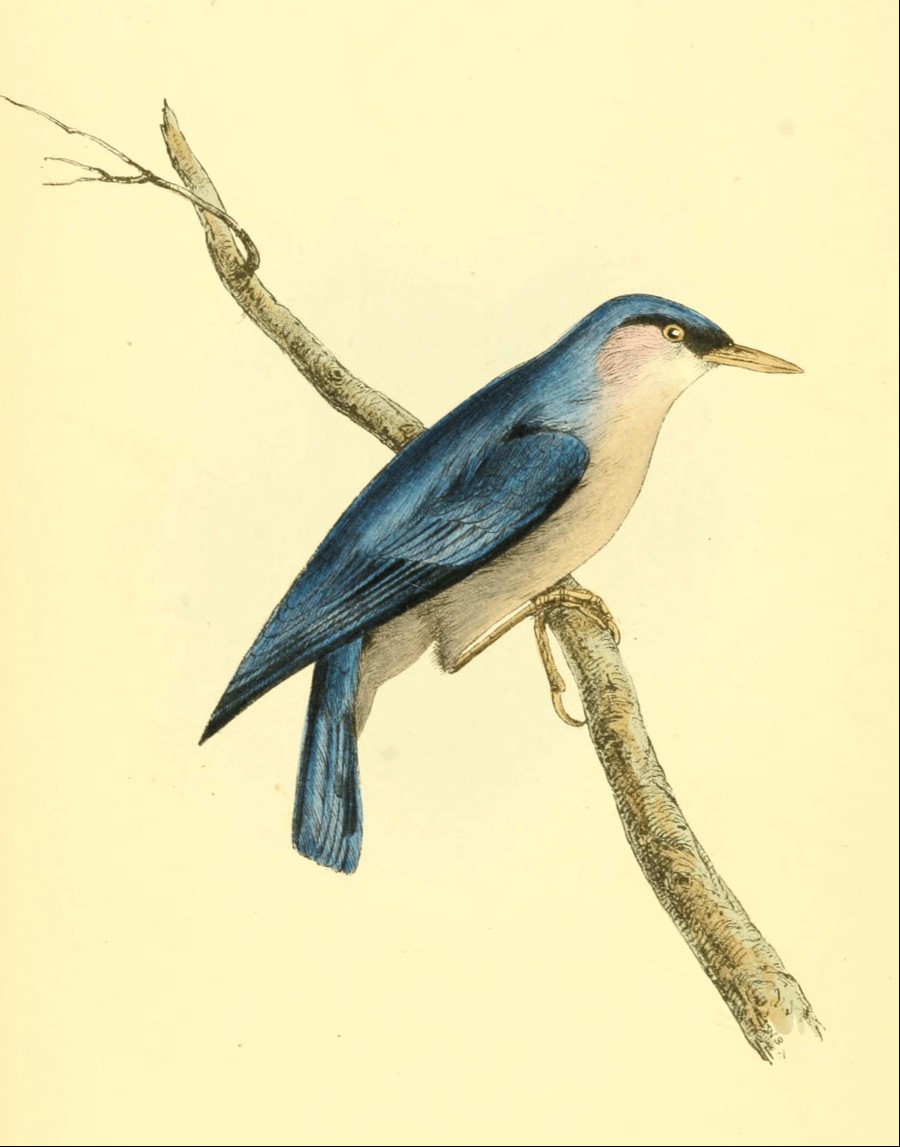
SITTA frontalis.
Blue Nuthatch.
Generic Character.
Rostrum rectissimum, acutum, compressum; utroque mandibulo ad
apicem æque inclinato; apice integro cuneo compresso simili. Nares
basales, ovales, apertæ, plumis setaceis incumbentibus extrinsecus tectæ. Pedes tribus digitis
anticis; uno postico; digitus interior minimus; exterior ad basin medio connexus; hallux productus
validus. Ungues compressissimi; antici subæquales; posticus maximus. Cauda brevis, rectricibus duodecim
subæqualibus.
Typus Genericus S. Europæa.
Bill very straight, sharp-pointed, compressed; both mandibles equally
inclining to the tip, which is entire, and resembles a compressed wedge.
Nostrils basal, oval, open, covered externally with incumbent setaceous
feathers. Feet with three toes forward and one backward; inner toe very
small; outer toe connected to the middle at its base; hind toe
lengthened, strong. Claws much compressed; anterior nearly equal,
posterior largest. Tail short, of twelve nearly equal feathers.
Generic Type Sitta Europæa.
Specific Character.
S. supra cærulea; supercilio, fronte, et remigibus lateralibus in
medio nigris; subtus cinereo-fusca, auribus lilacinis, mento albo.Nuthatch, above blue: line above the eye, front, and middle of the
lateral tail-feathers black; beneath cinereous brown, ears lilac, chin
white....
The present species is one of the many interesting birds collected in
Java by my friend Dr. Horsfield: it was not, however, until I had
described and engraved another specimen, sent to Sir J. Banks from
Ceylon, that I discovered the species had already been included in the
Doctor's account of the birds of Java, presented to the Linnæan Society,
where he has described it under the name of Orthorynchus
frontalis.
The specific name of its first describer is of course retained: with
respect, however, to its generic situation, I must be allowed to dissent
from considering it as a distinct genus, merely from the prolongation of
the hinder toe being somewhat more developed than in Sitta Europæa
and Carolinensis, both which birds are now before me, and which in
themselves differ in the relative proportion of this part: thus in S.
Carolinensis the hind toe and claw is two-tenths of an inch shorter
than the leg; in S. Europæa it is one-tenth shorter; and in the
present species it just exceeds that of the leg: in every other respect
not the slightest difference I apprehend will be observed ....
Total length five inches. Size of the European Nuthatch. Bill, from
the angle of the mouth to the tip, eight lines; front of the head
velvet-black, continued in a stripe of the same colour over the eye, and
terminating above the ear feathers: the upper plumage is of a rich blue,
more brilliant on the head, and paler on the front, and external margins
of the quills. Spurious wings and lesser quills black margined with blue.
Inner wing-covers deep black; the under plumage is a light-brown,
changing to lilac on the ears and sides of the neck, and tinged with
cinereous on the flanks and vent: the chin is white; tail even, the two
middle feathers blue, the rest more or less black, having the external
margins and tips blue. The outer quill of the wings is short, the second
and third longest and equal, the fourth rather less; the hind toe with
the claw, measures one inch in a straight line.
Pl. 3
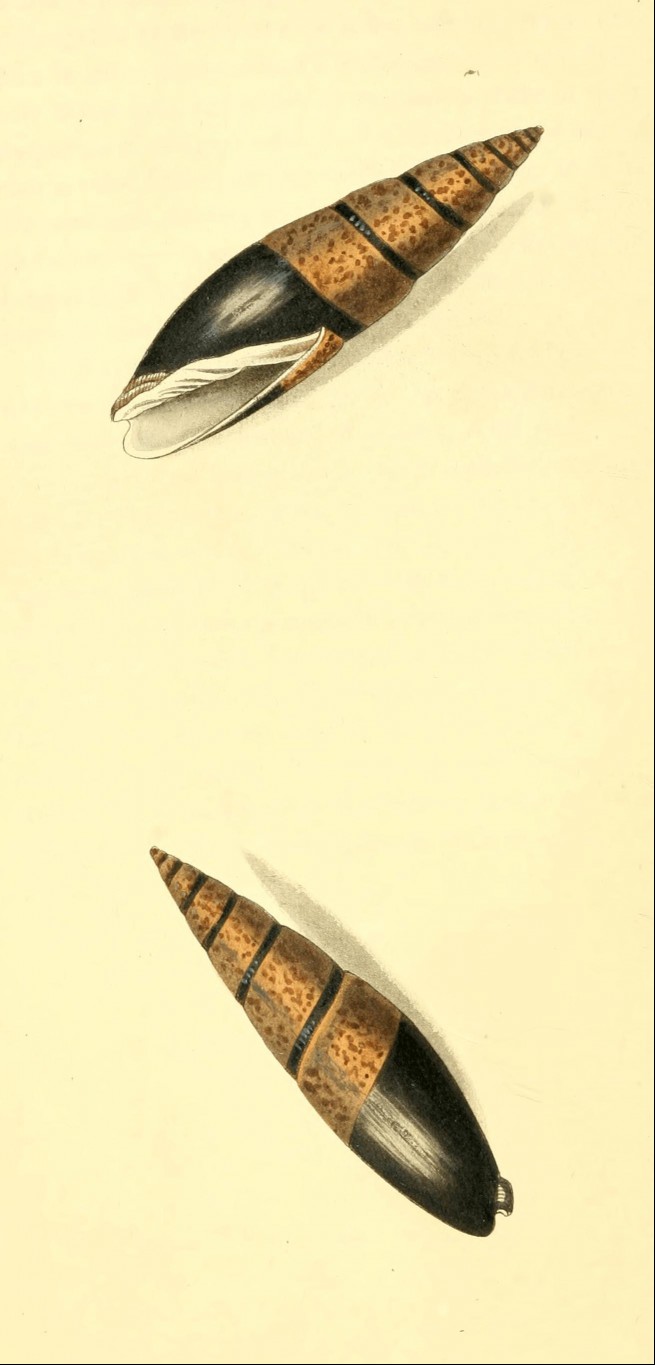
MITRA zonata.
Zoned Mitre.
Generic Character.
Testa inæqualiter fusiformis, spirâ productâ attenuatâ, labio
exteriore intus edentulo. Columella plicata.Shell unequally fusiform. Spire lengthened, attenuated. Outer lip
simple, not toothed within. Columella plaited.
Specific Character.
M. epidermide luteâ, fulvo-marmoratâ, anfractibus infernè basi
nigris, columellâ quinque-plicatâ. Linn. Trans. xii. p. 338.Mitre, with the epidermis marbled with brownish-yellow; volutions at
their base black; columella five-plaited.Mitra zonata. Marryat in Linn. Trans. vol. xii. pl. 10.
fig. 1. 2.
This unique and beautiful Mitre has been already described by Captain
Marryat in the Linnæan Transactions: the figures, however, are
uncoloured, and give a very indifferent idea of the graceful symmetry of
its form. My friend Dr. Leach, with his usual liberality, permitted me to
draw the accompanying figure of it at the British Museum, where it is now
deposited.
It appears to have been taken near Nice in the Mediterranean, adhering
to a sounding-line, in very deep water; a very singular locality, since
nearly all the Mitres have generally been supposed to inhabit the
tropical seas, or at least far from the coasts of Europe. It should,
however, be remarked, that Cypræa lurida, an Asiatic shell, I have
found on the shores of Greece: and C. Ulysses, in his travels in the
kingdom of Naples, enumerates several shells as inhabiting the warm
shores of the Tarentine Bay, which are generally known only as natives of
the Red Sea and Indian Ocean. These facts, with many others, prove the
physical distribution of Molluscæ to be less decidedly marked than
almost any other class of animals.
This genus is included with that of Voluta by Linnæus and our
own writers, although long ago justly separated by the continental
zoologists.
Pl. 4
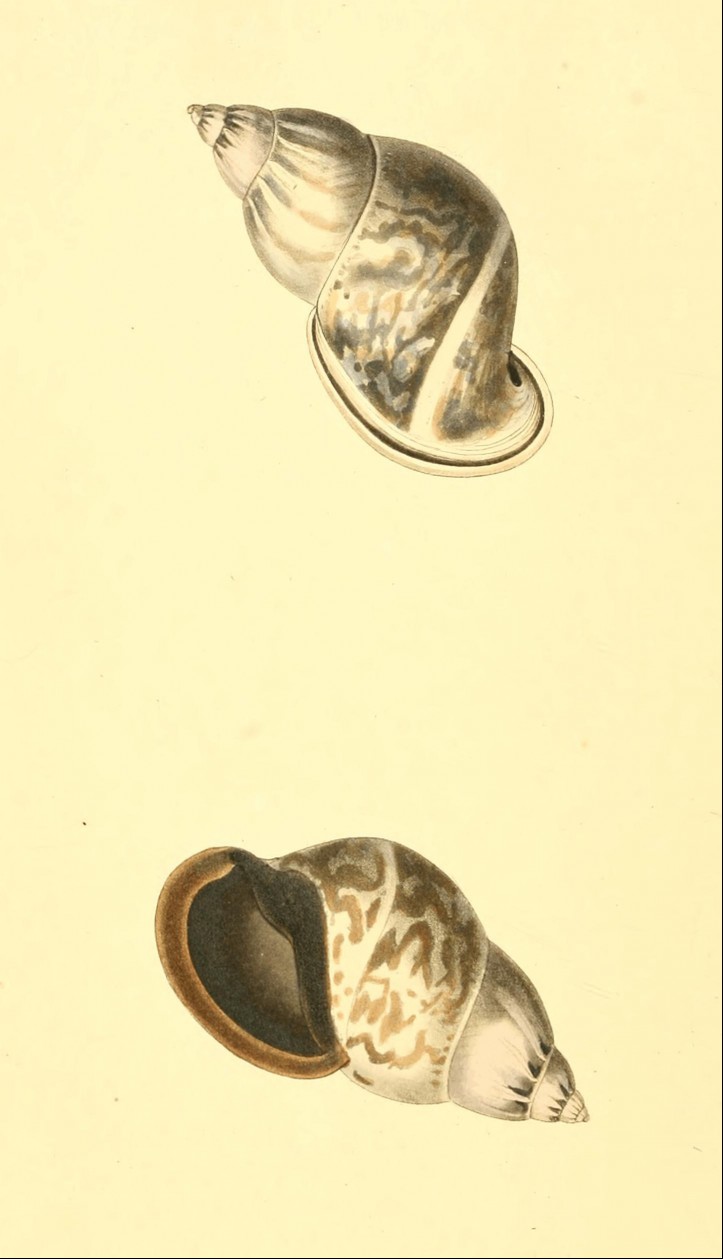
BULIMUS melastomus.
Blackmouthed Bulimus.
Generic Character.
Testa ovalis, vel oblongo-ovalis. Spira elevata. Os integrum,
sub-ovale. Columella lævis, simplex. Labium externum crassum, reflexum.
Internum ultra medium cavo-inflexum. Operculum nullum.Shell oval or oblong-oval. Spire elevated. Mouth entire, sub-oval.
Column smooth, simple. Exterior lip thick, reflected. Interior lip beyond
the middle inflected, and hollowed beneath. Operculum none.
Specific Character.
B. testâ oblongo-ovatâ, albâ, cinereo marmoratâ, spiræ anfractibus
longitudinaliter plicatis, labio exteriore complanato; aperturâ
nigrâ.Shell oblong-ovate, white, marbled with cinereous. Spiral whorls
longitudinally plaited. Outer lip flattened; aperture black.
The genus Bulimus was long ago formed by Scopoli out of the
heterogeneous mixture of shells thrown together in the Linnæan genus
Helix[3], &c.: it
comprehends some of the larger and most beautiful of the exotic land
shells, among which the present species will stand conspicuous both in
beauty of colouring and excessive rarity. While travelling among the
forests of Brazil, in the province of Bahia, I found the shell here
figured one morning on the leaves of a Solanum. I not only
searched myself, but promised as a reward to any of my Indians who would
bring me another, a two-bladed Birmingham knife!—the greatest
temptation they could have!—but in vain; for I never saw another
before or since.
There are many peculiar characters presented in this species
independent of its colour: the spiral whorls are strongly plaited
longitudinally about half their length, and marked very slightly (but
sufficiently distinct) with several oblique indented striæ; the principal
whorl has a row of indented and unequal sulcations near the suture, and a
slight appearance of elevation along the white transverse band; the outer
lip is thick, broad, and flattened beneath; but the margin is reflected
back, and forms a prominent rim on the upper surface. The shell, when
viewed closely, appears rough with minute scale-like elevations, very
much resembling shagreen.
Pl. 5

COLIAS Statira.
Generic Character.
Palpi breves, curvati, compressi ad linguam, squamis dense tecti.
Articulis tribus; primo longissimo, ad basin curvato, ultrà erecto;
secundo erecto, brevi; tertio minimo, proclivi; apice nudo, obtuso.
Antennæ breves, cylindraceæ, ad apicem nudum et abruptè truncatum sensim incrassatæ. Alæ anteriores trigonæ. Abdomen
maris, ultimo articulo acuto, et subtùs tenui unco incurvato; valvis
magnis, attenuatis, aduncis.
Typus Genericus Colias Ebule.
Palpi short, curved, compressed on the tongue, thickly covered with
scales. Articulations three; the first very long, curved at the base,
erect beyond; the second erect, short; the third minute, inclining
forward; the tip naked, obtuse. Antennæ short, cylindric, gradually
thickening to their tip, which is naked and abruptly truncate. Anterior
wings trigonal. Abdomen of the male with the last joint pointed, and a
slender incurved hook beneath; the valves large, attenuated and
hooked.
Generic Type Colias Ebule.
Specific Character.
C. alis dilutè flavis, vel fulvis; anticis suprà, puncto medio
margineque extimo, nigris; subtùs ferrugineis; posticis subtùs, singulis
duobus niveis punctis inæqualibus; palpis productis.Wings diluted yellow or fulvous; anterior with a black border and
central dot, which beneath is ferrugineous; posterior beneath, each with
two unequal snowy spots; palpi lengthened.—Female.Papilio Statira. Cramer, pl. cxx. fig. C. D.
The present insect is selected to illustrate a very elegant family of
Butterflies, whose predominant tints are composed of orange, yellow, and
white, variously blended and disposed in a greater or less degree
throughout all the species. The generic characters above given will
distinguish them as peculiar to the tropics, and principally those of
South America; one or two species only being found in Africa, and five or
six inhabiting India.
I have no doubt this is the Pap. Statira of Cramer; it is found
only in Brazil, and has been erroneously considered by Godart and
Latreille as a variety of C. Jugurthina, an Indian insect, and
which in fact is not in itself a species, being no other than the female
of C. Alcmeone, as an attentive examination of a vast number of
both, collected in Java by Dr. Horsfield, enabled me to ascertain.
The extraordinary prolongation of the last joint of the palpi, and the
white borderless spots beneath, which are never silvered, will
distinguish this species through all the variations; in the ground colour
of its wings, which in no two specimens are exactly alike, and one before
me is nearly white; the lesser snowy dot is sometimes very obscure, and
often wanting; but the prolongation of the palpi is even expressed in
Cramer's figure above quoted.
I have examined about a dozen specimens, mostly captured by myself,
and all have been females; and I strongly suspect future and more decided
observations will prove C. Evadne to be the other sex: it has the
palpi lengthened, though in a less degree; and the articulations of the
antennæ in both insects will be found somewhat thickened at their
termination when viewed under a magnifier, a peculiarity I have seen in
no other species; and although I have examined near thirty specimens of
C. Evadne, they have invariably proved to be males.
The palpi in this insect will be found at variance with the generic
character now given; a striking proof that in a natural system no single
part can be taken as an unerring criterion for generic distinction,
without making it eventually an artificial one. The Colias Drya of
Fabricius has the same formation of palpi, but is a totally different
insect.
Pl. 6

COLIAS Leachiana.
Leachian Colias.
Generic Character.—See Pl. 5.
Specific Character.
C. alis subrotundatis, integris, virescenti-albidis, anticis supra
fulvis, margine punctoque medio nigris, singulis subtus maculâ centrali
ferrugineâ. Encycl. Method.(Male) wings slightly rounded, entire, greenish white; anterior pair
above orange, at their tips, margin, and central dot black: each pair
beneath with a central ferrugineous spot. Female ——?C. Leachiana. Godart in Encycl. Method. vol. ix. p. 91.
In size this insect is the largest of the genus yet discovered; it was
first noticed by Godart, who has given it the name of my learned and
valued friend, Dr. W. E. Leach, of the British Museum, whose talents are
too well known to need any eulogium in this place.
It appears to inhabit both the northern and southern extremities of
Brazil; for I have seen it in a box sent from Parà, and my specimens were
captured in Minas Geraes by my friend Dr. Langsdorff. It is, however, a
rare species; for I have only seen seven or eight specimens, and they
were all males: the female, when found, will probably differ as
remarkably as in most of this genus.
The opaque spot on the inferior wings above is very large; but the
tuft of hair corresponding beneath the superior wings, is entirely
wanting. It should be likewise observed, that although this insect in
every outward respect resembles a genuine Colias (the type of
which may be C. Ebule), it differs very materially in the terminal
appendages of the abdomen; the last joint being the shortest, and
scarcely pointed; and the hook, instead of being concealed beneath this
segment, is exserted beyond it, and met by two others, one at the base of
each lateral valve: these valves are also much shorter, ovate, and not
attenuated, although ending in an incurved hook. In the present ignorance
in which a true knowledge of the Lepidoptera is involved, it is
impossible to say how far these dissimilarities may point out natural
groups; it is therefore of the highest importance to the science such
facts should be noticed.
Pl. 7
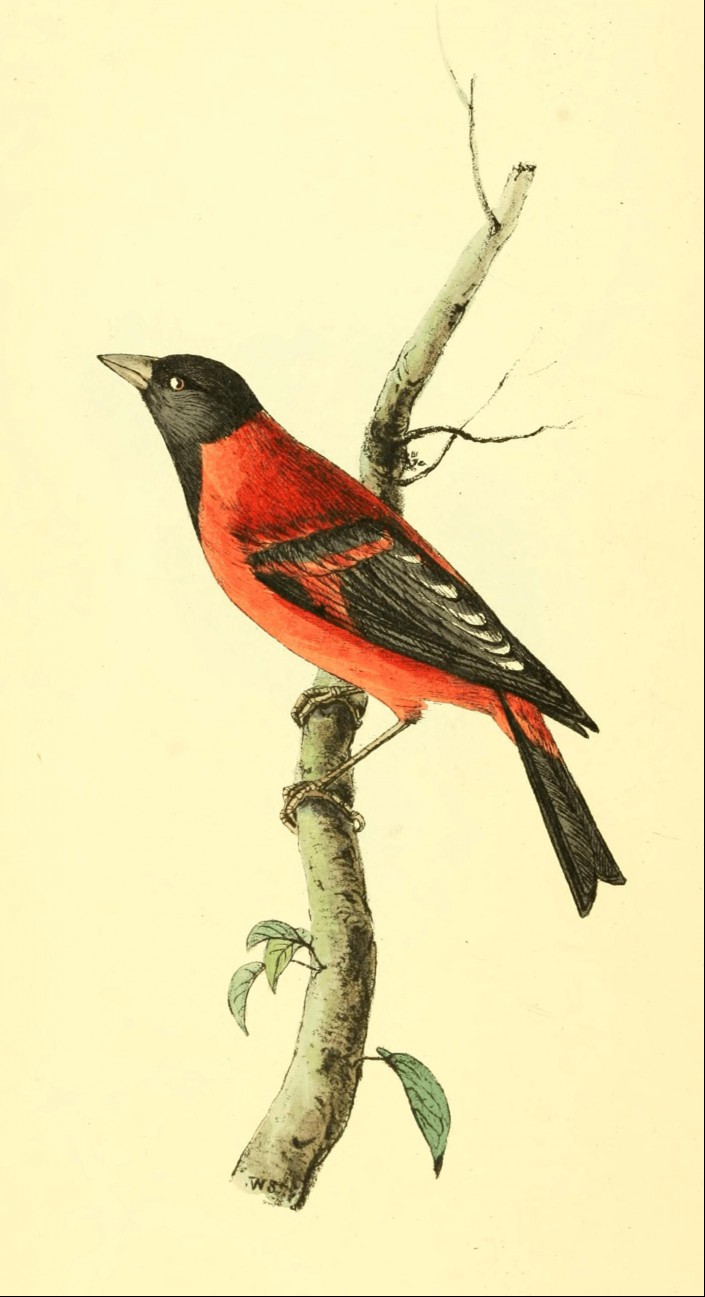
CARDUELIS cucullata.
Hooded Seed-eater.
Generic Character.
Rostrum breve, validum, conicum, rectissimum; mandibulis
subæqualibus; apice immarginato, recto, acuto; mandibulâ superiore
culmine convexâ; inferiore basi marginis angulatâ, utrinque subtusque convexâ.
Typus Genericus Fringilla Canaria. Lath., &c.
Bill short, stout, very conic, without any curvature above; both
mandibles nearly equal, the tip entire, straight and sharp; upper
mandible convex above: lower one at the base of the margin with an obtuse
angle, the sides and under part convex.
Generic Type Fringilla Canaria. Latham, &c.
Specific Character.
C. aurantia: capite, gutture, fasciâ trans tectrices,
remigibus caudâque nigris; remigibus primoribus basi obliquè aurantio
fasciatis.Orange: head, front of the neck, bar across the wing-covers, quills
and tail black; greater quills at their base obliquely barred with
orange.
A richly coloured little bird, much smaller than our Goldfinch, and
approaching very near to the Bouvreuil de Bourbon of Buffon, from
which, however, I think it quite distinct. The only one I have yet seen
is in the possession of E. Falkner, Esq. of Fairfield near Liverpool, who
received it with a few other rare birds from the Spanish Main.
Total length four inches. Bill blackish and very sharp. The whole head
and forepart of the neck is black. The plumage of the body is a fine
reddish-orange, duller on the back and brightest beneath: wing-covers the same;
the greater ones at their base black, which forms a bar: the quills are
also black, the greater ones having at their base an oblique bar of
orange, and some of the lesser ones slightly margined externally with
white. Tail divaricated and black; some of the lateral feathers faintly
margined with orange. Spurious wings black. Legs and claws brown.
The Bouvreuil de Bourbon, and the B. du Cap de Bonne
Esperance of Buffon (Pl. Enl. pl. 204. fig. 1, 2.)
appear to have been described as the different sexes of one bird (the
Orange Grossbeak of Latham) on mere conjecture. I think them quite
distinct, inhabiting different countries, and having all the appearance
(in the figures) of being two male birds; for the females in this family
seldom possess the rich colours of the male; and the figure of the last
of these birds, has not the slightest habit of a female.
The present genus was formed by Cuvier, (though but very slightly
defined,) and includes the common Goldfinch and Canary-bird.
Pl. 8

MEROPS urica.
Javanese Bee-eater.
Generic Character.
Rostrum productum, læve, subcurvatum, compressum; apice acuto, basi
trigono; culmine carinato. Pedes brevissimi, gressorii. Alæ
attenuatæ.
Typus Genericus M. apiaster. Linn., &c.
Bill lengthened, smooth, slightly curved, terminating in a sharp
point; the base triangular, the sides much compressed, the back
carinated. Feet very short, gressorial. Wings pointed.
Generic Type Merops apiaster. Linn., &c.
Specific Character.
M. viridis, infra pallidior; capite, collo suprà rufo; mento,
jugulo, sulphureis; lineâ temporali et torque colli nigris; tegminibus
uropygioque cæruleis; caudâ subfurcatâ.Green, beneath paler. Head and neck above rufous; chin and throat
sulphur; line under the eyes, and collar round the neck, black.
Tail-covers and rump pale blue. Tail slightly forked.Merops urica. Horsfield in Linn. Trans.
The true Bee-eaters are confined to the old world, principally
inhabiting Africa and Asia; one species only, the European Bee-eater,
being known with any degree of certainty to be found in Europe; and this
is occasionally seen in England. They are all gregarious, feeding on the
wing, and in general migratory.
Most unwillingly I have again in this instance anticipated my friend
Dr. Horsfield in describing this bird, which he found in Java, and
which I engraved after one sent from Ceylon, without knowing it had also
fallen under his observation.
The figure is less than the natural size, which is nearly that of our
European species. Bill an inch and a half long from the gape, and black.
Nostrils small, basal, round, not sulcated, partially defended by
incumbent hairs; at the angle of the mouth is a row of short, stiff
bristles; a black line commences from the nostrils, passes under the eye,
and terminates with the ears. The upper part of the head, neck, and
between the wings, rufous. The rump and upper tail-covers pale blue: the
chin and throat sulphur tinged with rufous, where an irregular and narrow
collar of black crosses the neck. The remaining under parts
yellowish-green. Wings and quills fulvous green, the latter tipt with
black, and all the inner shafts more or less rufous: the second quill
longest, and the lesser quills and tail-feathers notched at their tips.
Tail green, slightly forked; the tips and under side dusky-black, and
three inches and a half long. Wings, when closed, four inches one line in
length. Vent blueish-white.
The females in this genus may generally be distinguished by the two
middle tail-feathers being but slightly or not at all elongated.
Pl. 9
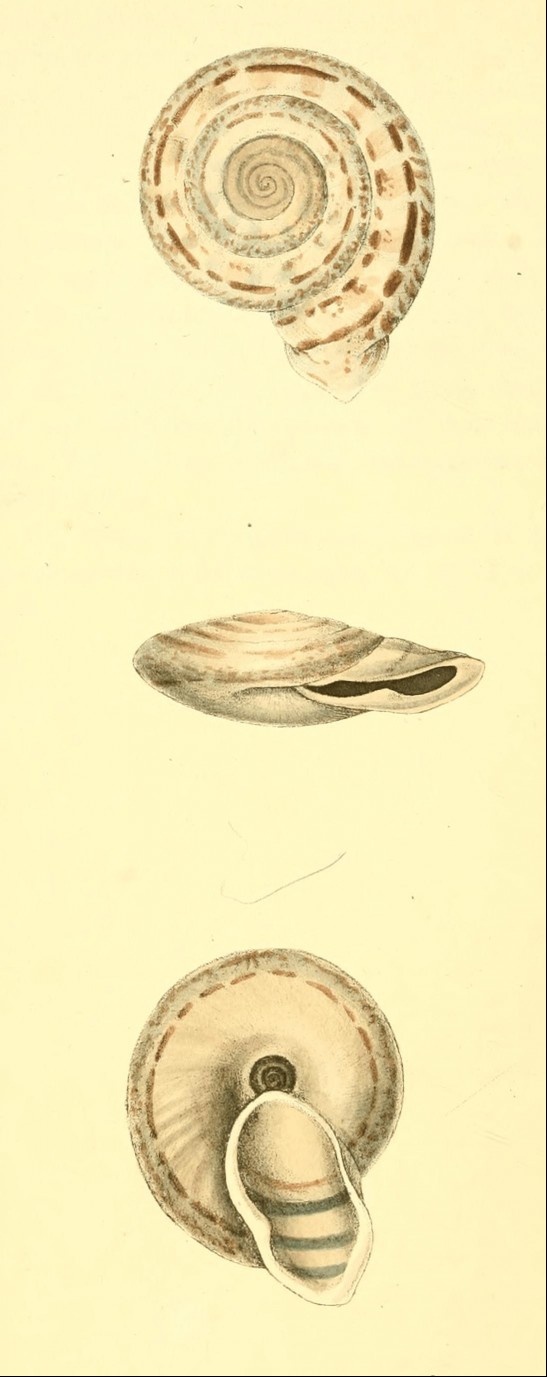
HELIX auriculata.
Eared Helix.
Generic Character.
Testa orbicularis vel globosa. Spira depressa vel paululum elevata.
Apertura integra. Labium exterius marginatum. Operculum nullum.Shell orbicular or globose. Spire depressed, or but slightly elevated.
Aperture entire. Outer lip margined. Operculum, none.
Specific Character.
H. testâ depressissimâ, ferrugineo-marmoratâ et bifasciatâ,
umbilico magno, profundo, aperturâ auriformi; labio exteriore incrassato,
margine interiore dente obsoleto.Shell much depressed, marbled and doubly-banded with ferrugineous.
Umbilicus large, deep. Aperture ear-shaped. Outer lip thickened,
reflected, with a gibbous obsolete tooth within.
A shell no less remarkable for its form than its extreme rarity. The
mouth bears a most striking resemblance to the human ear; and the only
specimen known in this country is the one here figured, from the cabinet
of Ch. Dubois, Esq., who obligingly favoured me with it for examination;
neither does the exquisite work on the Land Shells, by M. de Ferrusac,
now publishing at Paris, contain this species among the numerous
matchless figures already given of this family.
In the present uncertainty respecting the natural groups of the genus
Helix, as left by Lamarck, I have preferred for the present
following the example of Cuvier and de Ferrusac, in placing it with that
family, in preference to adopting the ill-defined and palpably artificial
distribution of them by D. de Montfort, or of forming a new genus for its
reception.
The variegations in its colouring are better seen in the figures than
described. The whole shell is slightly marked with obsolete longitudinal
striæ; the umbilicus is very deep, and the tooth does not extend
externally beyond the margin of the lip.
Pl. 10

STROMBUS.
Generic Character.
Testa ventricosa; basis canali brevi, truncato vel emarginato;
labium exterius simpliciter alatum, ala ad basin inferne emarginata;
suprà dilatata.Animal marinum, carnivorum, trachelipodum; corpore spirali; pede
compresso ad cervicis basin inferiorem. Leach in Zool. Misc. vol. i.
p. 51.
Typus Genericus S. pugilis. Linn.
Shell ventricose; base with a short canal, which is either emarginate
or truncate; external lip dilated into a simple wing, notched at the
base, and prominent above.Animal marine, carnivorous; body spiral, with a compressed foot at the
inferior base of the neck.
Generic Type S. pugilis. Linn.
STROMBUS minimus.
Little Strombus—central figures.
S. testâ nodosè plicatâ; spirâ subtilissimè striatâ; labio
interiore reflecto, incrassato, suprà obtusè-acuminato; exteriore intrà
lævi, suprà altè-lobato, anfractui secundo spirali adjuncto.Shell with nodulous plaits; the spire finely striated; inner lip
thickened and reflected, and obtusely pointed above. Outer lip smooth
within, deeply lobed above, attached to the second spiral volution.Lister 859. 15. Chemnitz. tab. 156. fig. 1491,
1492. Rumph. tab. 36, P. Gualtieri, tab. 32, G.Strombus marginatus. Dillwyn's Cat. p. 665. no. 18.
A pretty and diminutive species, scarcely ever more than one inch
three lines long. The spire long in proportion, and occupying half an
inch: when in perfection the colour is a deep chesnut, minutely broken
into finely serrated darker lines, with one, two, or three interrupted
bands of white on the body whorl, the spire, and margin of the outer lip
paler; there are two or three nodules above; and the spiral volutions
have the carinated row of tubercles usual in the Strombi, and are
besides finely striated transversely. The base of the shell is more
deeply and distinctly striated; both the lips are much thickened, tumid,
white, and highly polished; terminating above in obtuse points on the
second spiral whorl, leaving a narrow ascending channel between; the
inside of the aperture is a fine yellow.
Inhabits the Indian seas, but is not common.
By some unaccountable oversight, Mr. Dillwyn has very well described
this shell, but under the name and supposition of its being the S.
marginatus of Linnæus; though a few pages after he brings all the
true synonyms referring to his shell, under a description purporting to
be that of S. minimus, but which in reality is more applicable to
our next species. Why this writer should doubt the correctness of Gmelin,
Chemnitz, &c. respecting the true S. marginatus of Linnæus,
does not appear, particularly as he has substituted for it a well known
species. I have little doubt myself they all mean one and the same shell,
which is nothing more than a scarce variety of S. accinctus, now
before me, with which Linnæus's original description pretty well
agrees.
STROMBUS variabilis.
Variable Strombus—upper figure.
S. testâ nodosè plicatâ, spirâ striis nullis; labio interiore
simplice, exteriore reflecto, intrà lævi, suprà leviter lobato.Shell with nodulous plaits, the spire not striated. Inner lip simple.
Outer lip reflected, smooth within, and slightly lobed above.
Shell two inches and a quarter long, the spire occupying little more
than half an inch. The ground colour generally is white with numerous
undulated short lines of a darker colour, sometimes crossed by four or
five obsolete whitish bands: it approaches very near S. minimus,
but is easily distinguished by being in general much larger, by having
the inner lip not at all thickened above, the outer lip very slightly
lobed, and only advancing on the first volution of the spire: it varies,
however, amazingly in colour. There is a small variety, having a brown
spot beneath, from India; and others (labelled from the So. Seas) in the
Banksian collection, also small, are purplish-brown, with three or four
well-defined bands of white: the aperture is always pure white.
Pl. 11
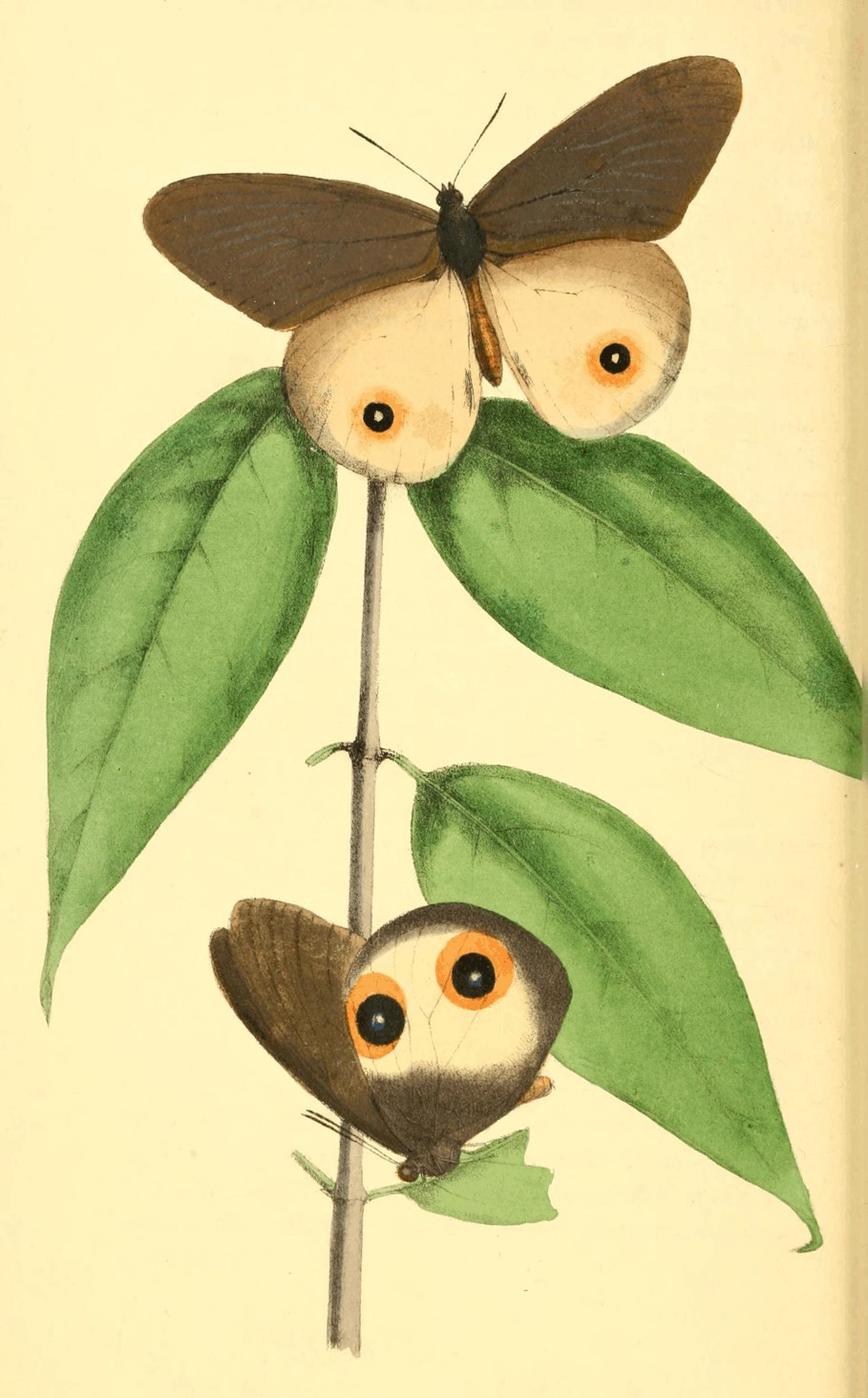
DRUSILLA Horsfieldii.
Generic Character.
Antennæ mediocres, clavâ productâ, gracili, cylindraceâ. Palpi
breves, compressissimi, obtusi, remoti, linguam non attingentes;
lateribus utrisque hirsutissimis, articulos obtegentibus. Abdomen (in maribus) 7-articulatum: 1mo
longissimo, ultimo simplici, truncato, suprà integro, subtus unco
incurvato, valvis nullis. Alæ anticæ (in maribus) basi posticâ dilatatæ,
fasciculum in alas posticas obtegentes.(Obs. Alæ integerrimæ, subdiaphanæ, posticæ
magnæ, orbiculares. Pedes antici spurii; antennarum articuli basales ad
apicem incrassati.)
Typus Genericus Papilio Jairus. Fabr.
Antennæ moderate, the club lengthened, slender, cylindric. Palpi
short, much compressed, obtuse, remote, not touching the tongue, covered
equally on both sides with thickset hairs concealing the joints. Abdomen
(in the male) 7-jointed, the first very long, the last simple, truncate,
and entire above, without valves, and with an incurved hook beneath.
Anterior wings (in the male) dilated at the posterior base, concealing a
tuft of hair on the inferior wings.
Generic Type Papilio Jairus. Fabr.
(Obs. Wings very entire, sub-diaphanous.
Hinder wings large, orbicular. Fore-legs spurious. Basal articulations of
the antennæ thickened at the end.)
Specific Character.
D. alis anticis angustatis, fuscis, concoloribus; margine
posteriore et exteriore æqualibus: posticis albidis; margine exteriore
fusco, suprà uni-ocellato, subtus bi-ocellato.Wings, anterior, narrowed, the posterior and exterior margins equal,
uniform brown; posterior cream-coloured, with a brown margin, one
ocellate spot above, and two beneath.
This new and elegant insect was discovered by my worthy friend Dr.
Horsfield (after whom I have named it) in the interior of Java:
it forms a part of the extensive collections made there by this zealous
naturalist for the East India Company, and which will make a most
important addition to our present confined knowledge of the productions
of that interesting island: indeed these collections exceed in extent,
preservation, and value, any which have been brought to this country.
The general resemblance of this species with Papilio Jairus of
Fabricius is so great, that it might pass on a cursory view as a mere
variety, did not the form of the anterior wings at once point out the
difference. In the present insect the posterior and exterior margins are
of equal length, giving a narrow appearance to the wings, much resembling
some of the true Papilionidæ; but in P. Jairus, these wings
are much broader, more obtuse, and the length of the posterior margin
much greater; other minor differences exist in the colouring and
markings. My valued friend A. H. Haworth, Esq., F.L.S., &c. possesses
a fine pair of the true P. Jairus in his rich and extensive
collection; and the liberality with which it is constantly and freely
opened to me, deserves my warmest thanks.
From these two species I have formed the present genus, the characters
of which will distinguish it from that of Hætera (Fabr.), a scanty
genus confined to South America; and this seems to occupy its place in
India: both will come in the natural family of Hipparchidæ. Only one specimen (a male) exists in Dr. Horsfield's collections; I could not therefore dissect the mouth,
&c. On the inner borders of the inferior wings is a lengthened tuft
of fine hairs: the anus beneath has on each side an obtuse
lengthened process, partially attached, and which appears to supply the
place of the lateral valves. It is represented on a sprig of
Gærtnera racemosa,
which, although differing slightly from the figure of Dr. Roxburgh's
Coromandel Plants, p. 19. t. 18, Dr. Horsfield considers as the same plant. The Javanese name is
Kakas.
Pl. 12
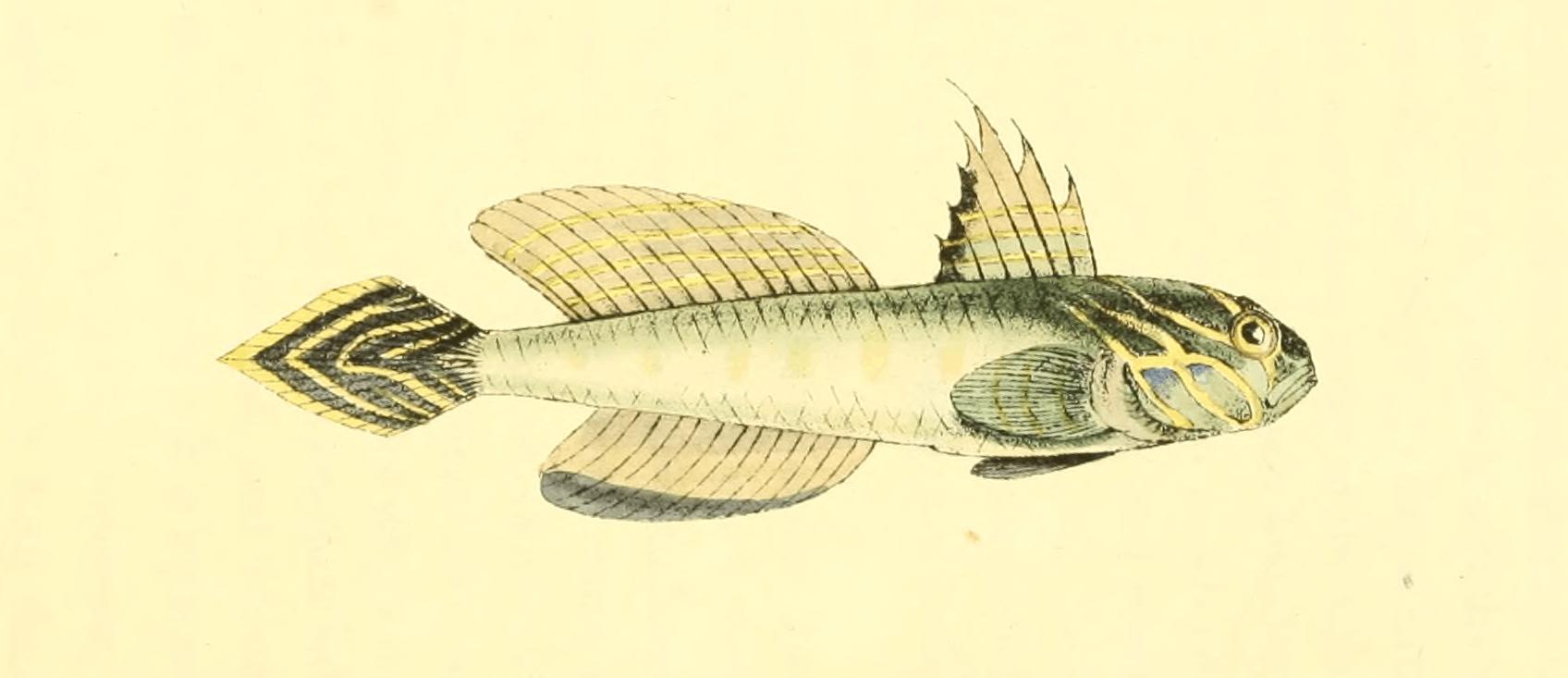
GOBIUS Suerii.
Suerian Goby.
Generic Character.
Caput parvum. Oculi approximati. Pinnæ dorsales duæ, radiis
flexilibus: ventrales conjunctæ, infundibuliformes. Branchiarum apertura
contracta, membranâ 4-radiatâ.
Typus Genericus Gobius niger. Pennant.
Head small. Eyes approximating. Dorsal fins two, the rays flexible.
Ventral fins united into the form of a funnel. Gill aperture contracted,
the membrane four-rayed.
Generic Type Gobius niger. Pennant.
Specific Character.
G. olivaceus, caudâ atro-purpureâ. Capite, operculis, pinnâ dorsali
et caudali longitudinaliter flavo-lineatis.Olivaceous Goby. Tail obscure purple. Head, gills, dorsal and caudal
fins with yellow longitudinal lines.Gobius Suerii. Risso Icth. p. 387. pl. 11. fig.
43.
This beautiful little fish never exceeds the size here represented. It
is not uncommon on the coast of Sicily in the spring months: it has
likewise been discovered on the shores of Nice by Risso, who is its first
describer: his figure, however, is so remarkably bad, that it would be
impossible to recognise it but for his description: in fact, the fish is
so delicate, that unless the fins are very carefully expanded in water
their form and colouring will never be seen correctly. It has been named
after M. C. A. Le Sueur (who accompanied Peron in the French
circumnavigation), an able zoologist and most inimitable draftsman and
engraver.
General colour pale olivaceous yellow, with a few obscure large spots
along the body somewhat brighter. The head has four yellow oblique bands,
between which, and behind the eye, is a bright blue spot. Ventral fins
blackish. The first dorsal fin is trigonal, and has the third ray
lengthened and longest; the three last rays tipt with deep-black; the
second fin is lengthened, broadest at the end, the membrane greyish-white
with narrow longitudinal lines of yellow. Caudal fin lanceolate, pointed,
blackish-purple, margined and marked with yellow lines parallel with the
borders. Pectoral fin ovately rounded, with faint yellow transverse
bands. Anal fin resembling the second dorsal, greyish, with the margin
dull-purple. Scales large, very deciduous; lateral line invisible; lower
jaw longest; teeth minute. Body and fins semi-transparent. The first
dorsal fin has seven rays; the second fifteen; anal fifteen; pectoral
twelve; caudal seventeen; ventral fourteen.
Pl. 13

PLATYRHYNCHUS Ceylonensis.
Ceylonese Flat-bill.
Generic Character.
Rostrum breve, rectum, depressissimum, fermè trigonum; mandibulâ
superiore ad apicem abruptè aduncâ, emarginatâ; inferiore rectâ,
breviore; marginibus superioris inferiorem superplicantibus. Os et Nares
longis rigidis vibrissis obtectæ. Nares, mediæ inter apicem et hiatum
rostri. Cauda plerumque æqualis, rectricibus duodecim. Pedes et Tarsi
breves, graciles.Typi Generici. Div. I. Todus Platyrhynchos. Gm. Div. II.
Muscicapa barbata. Lath.Bill short, straight, thin, very depressed, and nearly triangular; the
upper mandible abruptly hooked at the tip, and notched; the margins
folding over those of the under mandible, which is straight and shorter.
Mouth and nostrils defended by long stiff bristles. Nostrils medial
between the tip and gape of the bill. Tail mostly even, of twelve
feathers. Legs and toes short, slender.Generic Types. Div. I. Todus Platyrhynchos. Gm. Div. II.
Muscicapa barbata. Lath.
Specific Character.
P. olivaceus, subtùs flavus; capite mentoque cinereis.
Olivaceous Flat-bill, beneath yellow. Head and chin cinereous.
The sober tints of this little bird accord more with those of Europe
than of India, of which country however it is a native, having been sent
from Ceylon to the British Museum: it is the only one I have yet seen,
and appears hitherto undescribed.
The stiff bristles at the corner of the mouth are nearly the length of
the bill, which is quite flattened: the tail is even, and the whole bird
in every respect but colour closely resembles the bearded Flycatcher
(Musc. barbata Lath.).
Cuvier and other modern zoologists have done much in distributing the
Linnæan Muscicapæ into their natural families; but as we are
acquainted with a great number from descriptions only, the arrangement is
by no means perfect.
The generic characters now given of the genus Platyrhynchos
(very slightly noticed by Vieillot) will be found perfectly applicable to
the separate divisions here formed; the first comprising the Todus
Platyrhynchos of Gmelin, and a few others having the bill larger and
more dilated than the second division, which includes the present
species, together with M. barbata, cærulea, cuneata,
and no doubt many others. The construction of the bill in all these birds
will be found precisely the same, though more or less developed in each
division, and even in the species; it thus becomes impossible to draw the
line of demarcation without refining too much on generic distinctions.
Their bills, although so broad, are by no means stout; thus enabling them
to prey with greater readiness on the Lepidoptera and other large
winged insects with soft bodies; while the long stiff bristles at the
base of the bill seem intended to confine the resistance their prey would
otherwise make by their wings. The illustrious Cuvier has well observed,
that the true Flycatchers have the bill longer, narrowed, less
compressed, and the tip but slightly bent.
Pl. 14
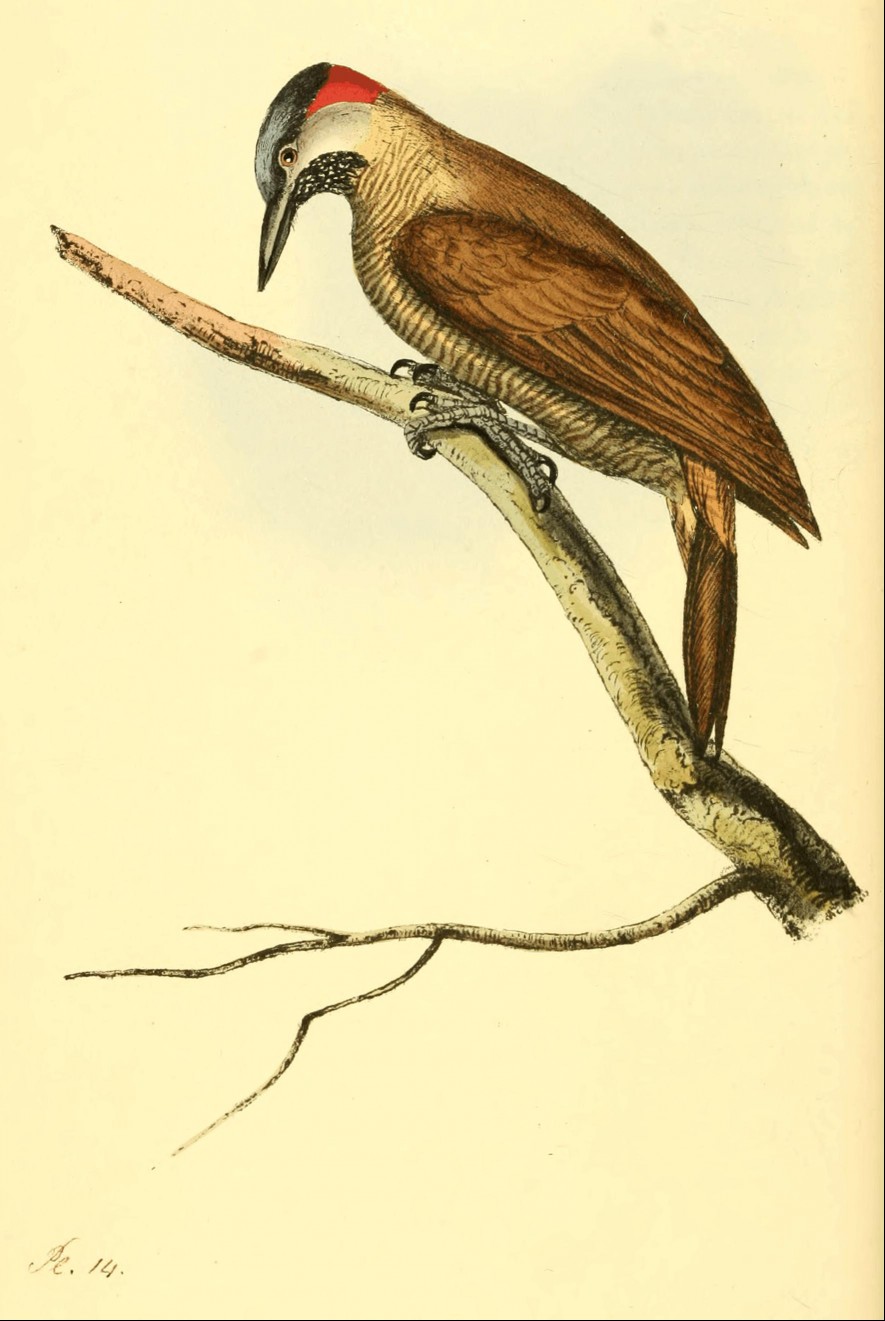
PICUS rubiginosus.
Brown Woodpecker.
Generic Character.
Rostrum polyedrum, rectum, in apicem compressum, cuneatum,
attenuatum. Nares basales, ovales, patulæ, plumis angustis recumbentibus
tectæ. Lingua longissima, jaculatoria, apice sagittato. Cauda rectricibus
validis, rigidis, acuminatis, 10, intermediis duabus longioribus.
Pedes scansorii.
Typus Genericus Picus viridis.
Bill many-sided, straight, the tip resembling a compressed pointed
wedge. Nostrils basal, oval, open, covered externally with narrow
recumbent feathers. Tongue very long, retractile, the tip barbed.
Tail-feathers ten, strong, rigid, acuminated; the two middle ones
longest. Feet climbing.
Generic Type Picus viridis.
Specific Character.
P. suprà rubiginosus: vertice nigrescente; occipite rubro, subtùs
fulvo, fusco-fasciato.Above tawny rufous. Crown blackish; hind head crimson, beneath
fulvous, with brown transverse bands.
The Woodpeckers form a most natural family of birds, and are dispersed
in every part of the known world, excepting the Polar regions. Eight
species inhabit Europe, five of which are found in our own country. The
largest however of these, the Great Black Woodpecker, is very rare; and
even the others are less frequently seen than formerly, from the gradual
diminution of our few remaining forests.
The present appears an undescribed species, and was sent from the
Spanish Main to E. Falkner, Esq. of Fairfield. I have since seen the
male, which, like many others of this genus, is distinguished by a patch
of red below the eye.
Total length, eight inches and a half; bill one inch long, blackish;
front and crown cinereous black; the hind head and nape crimson; a dusky
whitish line (beginning at the nostrils) includes the eye and
ear-feathers; below this on each side blackish, with longitudinal whitish
dots, which in the male is mixed near the bill with crimson; chin
blackish, speckled with white. The general plumage above is uniform tawny
rufous brown, becoming more olive on the rump. Under parts olivaceous
yellow, crossed with numerous close bands of blackish brown. Quills with
the inner web black, the margin pale yellow; shafts and outer web tawny;
tail the same, the shafts and outer half black, excepting the last pair,
which have yellowish shafts and dusky tips. Wings inside, pale orange.
Legs and claws dusky green.
Two or three other individuals have since fallen under my observation:
the male I saw at Mr. Leadbeater's, Animal Preserver, in Brewer-street,
of whose liberality and integrity in every way, I can bear the most
unqualified and cheerful testimony.
Pl. 15
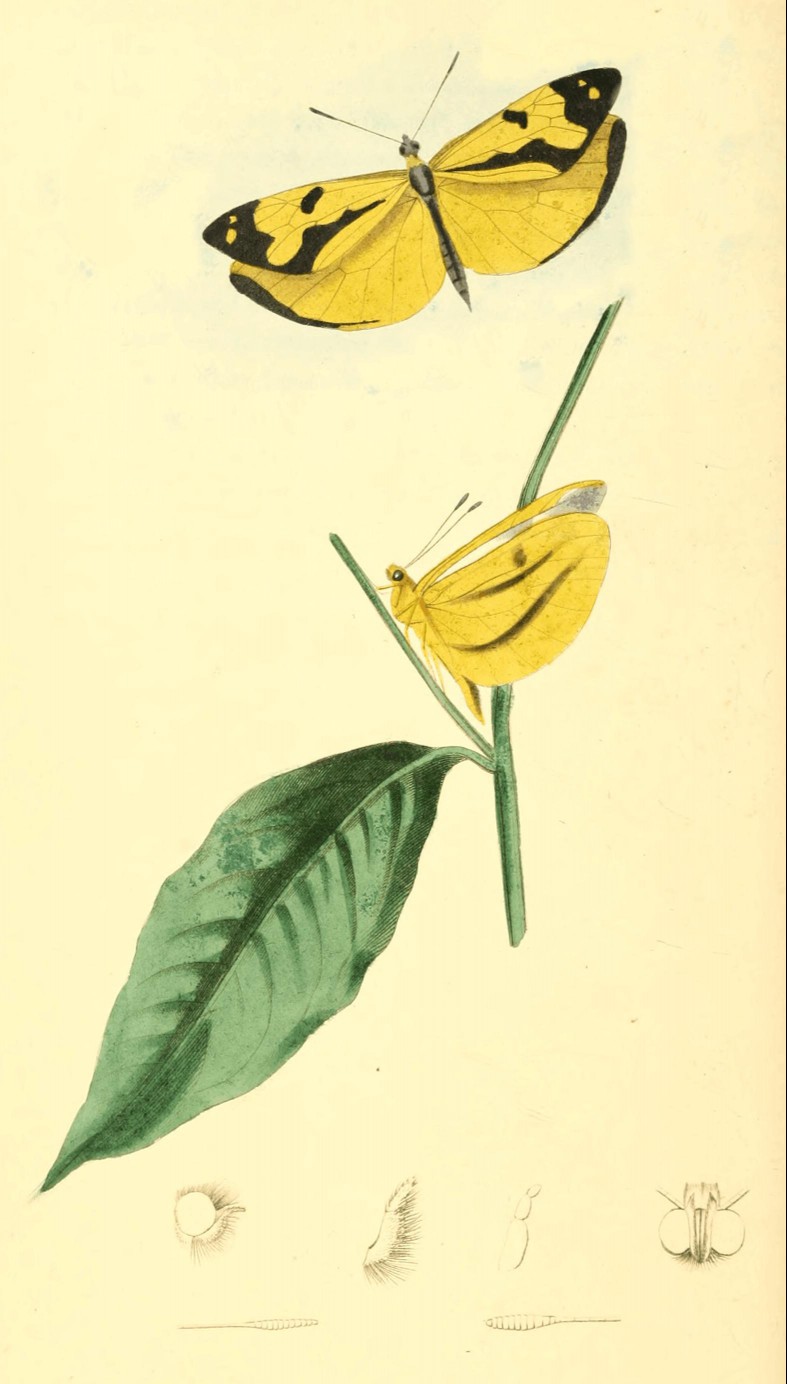
LICINIA Melite.
Generic Character.
Antennæ graciles; clavâ elongatâ, fusiformi, compressâ. Palpi
brevissimi, vix ultra caput producti, ad linguam compressi, squamis
linearibus tecti, margine ciliati, articulo ultimo sub-nudo, secundo
subæquali. Abdomen elongatum, gracile, in maribus 6-articulatum, articulo
ultimo integro; valvis plerumque elongatis, attenuatis, apice acutis. Alæ
anticæ (in maribus) angustæ, obtusè-attenuatæ, (in fœminis)
latiores, obliquè rotundatæ. Alæ posticæ (in maribus) dilatatæ,
longitudine anticis penè æquales; margine antico opaco, in fœminis
breviores, suborbiculares.
Typus Genericus L. Melite. Nobis.
Antennæ slender, the club elongated, fusiform, and compressed. Palpi
very short, hardly projecting beyond the head, compressed on the tongue,
covered with scales and margined externally with long hairs, the last
joint nearly naked and almost as long as the second joint. Body
elongated, slender, in the male with 6 joints, the last entire. Valves
generally elongated, attenuated, their tips acutely pointed. Anterior
wings (in the male) narrow, obtusely attenuated; in the female broader,
and obliquely rounded. Posterior (in the male) dilated, nearly as long as
the anterior wings, the fore margin opaque; in the female shorter, and
nearly orbicular.
Generic Type L. Melite.
Specific Character.
L. (Mas.) alis flavis; anteriore suprà nigrâ, fasciâ obliquâ flavâ,
et lineâ, basali transversâ, margine posteriore flavo. (Fœm.) Alis
suprà albis; anteriore apice stigmateque marginali obliquo nigris;
posteriore suprà nigro marginatâ, subtùs (in utroque sexu) flavescente,
lineis duabus transversis fuscis.Male. Wings yellow, anterior above black, with an oblique yellow band
and transverse basal line; posterior margin yellow. Fem. Wings above
white; anterior, with the tips and marginal oblique stigma black.
Posterior, above margined with black; beneath (in both sexes) yellow,
with two transverse brown lines.Papilio Melite. Fab. Ent. Syst. 160, 494. Cramer, tab.
153. C. D.
The remarkable size of the under wings in the male insects of this
genus will distinguish them even to a casual observer as forming a
natural group. They are all natives of South America, where I discovered
nine species. The females differ most strikingly, and have hitherto been
mistaken by authors not only for distinct species, but as belonging to
different genera.
Their natural situation will be among the Pieridæ, with whose
general habit they accord.
The female of this species resembles Pap. Licinia of Cramer,
except in having a short black stigma in the middle of the anterior
border of the fore wings, pointing obliquely to the exterior margin.
Cramer's insect, however, is the female of another undescribed species in
my cabinet.
The under side of the posterior wings in both sexes is the same.
Pl. 16
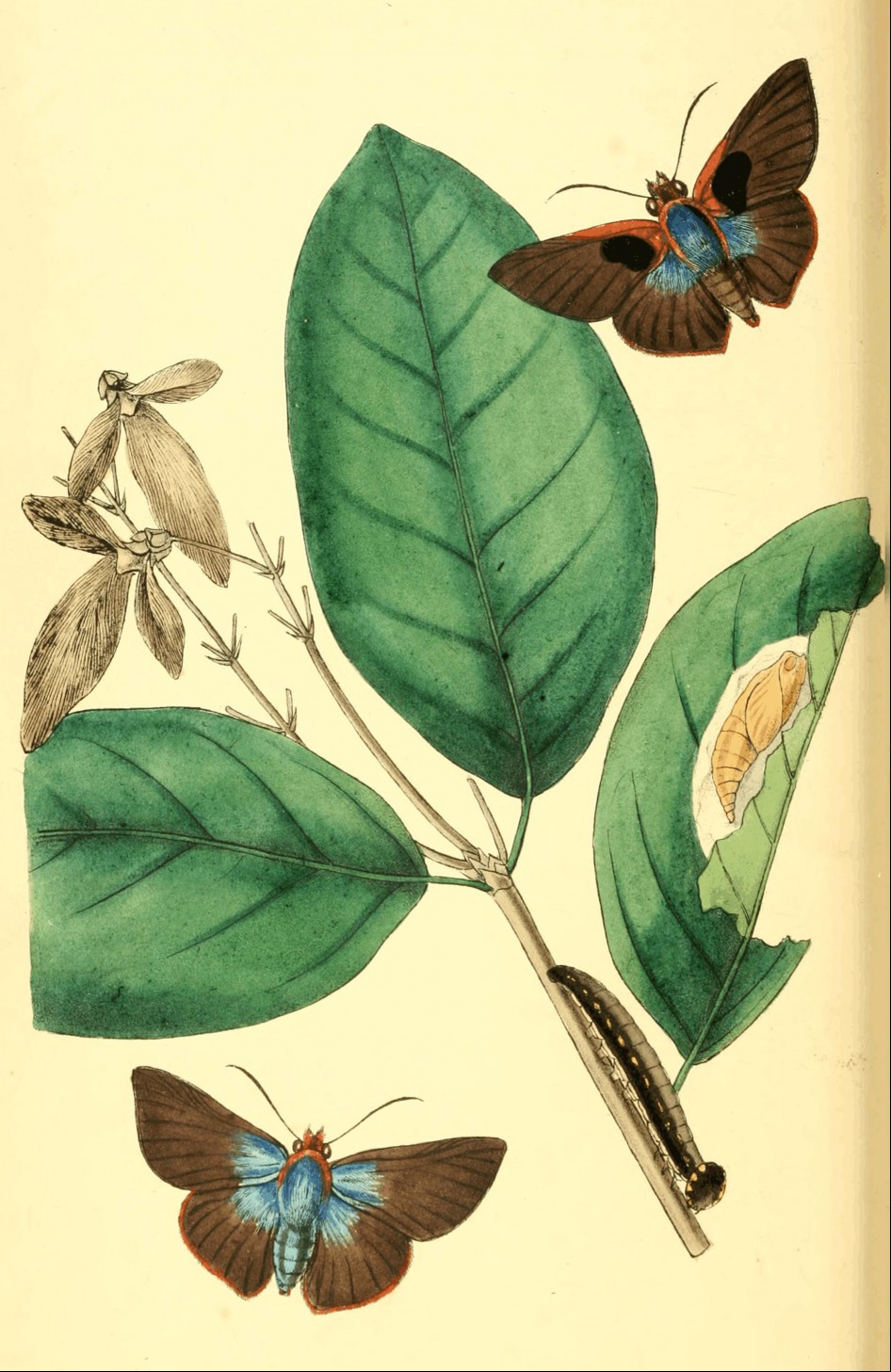
ISMENE Œdipodea.
Generic Character.
Antennæ cylindraceæ, juxta medium crassissimæ, versus apicem
subulatæ, articulis numerosis brevissimis pene detectis. Palpi crassi
squamosi, fronte obtusâ, lateribus compressis, marginibus exterioribus
ciliatis, articulo ultimo nudo, producto, subhorizontali, lineari,
compresso. Oculi (in maribus) magni. Corpus (in maribus) 7-articulatum,
articulo ultimo suprà appendice transverso truncato subemarginato
terminante, subtùs duobus uncis recurvis obtusis, fasciculo tectis;
articulo 1mo et ultimo brevissimis: (in fœminis) articulo ultimo
producto, subacuminato.Antennæ cylindrical, thickest near the middle, the terminal half
subulate; articulations numerous, very short, hardly perceptible. Palpi
thick, scaly; frontal side obtuse; lateral sides compressed; the margins
externally fringed with hair; the last joint naked, lengthened, nearly
horizontal, linear, compressed. Eyes (in the male) very large. Body (in
the male) of seven joints, the last with a transverse, slightly
emarginate, truncate appendage above; and two obtuse recurved hooks
below, concealed by a tuft of hair; the first and last segment shortest.
Body in the female with the last joint lengthened and pointed.
Specific Character.
I. alis suprà fuscis, basi nitidè-cæruleâ, posticis aurantio
marginatis, subtùs rufo-fusco nebulosis, basi puncto nigro: anticis (in
maribus) basi aurantiis, maculâ nigrâ tomentosâ.Wings above fuscous, shining blue at their base; posterior margined
with orange; beneath clouded with rufous and brown, and a black dot at
the base of the posterior wings. Anterior wings (in the male) orange at
the base, and a large velvet-like spot of black.
The resplendent and changeable azure blue which ornaments the body and
part of the wings in this very singular insect, can be but ill expressed
in the figure. It is one of the many new and interesting subjects in
entomology discovered in Java by Dr. Horsfield; and by his kindness and liberality I am enabled to add
the figures of the caterpillar and chrysalis, which were copied out of a
fine series of drawings made in Java under his own eye: they do not
appear to differ in their formation from others of this family, although
the perfect insect possesses such striking and peculiar generic
characters; one of the many facts which prove the impossibility of making
the Larvæ a primary consideration in forming the genera of
Lepidoptera.
This is a rare insect, I have therefore been obliged to leave the
generic character imperfect, as the dissection of the mouth, &c.
would destroy the specimen. The posterior margin in the wings of the male
is sinuated; in the female it is nearly straight; the underside of the
wings in both sexes is the same; the anterior pair reddish-brown, paler
in the middle; the tip and posterior margin whitish: inferior wings
reddish-orange towards the inner margin, with an obsolete central curved
band of the same, and a black dot at the base of the inferior wings. The
head, palpi, and thorax are margined with orange, less conspicuous in the
female.
Our knowledge of the genus Hesperia of Latreille (under which
the present insect would come) is little more than what was known of
Scarabæus twenty years ago; nor has Fabricius even noticed one
half of the species figured by Cramer. The larva feeds on
Gærtnera Javensis
Foliis ovatis, obtusè-acuminatis, caule volubili ramosissimo,
ramulis diffusis, deflexis,
a new species, discovered in Java by Dr. Horsfield, who has distinguished it by the above specific
character. He informs me the natives give it the name of
Kakas-rambat, which last word signifies twining or trailing. In
the inflorescence and fruit it differs not from G. racemosa.
Pl. 17

BULIMUS zonatus.
Zoned Bulimus.
Generic Character.—See Pl. 4.
Specific Character.
B. testâ lævi conicâ; spiræ anfractibus quinque; ultimo
aliquantulum distorto; albis duabus fasciis ferrugineis inæqualibus;
anfractu basali rufo duabus albis fasciis; aperturâ albâ.Shell smooth, conic, of five volutions, the last somewhat distorted;
white, with two unequal ferrugineous bands; body whirl rufous, with two
white bands. Aperture white.
A small though very elegant shell, seldom seen in Collections; nor do
I find such a description of it as will identify the species. One figured
by Martini, at tab. 134, fig. 1215, comes near it, but
differs sufficiently for a specific distinction.
Its precise locality is unknown: a fine specimen exists in my father's
collection, who thinks it came from the East Indies; and this is the only
one I have yet seen.
The aperture is more round than ovate, and is less than one half the
total length of the shell; the outer lip much reflected, and the
transverse bands on the spiral whirls nearly obsolete.
Pl. 18
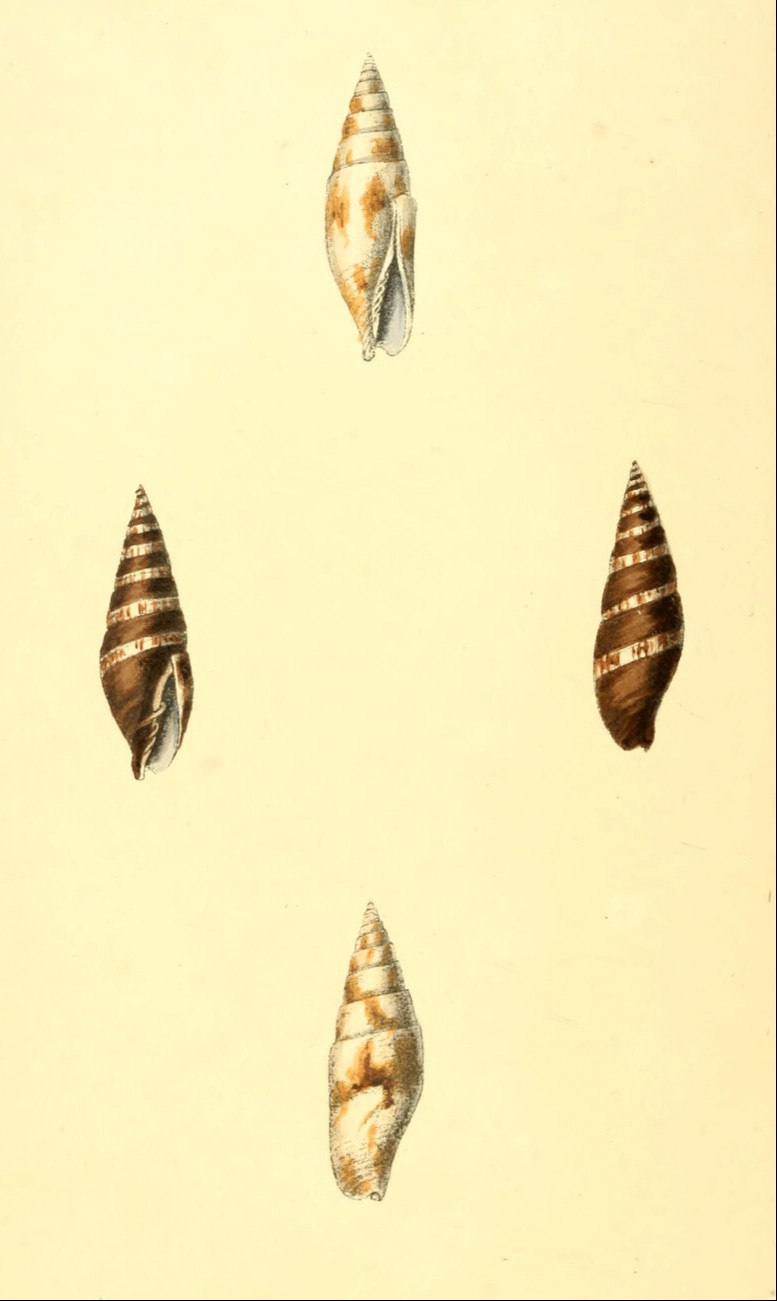
MITRA contracta.
Contracted Mitre—upper figure.
Generic Character.—Pl. 23.
Specific Character.
M. (Div. 3.) testâ sublævi; margine superiore anfractuum
prominente, anfractu basali in medio contractoShell nearly smooth; upper margin of the volutions prominent; basal
whorl contracted in the middle.
An undescribed species, for the loan of which I am indebted to Mr. G.
Humphrey, of Leicester-street, whose knowledge as a collector, and
integrity as a dealer, have gained him respect and confidence through a
long life: and it is no less singular than true, that many genera of
modern authors, now universally adopted, were formed by him near
twenty-five years ago (under different names) in the Museum
Calonianum, printed in 1797.
Shell one inch and a half long, and smooth; the base and spire with
faint remote grooves; the spiral whorls are scarcely convex, and their
upper margins prominent. Outer lip thick, effuse, slightly reflected
below, and contracted above. Pillar five-plaited; colour yellowish white,
with two or three waved longitudinal bands of orange, and a few others
broad and remote on the spire. A finer specimen I have since seen with
Mr. Humphrey's was one inch three quarters long, the ground-colour pure
white, the aperture orange, and the bands rich orange-chesnut.
MITRA australis.
New Holland Mitre.
M. (Div. 2) testâ lævissimâ; spirâ elongatâ; anfractibus basi
castaneo-fuscis; fasciâ albâ in basali anfractu, centrali. Columellâ
4-plicatâ.Shell very smooth. Spire elongated, chesnut-brown; base of the spiral
volutions with a whitish band, which is central on the basal whorl.
Pillar four-plaited.
Dead shells of this new Mitre were received from Van Dieman's Land by
Mr. Humphrey: it is perfectly destitute of striæ, excepting a few faint
ones at the base: the mouth, which is smooth inside, appeared in the few
specimens he had, to be unformed; it is, however, sufficiently distinct
from any other.
Pl. 19

TINAMUS Tataupa, var.
Tataupa Tinamou.
Generic Character.
Rostrum mediocre, depressum, latius quam altum, apice rotundato
obtuso; culmine lato, excelso. Nares laterales, mediæ, ovatæ, patulæ,
apertæ. Pedes tetradactyli, fissi; halluce brevissimo, insistente. Cauda
nulla, aut brevissima, plumis uropygii obtecta. Alæ breves. Temminck,
vol. iii. p. 747.
Typus Genericus T. rufescens. Latham.
Bill moderate, depressed, broader than high, tip obtuse, back broad.
Nostrils lateral, medial, ovate, expanded and open. Feet four-toed,
cleft; hind toe very short. Tail none or very short, concealed by the
rump-feathers. Wings short.
Generic Type T. rufescens. Latham.
Specific Character.
T. corpore suprà fusco-rufo, immaculato; capite et collo
fusco-nigro; mento albo; gulâ, collo, pectoreque cinereis; corpore infrà
albescente; uropygio lateribusque posticis rufis aut nigris, pennis
albo-marginatis.Tinamou with the body above dusky-rufous, immaculate. Head and neck
dusky-black; chin white; throat, neck and breast, cinereous; body beneath
whitish; vent and flanks rufous or black, the feathers margined with
white.Tinamus Tataupa. Temminck Pig. et Gall. iii. p. 590
et 752. Gen. Zool. vol. xi. part 2. p.
416.
The Tinamous are entirely confined to the new world, where they seem
to hold the same scale in creation which the Partridges do in the old
continent. Our knowledge of these singular birds has been much increased
by the writings of Professor Temminck, who has described twelve species.
The present bird is nearly the smallest of its family: I found it only
once in the interior of Bahia in Brazil, where it must be very rare, or
frequent to particular districts only. Though differing in some respects
from the description of Temminck, I am inclined to consider it merely as
a variety.
Total length (excepting the legs) eight inches and a quarter. The bill
is one inch one line long from the gape, and, with the irides, is red.
The head and neck above blackish cinereous; the crown much darker and
tinged with brown, the rest of the upper plumage uniform reddish-brown;
the edges of the wing-covers tinged with pale cinereous; the spurious
wings and quills greyish-brown; the chin is white, changing on the
throat, neck, breast and their sides to a pale lead-colour, which, on the
body, again becomes white; the feathers on the flanks are blackish or
rufous, beautifully margined all round by white, with another internal
mark of the same kind; those on the vent are similarly marked, but on a
pale rufous ground; the thighs are rufous-white; the under tail-covers
rufous, marked by narrow undulated concentric lines of black, the ends
whitish. The length of the legs (from the knee to the base of the middle
toe) one inch two lines, and from that to the tip of the claw one inch.
Legs blueish-purple. Hind toe very short, and elevated above the
ground.
Pl. 20
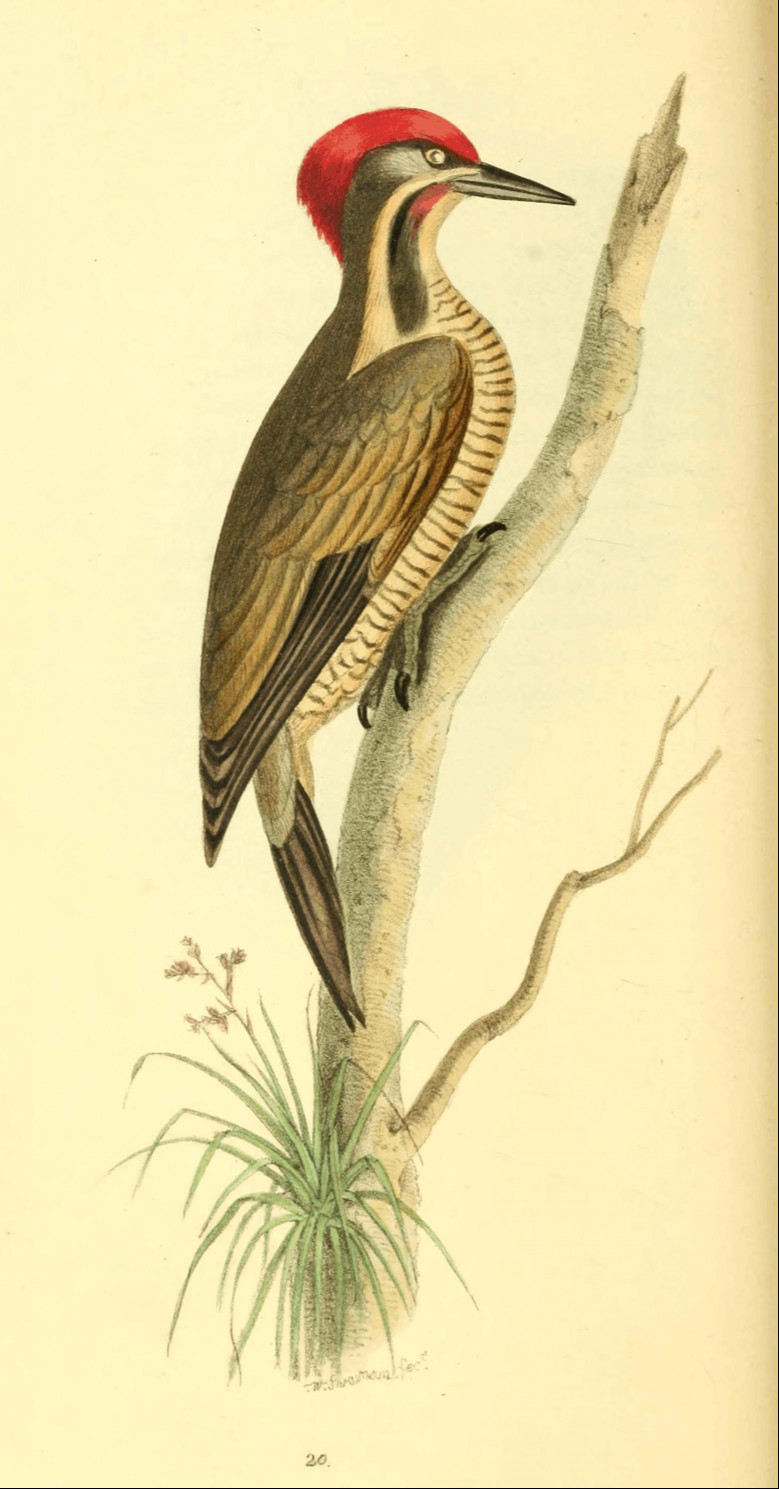
PICUS Braziliensis.
Brazilian Woodpecker.
Generic Character.—See Pl. 14.
Specific Character.
P. olivaceus, subtùs fulvus, nigrescente-fasciatus; capite
subcristato, suprà rubro, utrinque lineis olivaceis, fulvis, et
rubris.Olive Woodpecker: beneath fulvous, with transverse blackish bands.
Head sub-crested, above red, the sides with olive, yellow, and red
streaks.P.
Braziliensis, Swains. in Wern. Trans. 3. p. 291.
A new species of this already extensive family, inhabiting the
interior of Brazil in the province of Bahia, where I met with it but
once. It was, I believe, first described in a paper I sent to the
Wernerian Society some time ago: the figure is less than the natural
size.
Total length nine inches. Bill not quite an inch, and blackish. Irides
yellow. Head slightly crested; the whole upper part crimson. Orbits and
cheeks olive-brown; beneath this a narrow line of tawny-yellow begins at
the nostrils and passes down the sides of the neck; next this is a
similar stripe crimson on the jaws and olive beyond, leaving the chin and
throat in front yellowish; the plumage above is tawny-olive. Quills
black, within edged with rufous: all the under parts tawny-yellow,
transversely banded with blackish lines; inner wing-covers yellowish.
Tail three inches and a half long, the feathers black, unspotted, and
tinged at their base with olive. Feet and claws lead-colour. The neck is
very slender. The only one I have yet seen was a male.
Pl. 21
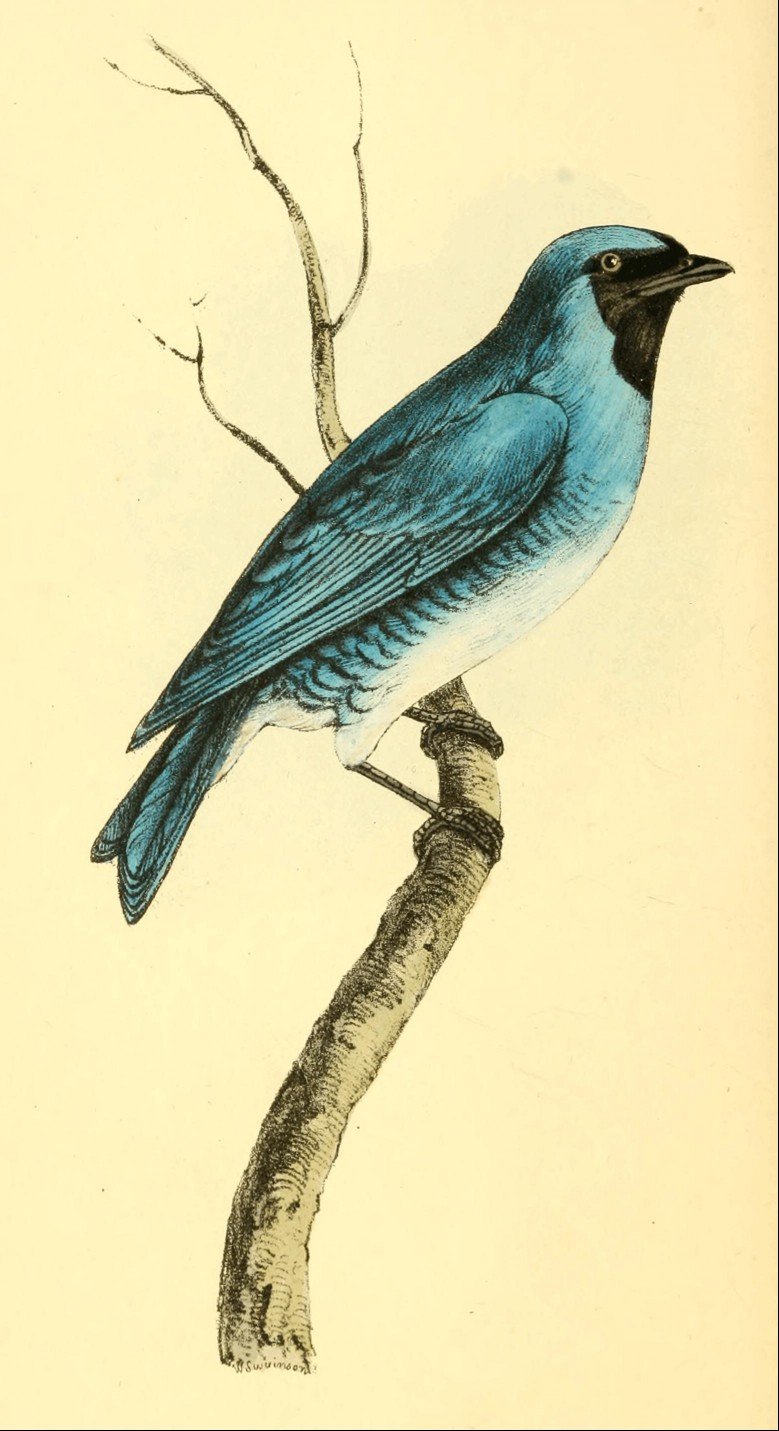
PROCNIAS hirundacea.
Swallow Fruit-eater.
Generic Character.
Rostrum breve, trigonum, basi latissimum, dilatatum, versus apicem
contractum: mandibulis emarginatis; marginibus intraflexis; mandibulâ
superiore, tomiis curvatis, carinatis; inferiore rectâ, breviore. Nares
latæ, basales, subnudæ; aperturis orbiculatis, approximantibus, apicem
quam malam magis appropinquantibus. Lingua brevissima, angusta. Rictus
amplissimi infra oculos aperientes. Pedes insidentes. Alæ
mediocres.
Typus Genericus Ampelis carunculata. Latham.
Bill short, triangular, base very broad, dilated, towards the end
contracted; both mandibles notched, the margins bent inward; upper
mandible slightly curved and carinated above; lower mandible straight and
shortest. Nostrils broad, basal, nearly naked, the aperture much nearer
the tip than the gape of the bill. Tongue very short, narrow. Mouth very
large, opening beneath the eye. Feet formed for perching. Wings
moderate.
Generic Type Carunculated Chatterer. Latham.
Obs. MM. Temminck and Lagier had just before us, and
without our knowledge, published this bird under the name of Procnias
Ventralis, (Pl. 5.) by which name in right of priority it should stand in
the system.
Specific Character.
P. (in maribus) cærulea; fronte, jugulo, temporibusque nigris;
corpore subtùs in medio albo, lateribus striis transversis
nigrescentibus.(Fœm.) viridis; mento temporibusque griseis; corpore infrà
flavescente, striis obscurè-viridibus transversis.(Male) blue; front, throat, and temples black; middle of the body
beneath white, the sides with blackish transverse striæ.(Female) green; chin and temples grey; body beneath yellowish,
transversely striated with dusky-green.
The birds of this genus are remarkable for the enormous width of their
mouths, which in some species exceeds that of the Swallow family, thus
enabling them with ease to swallow the large berries of the
Melastomæ and other tropical shrubs, on which they alone subsist;
not on insects, as Cuvier asserts. Although in the construction of their
bills they perfectly resemble the Swallows, their wings are not formed
for long or rapid flight; and their feet are much stronger, and
calculated for searching among branches for their food, in which
situations I have frequently seen them. The term "pedes
ambulatorii," or walking-feet, is applied too generally, and should
be confined to the gallinaceous and Pigeon tribes.
This genus was formed by Count Hoffmansegg, and the present is the
smallest species known: our figure is of the male bird. Total length
about five inches and a half. The bill from the angle to the tip measures
seven lines; but from the nostrils only three lines and a half. The
middle of the body, vent, and under tail-covers in the male are pure
white; in the female yellowish, with a line of olive-green down the
middle of each shaft; the quills, wing-covers, and tail-feathers are
black, margined in the male with blue, and in the female with green: the
tail is slightly forked. The nostrils round and bare; the base of the
bill has a few weak setaceous hairs. The legs resemble the true
Chatterers, having the outer toe rather longer than the inner, and
attached to the base of the middle.
This is a scarce bird, apparently not hitherto described; I met with
it only three times in Bahia; but it appears more frequent in the
southern provinces of Brazil, specimens having been sent me from Minas
Geralis and Rio de Janeiro.
Pl. 22

TERIAS Elvina.
Generic Character.
Antennæ breves, clavâ subtruncatâ, compressâ. Palpi brevissimi
curvati, vix ultra caput producti, ad linguam compressi, densis squamis
imbricatis in totum tecti apice nudo. Abdomen elongatum, gracile, in
maribus 6-articulatum, articulo ultimo duobus uncis incurvatis
approximantibus; valvis latis, incrassatis, truncatis, aduncis. Alæ
utroque sexu similes; latæ, obtusæ, rotundatæ, integerrimæ.
Typus Genericus Papilio Hecabe. Linnæus.
Antennæ short, the club somewhat truncate and compressed. Palpi very
short, curved, hardly projecting beyond the head, closely compressed on
the tongue, entirely covered with close imbricate scales, the tip naked.
Body elongated, slender, in the male six-jointed, the last with two
approximating incurved hooks; valves broad, thickened, truncate, and
hooked. Wings in both sexes alike, broad, obtuse, rounded, very
entire.
Generic Type Papilio Hecabe. Linnæus.
Specific Character.
T. alis subdiaphanis, sulphureis, subtùs immaculatis. Anticis suprà
apice nigris, posticis (in maribus) margine antico basi gibbosis.
Fœm. ——?Wings sub-diaphanous, pale sulphur; beneath immaculate. Anterior,
above with a black marginal tip; posterior (in the male) with the
fore-margin gibbous at the base. Female ——?Pieris Elvina. Godart in Encycl. Method, p. 158. no.
67.
This is one of the smallest of Butterflies, and from the extreme
delicacy of its form seems to sanction with truth the poetic idea of
living "but for a day." It is found in Brazil, inhabiting only the
deepest forests, as if fearful its little life would be endangered by the
scorching rays of a tropical sun: in these sombre shades it is seen to
fly slowly and feebly near those spots where a ray of the sun has
partially entered the thick canopy of foliage above, which is frequently
fifty or sixty feet from the ground.
The genus I have now placed it in belongs to the Coliadæ, and
appears to connect that family with the Pieridæ: their
distinctions are obviously marked and very constant in all the species I
have yet seen, and which are tropical: of these, seven I discovered in
Brazil; three or four more are natives of the southern extremity of North
America; and Dr. Horsfield has four or five from Java. I know of none from Africa.
Their size in general is very small.
I think this species is the Pieris Elvina of Godart; although
the insect he mentions as the female is in reality that of his Pieris
Neda. The true female I have never seen; I suspect it will want the
gibbous curve on the hinder wings of the male, which sex is, indeed, not
common, and is generally much smaller, and sometimes half the size only,
of the figure.
Papilio Nicippe of Cramer (tab. 210. fig. C. D.) strictly
belongs to this genus, though placed in that of Colias by Godart,
as well as his Pieris Agave, Hecabe, and doubtless many
others not now before me.
Pl. 23

MITRA vittata.
Ribbon Mitre.
Character Genericus.
Testa inæqualiter fusiformis, spirâ productâ attenuatâ; labio
exteriore intùs edentato. Columella plicata.
Divisiones.
III. Apertura angusta,
linearis, suprà angulata, infrà subcontracta.
Mitræ vulpecula, plicata, &c.
Obs. Testa plerumque longitudinaliter
plicata, æqualiter fusiformis, labio exteriore lævi leviter undulato,
interiore ad apicem intrà crassato; gulâ striatâ.
III. Apertura suprà
acuminata, infrà angusta, extrinsecus curvata.
Voluta mitra-abbatis. Chemnitz, &c.
Obs. Testa plerumque spirâ elongatâ,
aperturâ ad basin angustatâ, siphone superiore parvo aut nullo.
III. Apertura suprà acuminata, extrinsecus recta, infrà rotundata,
dilatata, vel effusa.
Mitræ papalis, episcopalis, &c.
Obs. Testâ plerumque lævi ad basin obtusâ,
truncatâ, labio exteriore margine crenato, gulâ lævi.
Generic Character.
Shell unequally fusiform; spire lengthened, attenuated; outer lip
simple not toothed within. Columella plaited.
Divisions.
III. Aperture narrow, linear, above angulated, below a little contracted.
Mitræ vulpecula, plicata, &c.
Obs. Shell generally longitudinally plaited,
equally fusiform; outer lip smooth, slightly waved; top of the inner lip
much thickened within; throat striated.
III. Aperture above pointed, below narrowed, externally curved.
Voluta mitra-abbatis. Chemnitz, &c.
Obs. Shell generally with an elongated spire,
the aperture below narrowed; upper syphon or channel small or
wanting.
III. Aperture above pointed, externally straight, below rounded,
widened or effuse.
Mitræ papalis, episcopalis, &c.
Obs. Shell generally smooth, the base thick
and truncated; margin of the outer lip crenated; throat smooth. The
smaller shells of this division connect the genera Mitra and
Colombella (Lamarck).
Specific Character.
M. testâ angustâ, basi cancellatâ; spirâ plicis carinatis;
interstitiis sulcis transversis confertis; columellâ 4-plicatâ; gulâ 4
aut 5 striis remotis.Shell narrow, base cancellated. Spire with carinated plaits, the
interstices with slender, crowded, transverse grooves. Pillar of four
plaits; throat with four to five remote striæ.
This superb shell is figured from a matchless specimen brought home by
that illustrious and lamented patron of science, the late Sir J. Banks,
from the Pacific Ocean: it is now, together with his entire collection of
shells and insects, in the Museum of the Linnæan Society.
It is of great rarity, and the present specimen far exceeds in size
any I have yet seen. A very perfect one exists in my father's collection
which measures only two inches one line long: it differs slightly in
wanting the lower white band and its inferior border: there is also an
additional small plait between the second and third, a variation not
uncommon in the Linnæan Volutes, and which lessens the importance of this
character as a specific distinction.
It is unfigured, and I believe undescribed, unless perhaps in
Solander's MSS. In its small state it may have been overlooked as one of
the numerous varieties of M. vulpecula; but the sharp angulated
plaitings, the cancellated base, and the numerous faintly-grooved lines
on the spire, as well as the more slender and lengthened form, will at
once distinguish it: its colours also are very striking and
dissimilar.
Pl. 24

CONŒLIX.
Generic Character.
Testa coniformis; spira brevissima; labium exterius simplex;
columella plicata; apertura linearis, angusta, spirâ longior.
Typus Genericus Conœlix lineatus. Nobis.
Shell coniform. Spire very short. Outer lip simple. Columella or
pillar plaited. Aperture linear, narrow, longer than the spire.
Generic Type Conœlix lineatus.
CONŒLIX marmoratus.
Marbled Conœlix—upper figures.
Specific Character.
C. testâ striis transversis, remotis, capillaribus; spirâ
subproductâ, acuminatâ; anfractibus in medio lineâ sulcatâ; labio
exteriore crenato.Shell with remote capillary transverse striæ. Spire slightly produced,
acuminated; the whorls with a central indented line. Outer lip
crenated.
The rare little shells composing the group I have now formed into the
genus Conœlix, seem to have escaped the observation of
modern systematic writers. They form a beautifully defined link
connecting the Cones with the Volutes, strictly so termed, and their
generic characters seem to be very constant and clear. The present
species varies more or less in the regularity of its tessellated
markings. The inside of the mouth is brown, and the pillar has five
plaits. Several specimens are in the Banksian Cabinet, from the Pelew
Islands. The figures are enlarged to one half more than the natural
size.
CONŒLIX lineatus.
Lineated Conœlix—middle figures.
C. testâ lævi, albescente, lineis transversis, fulvis,
capillaribus; spirâ depressâ, apice prominulo; columellâ
6-plicatâ.Shell smooth, whitish, with transverse capillary fulvous lines. Spire
depressed, the apex prominent. Pillar six-plaited.
Figured of the natural size. The volutions of the spire are somewhat
convex; the coloured lines are not indented. Inhabits the South Seas?
CONŒLIX punctatus.
Punctured Conœlix—lower figures.
C. testâ fulvo-albescente, striis transversis capillaribus, intrà
minutè punctatis; spirâ brevi; columellâ 5-plicatâ.Shell cream-colour, with capillary transverse striæ, which are
minutely punctured. Spire short. Pillar five-plaited.
Inhabits Otaheite: from the Banksian Collection. The figures are on
the same scale as C. marmoratus.
These are the only three species which I have myself seen. Another is
figured in Chemnitz x. tab..150. fig. 1415 and 6.
Mr. Humfreys informs me he has seen at different times five or six
others, all of a small size.
Pl. 25
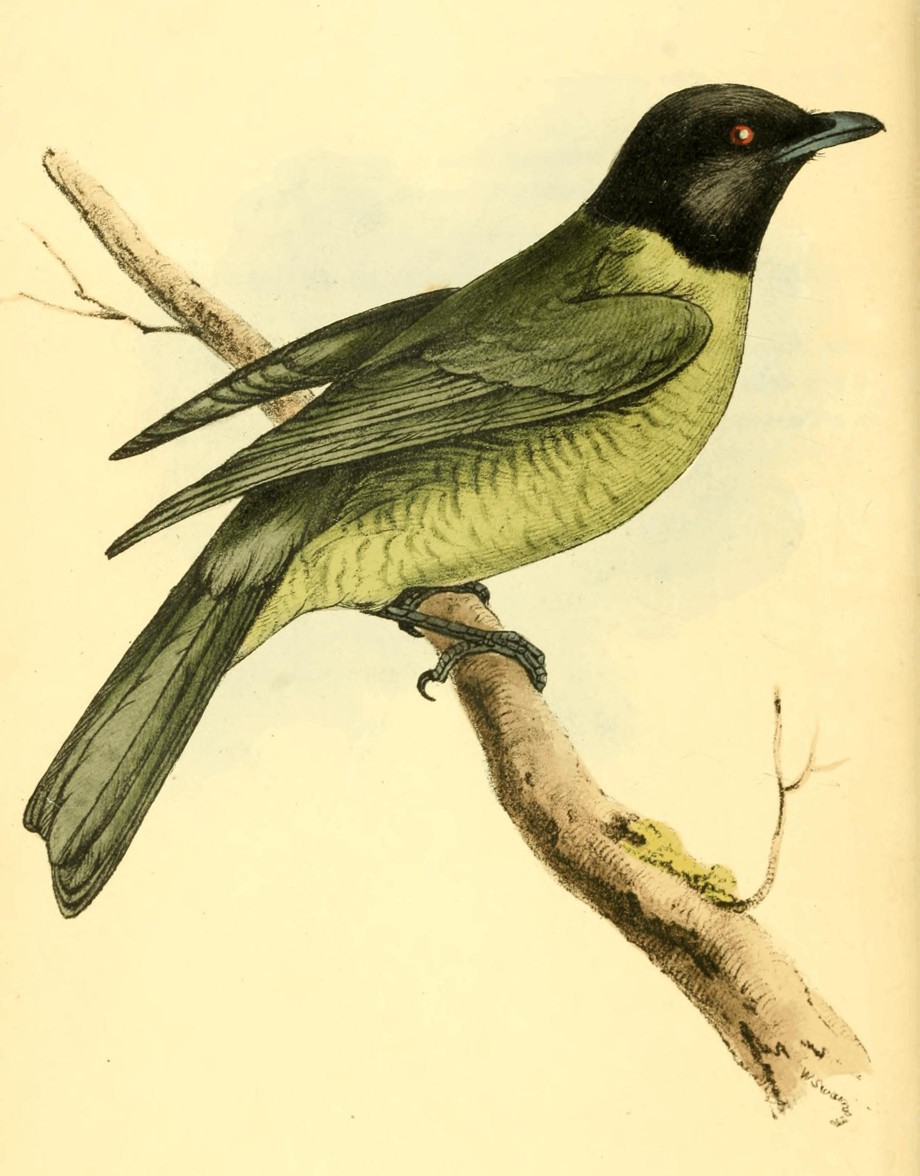
PROCNIAS melanocephalus.
Black-headed Berry-eater.
Generic Character.—See Pl. 21.
Specific Character.
P. oliva-viridis, subtus flavescens, striis fuscis transversis,
capite omnino nigro.Olive-green, beneath yellowish, with dusky transverse striæ. Head
entirely black.
Another new and very rare bird of this singular genus, inhabiting,
like all the other species, the tropical regions of America. I met with
it in Brazil but twice in the forests of Pitanga, not far distant from
Bahia; and my hunters were at a loss for its name, never having seen it
before: the eyes in the fresh bird are of a beautiful crimson.
Its total length is nine inches and a quarter; the bill is nine lines
from the gape to the tip, and four from the base of the nostrils, at
which part the bill is not so proportionably broad as in the Swallow
Berryeater (pl. 21.): the colour blueish-black,
paler at the base: the whole head, sides, chin, and part of the throat
are black, the feathers of the crown a little lengthened and pointed,
giving a slight appearance of a crest: the wings and tail are dusky-black
on the inner shafts and green on the outer; the whole of the upper
plumage olive-green, and of the under pale greenish-yellow crossed with
short dusky transverse lines from the breast downwards; under wing and
tail-covers the same. Tail four inches from the base, slightly
divaricated, and of twelve feathers. Wings four inches and a half, the
first quill very short, the third, fourth and fifth of equal length. Legs
black.
This was a male bird: the female I have not seen.
Pl. 26
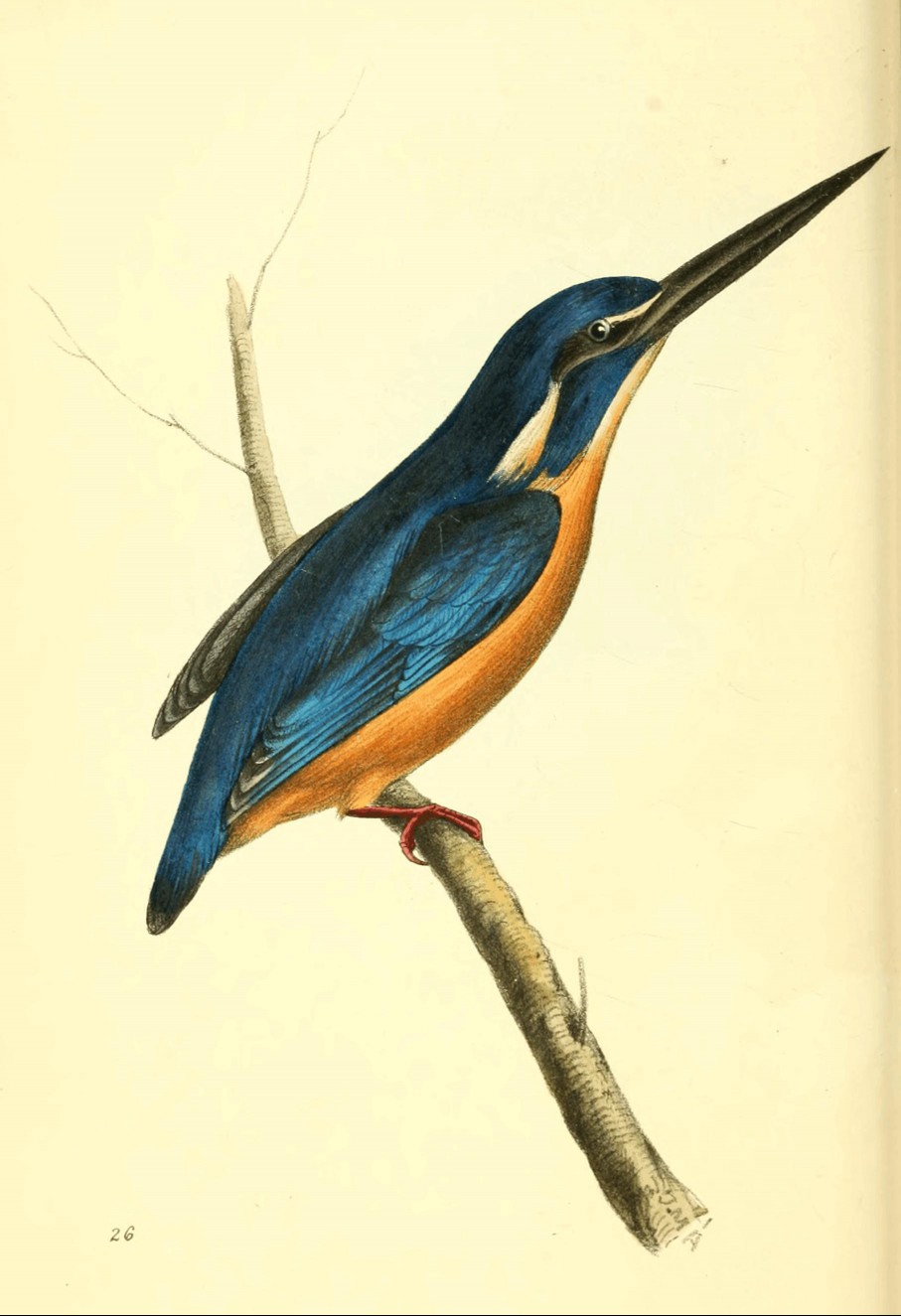
ALCEDO azurea.
Azure Kingsfisher.
Generic Character.
Rostrum longissimum, rectum, attenuatum, altius quam latius, in
totum compressum, mandibulis carinatis; marginibus lateralibus leviter
inflexis. Nares basales, membrana tectæ, apertura nuda, lineari, obliqua;
cauda plerumque brevissima. Pedes gressorii, digito antico interiore
minimo aut nullo.
Typus Genericus Alcedo ispida. Linn.
Bill very long, straight and attenuated, higher than broad, compressed
the whole length, both mandibles carinated, the margins slightly bent
inwards. Nostrils basal, covered by a membrane; the aperture linear,
oblique, and naked. Tail mostly very short. Feet gressorial, inner
fore-toe small or wanting.
Generic Type Common Kingsfisher. Lath. Bewick, &c.
Specific Character.
A. Corpore suprà, capitis lateribus colloque nitido cyaneis; subtus
rufis; mento gulaque albescentibus, alis nigricantibus; digito antico
interiore nullo.Body above, sides of the head and neck shining mazarine blue; beneath
rufous; chin and throat whitish; wings blackish; inner fore-toe
wanting.
Alcedo azurea. Azure Kingsfisher. Lath. Synop. Suppl. ii. p. 372.
Lewin's Birds of New Holland, fasc. i. pl. 1.Alcedo Tribrachys. Tridigitated Kingsfisher. Shaw in Gen. Zool.
viii. 1. 105.
The Kingsfishers have such a general similarity of form, that the most
casual observer is able to distinguish them: a very long straight bill,
short wings, and (in general) a shorter tail with very small legs, are
the prominent distinctions of such as are usually seen; and the richness
of plumage that generally pervades them cannot be better exemplified than
in our own beautiful species, the common Kingsfisher, not unfrequent in
many parts of England.
These birds, hitherto placed in systems under one genus, nevertheless
contain two distinct groups differing materially in the construction of
that primary organ of supporting life, the bill; and in their physical
distribution, or the countries they respectively inhabit, two most
important considerations in the natural arrangement of animals under the
present elevated views of the philosophic zoologist, with whom the study
of Nature consists no longer in the study of words, the retention of
names, or even the accurate description of species.
These considerations have induced me to form these birds into two
genera, the definitions of which are now given: those retained under the
old genus of Alcedo appear to be scattered (though sparingly) in
every part of the old and the new world. Their bills seem formed for
swallowing their food more in an entire state, similar to the Herons. In
each of these genera one species exists with only three toes, a
remarkable circumstance, which in an artificial system would endanger
their being united in a separate genus; but which, from the remarkable
smallness of the inner toe in all the other species, cannot I apprehend
point out any peculiarity either in their habit or economy: and this
opinion I find is likewise entertained by Professor Temminck.
Total length seven inches and a quarter. Bill from the gape two inches
one line, the upper mandible rather longest, and both with a slight
appearance of a notch; the colour black. All the upper plumage, as well
as the sides of the head, ears, and stripe beyond, fine ultramarine blue,
more vivid on the rump and tail-covers, and duller on the tail,
wing-covers, and lesser quill-margins; front blackish; from the nostrils
to the eye a whitish line, and from the ears on each side the neck a
whitish stripe, which almost forms a collar round the nape.
Quill-feathers sooty black. All the under parts orange ferrugineous;
throat and belly nearly white. Tail very short, nearly hid by the upper
covers. Feet red, claws black. The inner fore-toe wanting, but a slight
rudiment of it exists in my specimen.
Since writing the above, I find this bird is figured and described in
a beautiful work commenced by Lewin on the birds of New Holland, which
Mr. Brown, the learned possessor of the Banksian library, pointed out to
me. I believe but a few copies are known. Lewin observes, "it inhabits
heads of rivers, visiting dead trees, from the branches of which it darts
on its prey in the water beneath, and is sometimes completely immersed by
the velocity of its descent."
Dr. Latham has very well described it, but quite overlooked the
construction of the feet.
Pl. 27
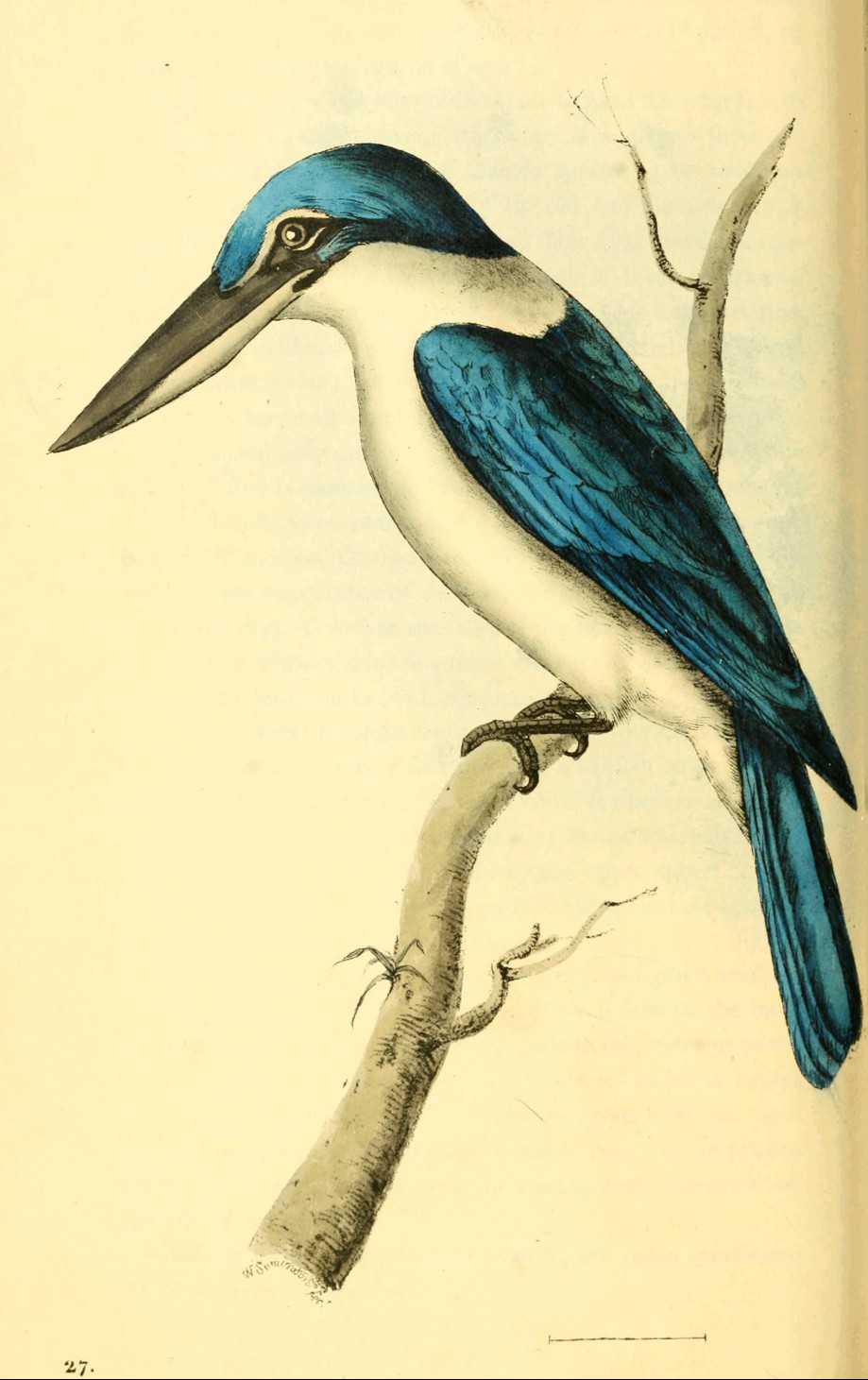
HALCYON collaris.
Collared Crabeater.
Generic Character.
Rostrum longissimum, rectum, validum, ad basin latius quam altius,
lateribus tetragonis; mandibula superiore rectissima, ad basin rotundata;
inferiore carinata, recurvata, margine superioris inferiorem obtegente. Nares basales, membrana tectæ, apertura
nuda, lineari obliqua. Cauda plerumque mediocris. Pedes gressorii, digito
antico interiore minimo aut nullo.
Typus Genericus Alcedo Senegalensis. Linn.
Bill very long, straight, thick, the base broader than high; the sides
tetragonal; upper mandible very straight, the base rounded; under
mandible beneath carinated and recurved, the margins covered by those of
the upper. Nostrils basal, covered by a membrane, the aperture naked,
linear and oblique. Tail mostly moderate. Feet gressorial: interior
fore-toe small or wanting.
Generic Type Crabeating Kingsfisher. Latham.
Specific Character.
H. viridi-cærulea; corpore subtus, lunulaque cerviculi
albis.Greenish-blue. Body beneath and nuchal collar white.
Alcedo collaris. Latham Index Ornith. i. 250.
Sacred Kingsfisher, Var. D. Latham Syn. ii. p.
623.Collared Kingsfisher. Gen. Zool. viii. i. p. 80.
Referring to the observations we have already made on Kingsfishers
generally, it will be only necessary to observe, that the species now
formed into the genus Halcyon appear entirely excluded from the
American continent: their bills are much stronger, thicker, and more
rounded than the genuine Kingsfishers, and the under mandible beneath
invariably carinated and curving upwards. One of them (the Alcedo
Senegalensis of Latham) is known to feed on crabs, the breaking and
disjointing of which this structure seems admirably calculated to
accomplish; and although some authors mention insects also as their food,
I apprehend it is only in the absence of other larger prey more suited to
the construction of their bills.
Total length eight inches and a half. Bill two inches three lines from
the gape, and one inch three quarters from the nostrils; upper mandible
and margin and lip of the lower, black, the rest yellowish-white. The
general plumage above is pale and changeable greenish-blue, the green
predominating on the scapulars, head and tail; the upper part of the neck
is crossed by a white collar, separated from the green of the head by a
narrow margin of black, which passes on the ear-feathers round the nape;
a narrow whitish line runs from the nostrils to the eyebrows, and another
very short one is beneath the eye; the whole of the under plumage white.
Quills black edged with blue, the second, third and fourth equal and
longest. Wings four inches and a quarter. Tail even, near three inches
long, above blue-green, beneath black. Feet dusky; middle and outer claws
much longer than the leg.
Inhabits Java and other parts of India, and is I believe unfigured.
The line at the bottom of the plate is on the scale of an inch.
Since writing the above, Temminck's new edition of the Manuel
d'Ornithologie has just reached me, in which I perceive he has
continued the birds of this genus under that of Alcedo, observing
that their plumage is always shining, and that he can find no characters
for their geographic distribution: yet, notwithstanding the opinion of
this eminent ornithologist, a close attention will I believe prove,
first, that no species of Linnæan Alcedo bearing the characters of
Halcyon have yet been discovered as natives of America; and
secondly, that species of genuine Alcedo will be found with
plumage quite devoid of any bright or shining colours. One or two exist
in my own cabinet, but to which I cannot now refer.
The situation of Halcyon will be between Alcedo and
Dacelo; from the last of which it is distinguished by its
perfectly straight, acute, and entire upper mandible, which, on the
contrary, in Dacelo is notched, the tip bent and obtuse.
Pl. 28

HESPERIA Haworthiana.
Haworth's Hesperia.
Generic Character.
Antennæ mediocres vel elongatæ, rectæ, graciles; clava
subterminali, brevi, crassata, cylindracea; unco abrupto, brevi,
acuminato. Palpi in fronte compressi, incurvati, lateribus convexis vel
angulatis, articulo ultimo erecto, verticali. Alæ (sedentes)
erectæ.
Divisiones.
III. Palpi lati, in fronte
compressissimi. Antennæ breves, clava crassissima.III. Palpi pene quadrati,
crassissimi. Antennæ elongatæ.III. Palpi articulo ultimo longiore, gracile. Antennæ
mediocres.
Typus Genericus Hesperia Comma Auctorum.
Antennæ moderate or elongated, straight, slender, the club nearly
terminal, short, thick, cylindric, ending in an abrupt, short and pointed
hook. Palpi compressed, incurved in front of the head, the sides convex
or angular; the last joint erect, pointing vertically. Wings when at rest
erect.
Divisions.
III. Palpi broad, very compressed in front. Antennæ short, the club very thick.
III. Palpi nearly square, very thick. Antennæ elongated.
III. Palpi with the last joint lengthened, slender. Antennæ
moderate.
Generic Type Hesperia Comma of Authors.
Specific Character.
Hesp. (Div. 2.) alis suprà nigrescente-fuscis, basi
nitido-cæruleis, anticis fascia mediali hyalina, posticis subtus fuscis,
lineis duabus longitudinalibus viridi-flavis; pedibus
fusco-aurantiis.Hesperia (Div. 2.). Wings above blackish-brown, the base shining blue;
anterior with a medial hyaline band; posterior beneath brown, with two
longitudinal yellow-green lines. Legs brownish-orange.
The celebrated Latreille, the father of modern Entomology, has well
observed, that the immense number of insects crowded together in the
genus Hesperia contain many natural genera, but which the paucity
of species generally found in cabinets prevents us from discriminating.
Having for a long time paid attention to this family, and possessing near
300 species in my own cabinet, I have had the opportunity of attempting
their elucidation; and the above generic character is applied to those
insects only which I propose considering genuine species of the genus
Hesperia, and which will comprise near 170 species.
I have named this new, undescribed and very rare insect, in honour of
my esteemed friend A. H. Haworth, Esq. F.L.S., &c., well known by the
benefits his writings have conferred on the sister sciences of entomology
and botany. The only two insects I ever saw of this species I captured in
the southern part of Brazil.
Pl. 29

MITRA cancellata.
Basket Mitre—upper figure.
Generic Character.—See Pl. 23.
Specific Character.
M. (Div. 2.) testa fusiformi, cancellata; striis longitudinalibus
incrassatis, spira aperturaque æqualibus; columella 5-plicata; spira
sublævi.Shell fusiform, cancellated, the longitudinal striæ thickened; spire
and aperture of equal length; pillar five-plaited; spire nearly
smooth.
Another undescribed species of this elegant family, and of great
rarity, in the private collection of Mr. G. Humfreys. The whole of the
body whorl and commencement of the spire is cancellated. The longitudinal
striæ are crowded, thickened, and slightly elevated, giving a crenated
appearance to the suture: the transverse striæ slender, and filling up
the interstices. The spire is nearly smooth and a little bent: the ground
colour very light orange, with three darker interrupted bands on the
body: whorl separated by two slender lines of the same colour; the spiral
whorls have only two bands and a line between; the upper margins slightly
compressed on the suture; the outer lip within smooth.
MITRA rigida.
Ribbed Mitre—middle figures.
Specific Character.
M. testa costis longitudinalibus, elevatis, linearibus, integris,
interstitiis lævibus ad basin granulatis; spira producta; columella
4-plicata; apertura brevi.Shell with elevated, longitudinal, obtuse, entire ribs, the
interstices smooth, the base granulated; spire lengthened; pillar
four-plaited; aperture short.
Equally rare, and from the same collection as the preceding. In habit
it approaches nearest to M. exasperata of Chemnitz, but has not
the ribs angulated or their interstices striated, and is much more
narrowed at the base than in that shell, which I have seen: the outer lip
is also smooth; the inside strongly striated. This shell was formerly in
the collection of Mr. Keate, the elegant author of the "Sketches from
Nature."
Pl. 30

ACHATINA marginata.
Marginated Achatina.
Generic Character.
Testa ovata, vel oblongo-ovata, spira elevata, apertura subovale.
Columella lævis, simplex, ad apicem truncata; labium externum tenue,
internum inflexum integrum; umbilicus nullus.
Typus Genericus Bulla Achatina. Linn.
Shell ovate, or oblong-ovate; spire elevated; mouth nearly oval.
Columella smooth, simple, truncated. Outer lip thin; inner lip entirely
inflexed. Umbilicus none.
Generic Type Bulla Achatina. Linn.
Specific Character.
A. testa ovato-oblonga, strigis inæqualibus ferrugineis; spira ad
apicem obtusa, 5-voluta; sutura depressa linea sulcata marginali.Shell ovate-oblong, with irregular ferrugineous stripes; spire obtuse
at the top, of five volutions; the suture depressed, with a marginal
indented line.Lister 579. fig. 34. Gualt. pl. 45. B.
Knorr, vol. iv. tab. 24. 1. (badly coloured.)
The largest shells hitherto discovered as inhabiting the dry land
belong to this genus, instituted by the celebrated Lamarck, but still
divided by the strict followers of Linnæus between the Bullæ and
Helices, with a singular infelicity of even artificial
arrangement. The simple characters peculiar in a greater or less degree
to all, will readily distinguish them; and I apprehend most of the
species of the first division (which includes the present) will be found
to inhabit only the African continent, while Bulla virginea and
the smaller shells placed in the second division are found principally in
the new world; where also two or three gigantic species of Bulimus
occupy the place of the larger African Achatinæ.
Of these, the shell now figured is one of the rarest, and has hitherto
been overlooked as a variety of the Linnæan Bulla Achatina; the
colour of both is subject to much variation; but this will be found at
best a most indecisive and vague character for specific distinction when
unaccompanied by others more important and connected with the formation
of shells. I have therefore not hesitated in making this a distinct
species, from having had the means of examining at different times near
twenty specimens, all of which presented the following characters. Spire
of five whorls, the last or terminal one very small and flattened; the
apex obtuse; the suture depressed, as if flattened on the shell, and
margined by one or sometimes two indented lines, parallel, and at the top
of each whorl. In the colour of its mouth it varies in sometimes having a
tinge of rose-colour at the base and top of the spire, but the mouth is
more generally white. The body whorl is more or less ventricose; the
outer lip is a little reflected, and the whole shell, when full grown,
much thicker and heavier than any of the other species. The epidermis is
yellowish-brown, beneath which the shell is nearly white, beautifully
marked with broad remote stripes of chesnut, with others more slender
(and sometimes broken into spots) between. I have another specimen which
agrees tolerably with Lister's figure in being more than usually
ventricose, and which I think is accidental. The only constant variety
appears to be that figured by Knorr, ii. tab. 3. fig. 1. having the spire
entirely rose-colour.
The marginal line and the correct number of whorls in the spire are
well expressed in the figures of Lister, Gualtieri and Knorr. The first
of these figures is accidentally more ventricose; the second, like all
the other figures of Gualtieri, is defective at the apex; and Knorr's I
suspect has been outrageously coloured from the real pink-mouthed
Achatina.
It inhabits the coast of Guinea; and I am informed the animal is eaten
by the natives.
Pl. 31
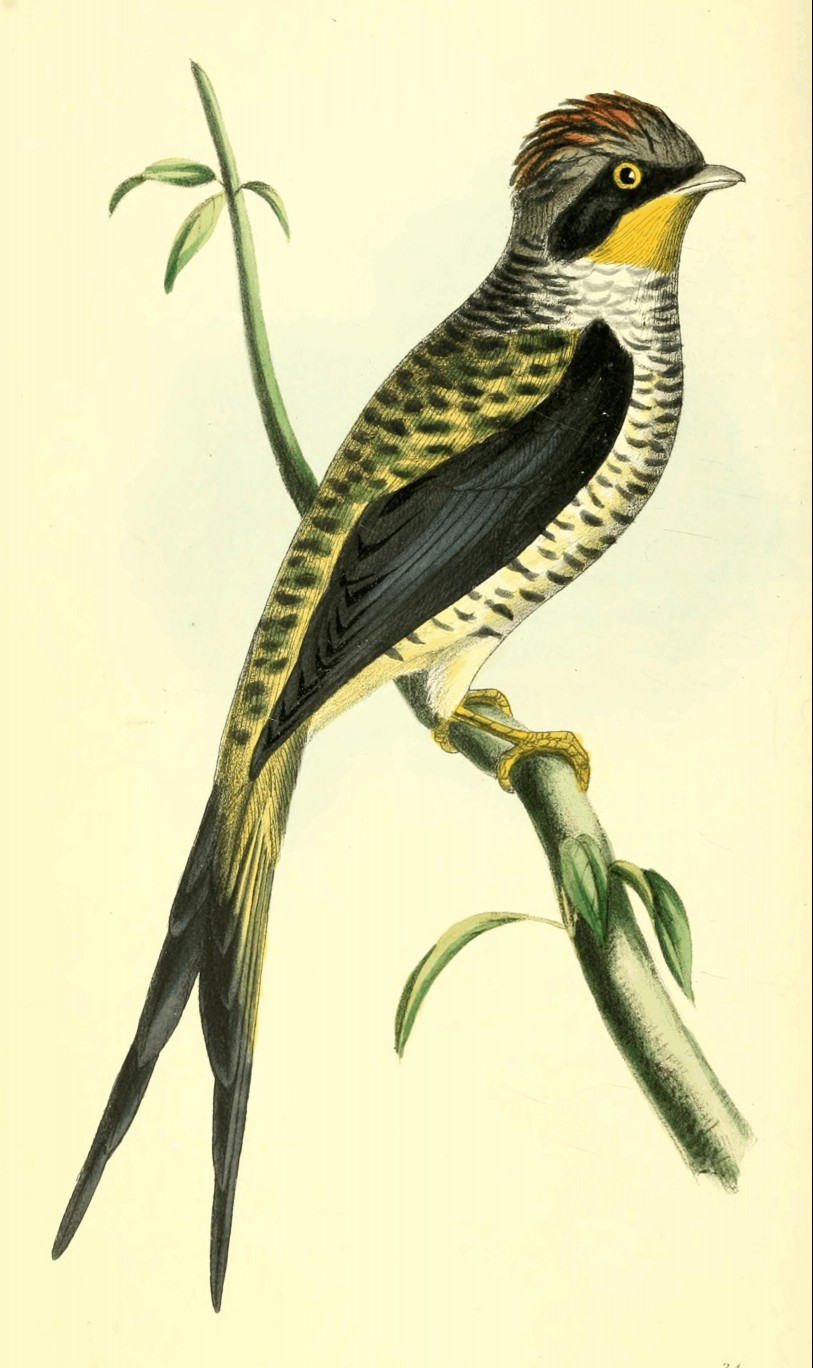
PHIBALURA cristata.
Crested Shortbill.
Generic Character.
(Phibalura Vieillot.)
Rostrum brevissimum, trigonum, latius quam altum; mandibula
superiore culmine subcurvata carinata; inferiore recta; utrisque
marginatis. Nares basales, simplices, subrotundæ, plumulis densis
incumbentibus in totum obtectæ. Rictus ampli, infra oculos aperientes.
Alæ attenuatæ, remigibus spuriis nullis. Cauda elongata, furcata,
rectricibus duodecim. Pedes insidentes, digitis anticis æqualiter fissis,
ad basin subconnexis.Bill very short, triangular, broader than high; upper mandible above
slightly curved and carinated; lower mandible straight, both notched.
Nostrils simple, basal, roundish, entirely concealed by thick-set
incumbent feathers. Mouth large, opening beneath the eye. Wings pointed;
spurious quills none. Tail elongated, forked, of twelve feathers. Feet
formed for sitting; the fore-toes equally cleft and slightly connected at
their base.
Specific Character.
P. corpore supra nigro flavo variegato; subtus albo, fasciis nigris
transversis; mento flavo, capitis crista rufa nigro variegatâ, alis caudaque elongata furcata chalybeis,
immaculatis.Above black varied with yellow; beneath white, with transverse black
bands; chin yellow. Head crested, the feathers rufous, varied with black.
Wings, and elongated forked tail raven-black, immaculate.
For this beautiful and extraordinary bird I am indebted to Miss E.
Yeates, of the Dingle near Liverpool, who received it from South America.
Its general habit clearly points it out as belonging to the
Baccavoræ or Berryeaters, apparently connecting the genera
Procnias and Pipra, where Temminck with much judgement has
also placed it, in the new edition of his Manuel d'Ornithologie
just received, and before reading which I had considered the genus as
unpublished.
The total length is nine inches, of which the tail occupies four and a
half. The bill is whitish, and is remarkably short, measuring only three
lines from the nostrils to the tip, but three quarters of an inch from
the angle of the mouth, which opens just under the eye: the plumage is
singularly variegated: the crown of the head is furnished with a crest,
which, when not elevated, is scarcely seen, and appears a deep glossy
black mixed with grey and rufous; but when erected it is very
conspicuous, and all the feathers are bright rufous tipt more or less
with black; the upper sides of the head grey, the lower part and ears
deep-black; the neck above is greyish-white, with blackish transverse
lines: the back, scapulars, rump and tail-covers are varied transversely
with olive, shining black, and bright yellow, each feather being olive at
the base, black in the middle, and yellow at the tip. Beneath the
feathers of the chin and part of the throat are somewhat lengthened,
semi-setaceous, and of a bright yellow; the neck and breast are white,
with two transverse lines of deep black on each feather; these lines
diminish, and are broken into spots on the body, and nearly disappear on
the vent: the edges of the breast-feathers are tipt with yellow, which
colour increases downwards on the vent and tail-covers, which latter are
entirely yellow. The wings are four inches long, uniform deep black with
a blue gloss, much pointed, and calculated for rapid flight. Tail the
same colour, the exterior basal margins olive: all the feathers are
narrow, pointed, and gradually lengthening, the middle pair being two
inches three quarters longer than the outer pair, which exceed those next
them by an inch. The feet are very pale yellow, and three-quarters of an
inch from the knee to the claws, the three foremost of which are equally
connected together (though slightly) nearly as far as the first joint;
the outer and inner toes equal, and rather shorter than the hind-toe:
claws slender and much compressed.
Whether this species is the same as the one mentioned by Temminck as
existing in the French Museum under the name of P. flavirostris,
it is quite impossible to say, as the description of that bird has never
been published. This leads me to notice a custom several naturalists of
the present day have lately adopted, of publishing names, and names only,
of new or undescribed animals, which they then wish to be considered as
permanently fixed, and as having thus secured to themselves all the merit
of first describing. Now this at best is but a surreptitious path to
fame, and in many instances bears the appearance of originating in a
petty vanity, quite beneath the dignity of true science: it is easily
fixing a name to an object which we have not before seen, or suspect may
be new, without the trouble of investigating authors and comparing
synonyms: the name may remain, but if it should afterwards be discovered
as hasty and erroneous, its author is in no way amenable to the opinions
and criticisms of others, for they cannot discover such mistakes when no
clue is given them beyond a name, which may frequently be applicable to
half a dozen species. If, on the other hand, the object is really new,
the scientific world is still in the dark, for without a description the
name conveys nothing. Besides this, it has a tendency to deprive those
writers of their well-earned merit, who undergo the laborious but
necessary investigation of books, the examining and comparing of
specimens, and the construction of sound characters previous to their
publishing a new addition to the great volume of Nature. Against this
scientific monopoly a stand should be made, and all names either
of families, genera, or species should be totally rejected, unless their
meaning is clearly defined. Let those who run the race, receive the
wreath; and not let it be snatched from the winning-post by another, who
jumps from behind and claims it as his own.
On a careful examination of my specimen, I find the nostrils are not
covered by a membrane, as observed by Temminck, but are open, obliquely
and ovately round, and a narrow rim round the margin. That excellent
ornithologist likewise remarks that the first and second quill-feathers
are the longest; but my bird (which, however, is in full plumage) has the
first and third of equal length and shorter than the second, which is
longest. These nice distinctions lead me to suppose the species from
which his generic character was taken, is distinct from this.
Pl. 32
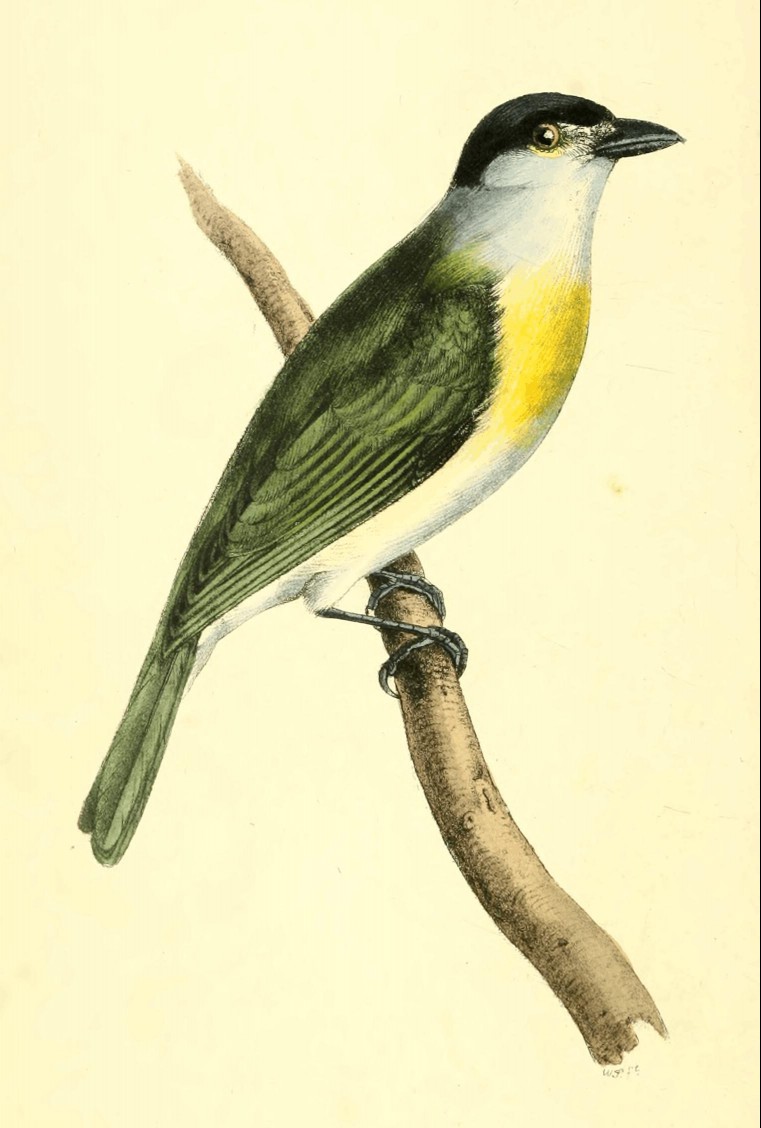
PSARIS Cuvierii.
Cuvier's Psaris.
Generic Character.
Rostrum validum, crassum, conicum, basi rotundatum, versus apicem
leviter compressum, culmine convexo non carinato; mandibulis emarginatis,
superiore apice adunco. Nares basales, simplices, rotundæ, juxta marginem sitæ,
basi paucis plumulis setaceis incumbentibus. Pedes simplices, tribus
digitis anticis æqualiter fissis. Remiges spuriæ nullæ. Cauda brevis:
rectricibus duodecim æqualibus.
Typus Genericus Lanius cayanus. Linn., Lath., &c.
Bill strong, thick, conic, the base rounded, towards the top slightly
compressed, the top convex, not carinated; both mandibles notched, the
tip of the upper hooked. Nostrils basal, simple, round, situated near the
margin, the base with a few short incumbent setaceous feathers. Feet
simple, the three fore-toes equally cleft. Spurious quills none. Tail
short, of twelve equal feathers.
Generic Type Lanius cayanus. Linn., Lath., &c.
Specific Character.
P. olivaceus, subtus albidus; capite suprà nigro; occipite
temporibus et colli lateribus cinereis; pectore lateribus tegminibusque
infernis flavis.Olive, beneath whitish; crown black; nape, sides of the head and neck
pale cinereous; breast, sides, and under wing-covers yellow.
The genus Psaris was first instituted with great propriety by
Cuvier; and before the discovery of the species now made known, was
supposed to consist of only one, the Cayenne Shrike of Latham, which with
the present bird (named in honour of the first zoologist of the age) is
found in Brazil. The figure is nearly of the natural size.
Total length five inches and a half. Bill blueish, three quarters of
an inch from the angle of the mouth, and four-tenths from the nostrils,
which are ovately round, rather large, and simple, being entirely devoid
of an external membrane, but the base is partially covered with small
thick-set, short, setaceous feathers; between the eye and base of the
bill are a few weak and short hairs; the upper part of the head, as far
as the nape, is capped by deep-black, having a blueish gloss: between the
nostrils and the eye, as well as on the chin and throat, the colour is
white, which changes to a pale cinereous grey on the sides of the head
and round the neck; the ears at their base and margin of the eye tinged
with yellow; the rest of the upper plumage yellowish-olive. The under
plumage on the lower part of the neck and breast, the sides, and the
inner wing-covers are clear yellow, and from that to the vent white.
Wings two inches long, the quills brown, margined externally with olive
and internally with yellow; the first and second quill progressively
shorter than the third and fourth, which are of equal length. Tail short,
slightly divaricated; olive, with whitish marginal tips. Legs
blueish-black; the three fore-toes are equally cleft, but a membrane will
be found connecting them equally at the base nearly as far as the first
joint.
Temminck must be mistaken in giving as a generic character to this
genus, that the external toe is connected to the middle one as far as the
first joint, and the inner toe cleft to the base; at least such is not
the case either in my specimens of this bird or in those of the Cayenne
Shrike: and they have been carefully relaxed in warm water, the best
method of ascertaining such peculiarities.
Pl. 33
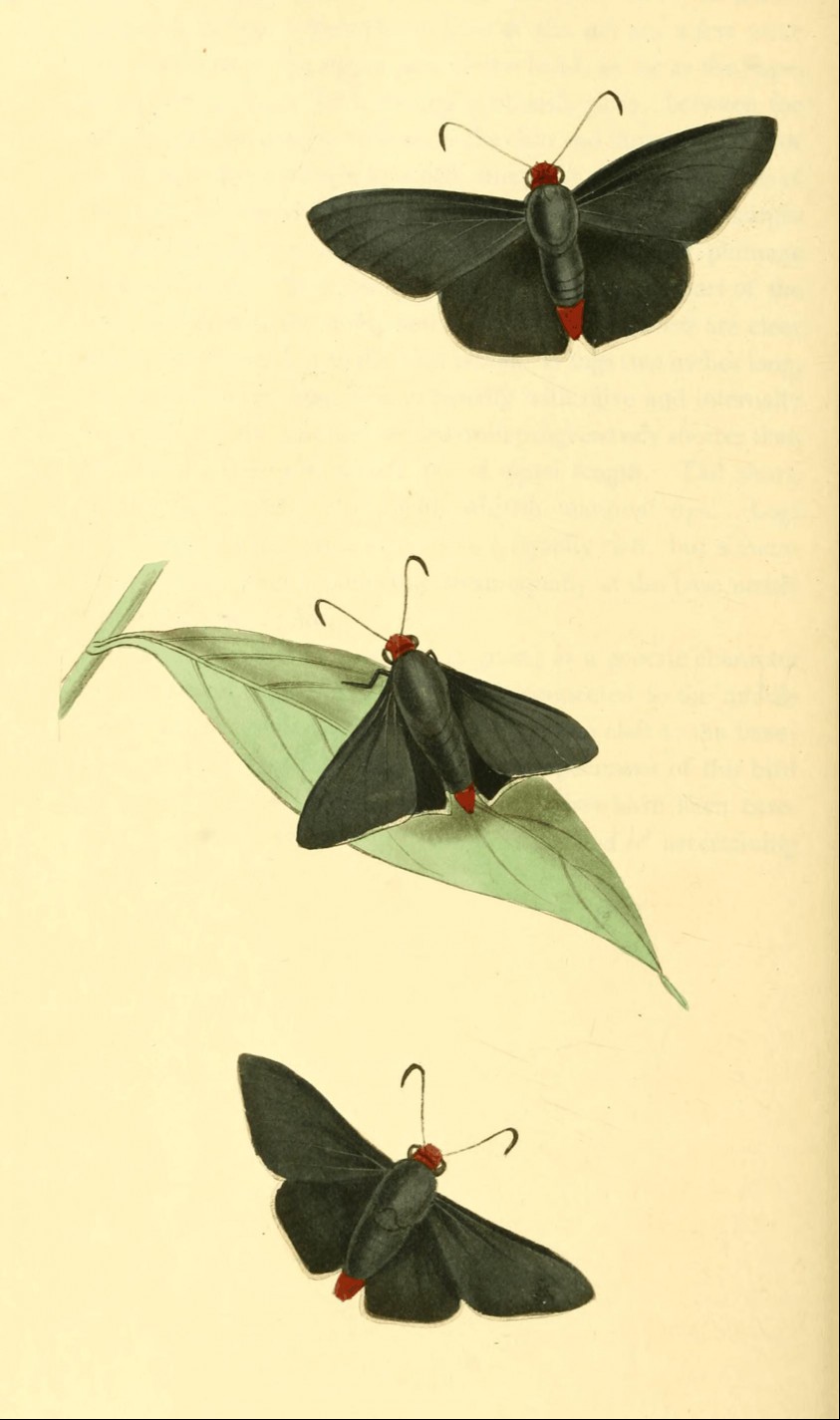
TAMYRIS Zeleucus.
Generic Character.
Antennæ arcuatæ, clava terminali, crassata, lineari, obtusa, in
fœminis graciliore attenuata. Palpi in fronte convexe-compressi,
supra linguam obvenientes, articulo ultimo minutissimo, crassato obtuso,
approximate, proclivi. Alæ breves, sedentes horizontaliter
divaricatæ.Antennæ arcuated; the club terminal, thick, linear, obtuse; more
slender and attenuated in the female. Palpi compressed convexly on the
front of the head, meeting above the tongue; the last joint very minute,
thick, obtuse, approximating and bent forward. Wings short, when at rest
horizontally divaricated.
Specific Character, etc.
T. Alis chalybeis concoloribus, margine albo; capite apiceque
corporis sanguineis.Wings uniform blueish-black, with a slender white margin. Head and top
of the body bright red.Hesp. Zeleucus. Fab. Ent. Syst. 3. pt. 1. p. 346.
no. 317.Obs. Donovan's Indian Insects, where that author
has figured it by mistake as a native of India.
This insect is the most common (although hitherto unfigured) of a
striking natural group belonging to the Hesperidæ; it has
therefore been selected as the best example for the genus I have now
formed them into. I have not seen more than twelve or fourteen species,
and these were all from different parts of South America, to which I have
no doubt the genus is exclusively confined. The club of their antennæ is
very thick, obtuse, and without any terminal hook. The bright red at the
end of the abdomen (improperly called by Fabricius the tail) is most
conspicuous in the female, which is also larger and having the wings more
obtuse, of which the upper and under surfaces are both alike.
The insects of this family fly with amazing rapidity (as is shown by
the thickness of their thorax, and the sharpness in the make of their
wings), generally frequenting openings of thick woods and alighting on
leaves where the sun strikes: I seldom saw them on flowers. Their wings
when at rest are half expanded in a horizontal direction. Their
metamorphosis is unknown.
This individual species is scarce in the northern parts of Brazil, but
common in the southern provinces.
Pl. 34

COLIAS Godartiana.
Godart's Colias.
Generic Character.—See Pl. 5.
Specific Character.
C. (Fœm.) alis flavescente-fulvis, anticis supra margine
punctoque rotundato medio nigris, subtus argenteo rufo 3-fisso, posticis
subtus puncto gemino argenteo margine nigro, uno quadrato; palpis
productis.(Female) Wings fulvous-yellow; anterior above with the outer margin
and round central spot black, which beneath is silvery rufous and
three-cleft; posterior beneath each with two silvery spots margined with
black, one of which is quadrangular. Palpi lengthened.
An inspection of a vast number of insects of this genus, with the
possession of nearly all the species noticed by authors, convinces me
that the insect now figured is perfectly distinct from any other. It is
in the cabinet of Mr. Haworth, who obligingly lent it me for comparison
and description, and is the only individual I have hitherto met with. The
prolongation of the palpi, which is even more obvious than in C.
Statira, is alone a specific distinction; and the form of the spots
both on the upper and under side differs very much in character from that
insect, with which it has the most affinity. It may be the Papilio
Drya of Fabr. (omitting his references); but his description, whether
intended for this insect or any other, is so vague that I can see no
advantage in retaining it. Of the two bright silver spots beneath, one is
oval, the other larger and quadrangular.
I have named it in honour of M. Godart, the intelligent coadjutor of
M. Latreille in the entomological part of the Encyclopédie
Méthodique.
Pl. 35
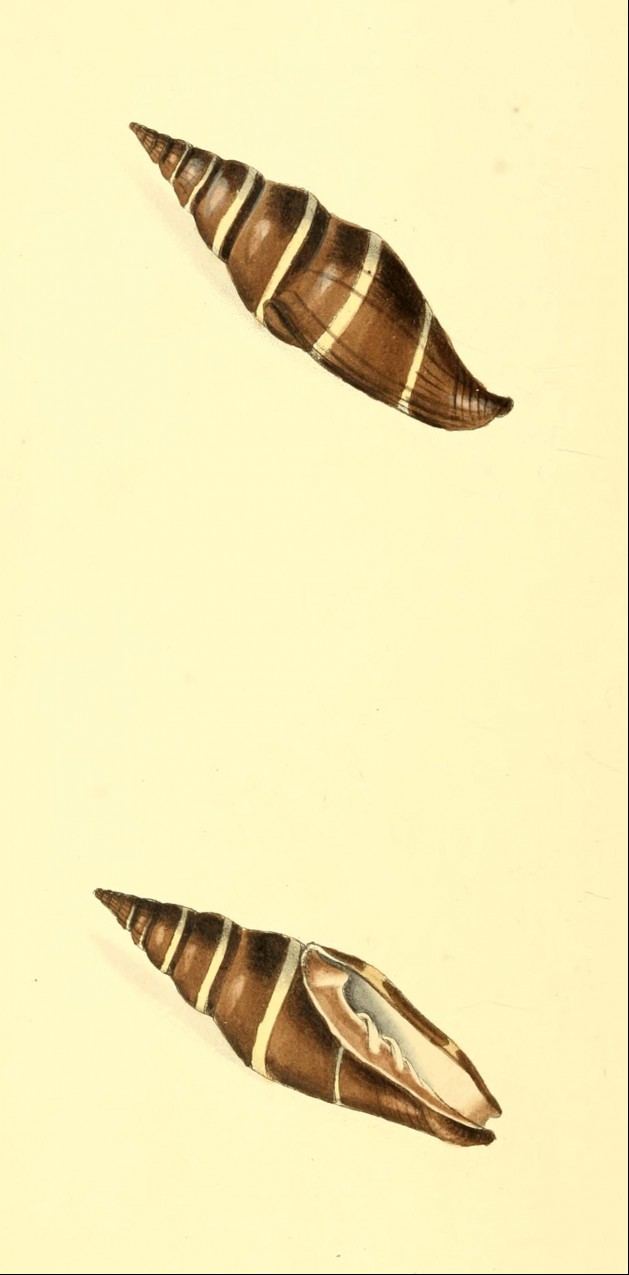
MITRA bifasciata.
Double-banded Mitre.
Generic Character.—See Pl. 23.
Specific Character.
M. (Div. 1.) testâ lævi, castaneo-fusca concolore, anfractu basali
fasciis duabus angustis flavescentibus, spirâ unifasciatâ aperturâ
lævi.Shell smooth, uniform chesnut-brown, with two narrow yellowish bands
on the basal whorl, and one on the spire; aperture smooth.
Voluta caffra. Martini iv. tab. 148. fig. 1369.
Knorr. vol. v. tab. 19. fig. 4, 5.
Seba Pl. 49. fig. 21, 22, 41.
This most elegant shell has been figured from one of the specimens
that belonged to the late Mr. Jennings, who was well known to spare
neither expense nor assiduity in procuring the most select and matchless
specimens of every species; so much so, indeed, that such as are known to
have been in his possession generally bear a higher price. One of these
is now in my father's cabinet, the other in that of Mrs. Bolton, of
Storr's-hall, Windermere. I have seen both, and they appear equally
fine.
I cannot help considering this as a distinct species from Mitra
caffra (Voluta caffra Linn.), with which it has hitherto been
placed only as a variety: it is much larger, the volutions more convex,
but compressed on the suture, and the whole shell (except near the point)
perfectly smooth: the beak or channel likewise, which in M. caffra
is short and nearly straight, is in this lengthened and recurved. The
mouth is very narrow (occasioned by the outer lip being thick and
slightly inflexed) and smooth within, the terminal volutions slightly
plaited, and the base of the shell grooved.
The figures of Knorr and Martini are very bad, and give no correct
idea of the shell, except its colour.
Pl. 36
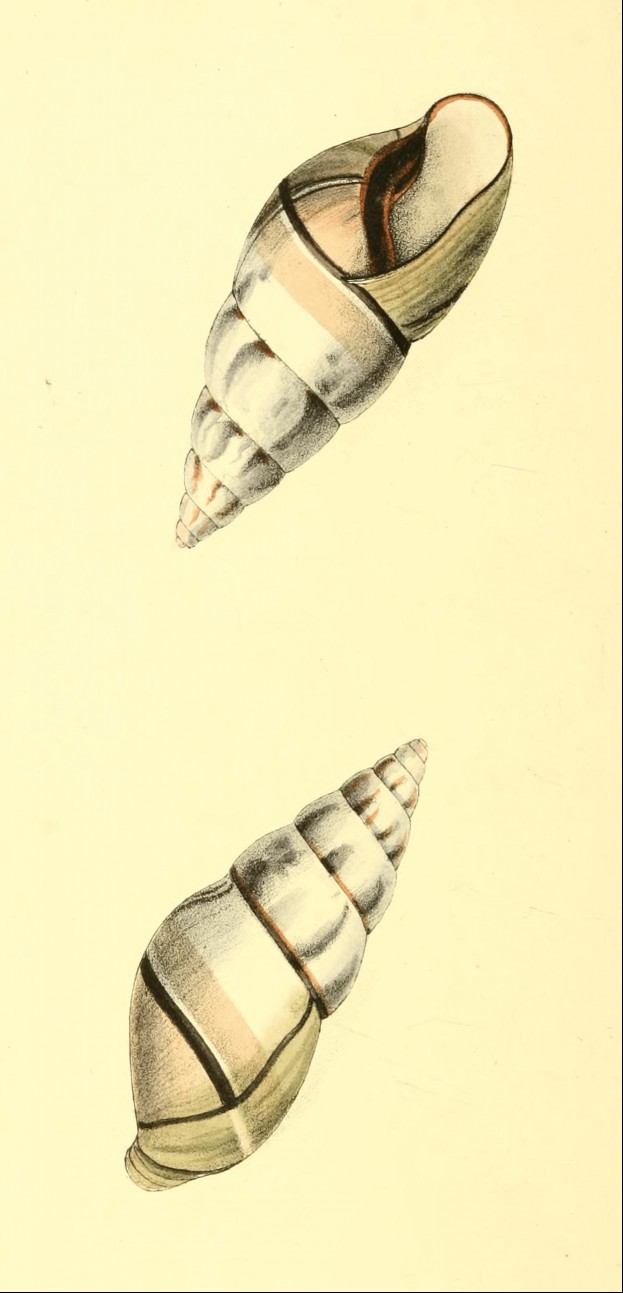
ACHATINA perversa.
Reverse Achatina.
Generic Character.—See Pl. 30.
Specific Character.
A. (Div. 2.) testâ aperturâ perversâ: spirâ productâ, 7-volutâ,
apice truncato; albida strigis nebulosis cinereis; linea transversa in
basali anfractu; columella margineque labii exterioris castaneis, apertura intus
alba.Aperture reversed: spire lengthened, of seven volutions, the apex
truncated, whiteish with clouded cinereous stripes; central band on the
basal volution, pillar, and margin of the outer lip chesnut; mouth within
white.
Reverse shells, or such whose mouth when viewed in front is on the
left side, are generally held in much estimation by collectors. This
deviation from the usual form of shells is sometimes accidental, as in
our common garden Snail and several others; while in some species it
appears a constant, and therefore a specific distinction. Such I
apprehend is the case with the shell now figured, a rare and very elegant
species, apparently not noticed by any writer; two or three existing in
the British Museum and one in my father's cabinet are all the specimens I
have hitherto seen. The latter (here figured) came from Bahia in South
America. The whole shell is very finely marked with longitudinal striæ,
and the colouring better seen than described: the buff tinge at the base
is occasioned by the remaining epidermis.
This shell belongs to the second division of the genus Achatina
as mentioned at Plate 30, having the aperture much
shorter than the spire and the base nearly entire. Bulla virginea
of Linn. seems to connect the two divisions, having the lengthened spire
of one and the truncated base of the other.
Pl. 37
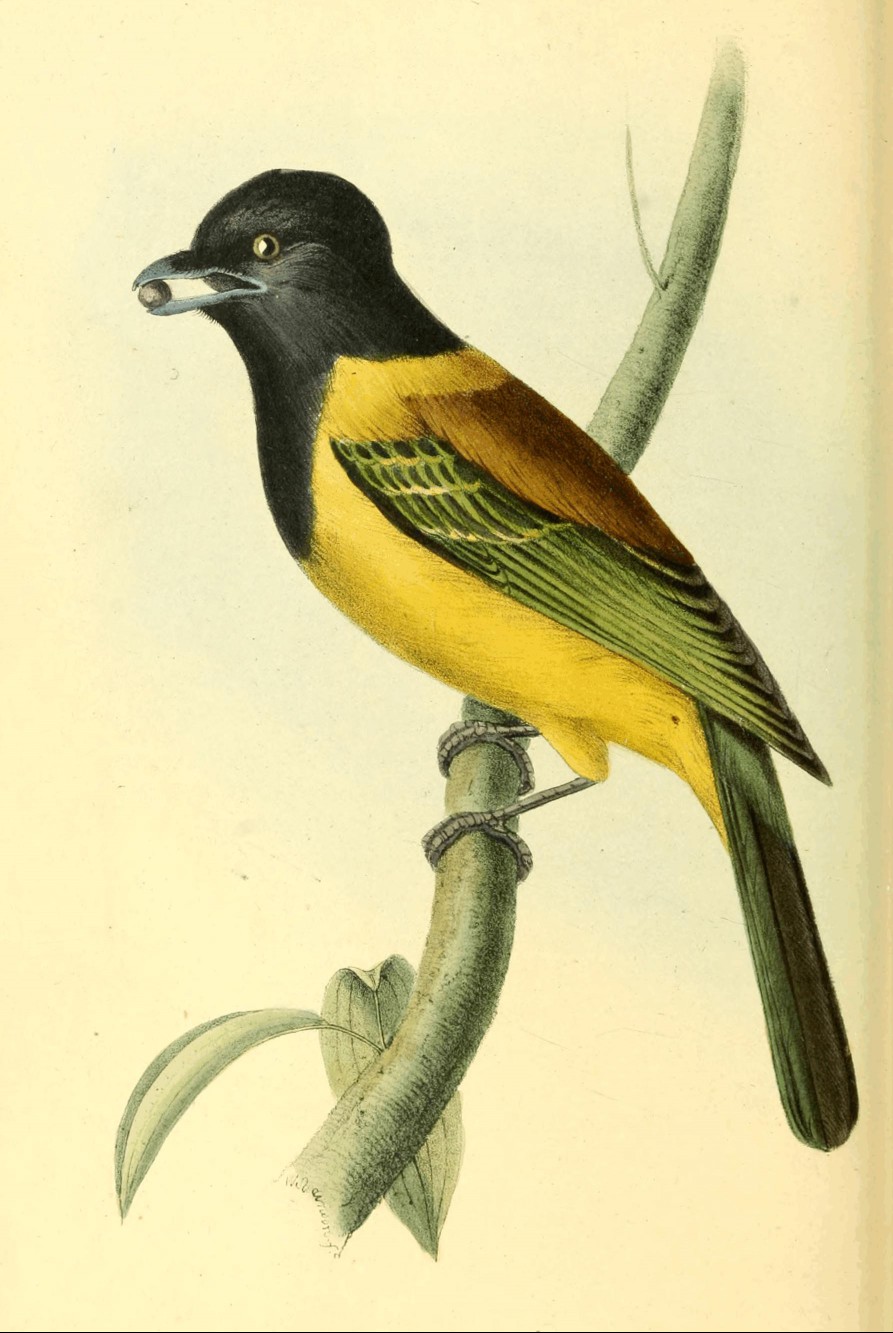
PROCNIAS cucullata.
Hooded Berry-eater.
Generic Character.—See Pl. 21.
Specific Character.
P. corpore, collo, pectore nigro cucullata; tergo fusco, alis
caudaque nigris; tegminum apice, pectoris lateribus, et corpore subtus
flavis; capite subcristato.Head, neck and fore-part of the breast hooded with black; back brown,
wings and tail black; tip of the wing-covers, sides of the breast and
body beneath yellow; head subcrested.
I am indebted for this new bird to Miss E. Yeates, who received it
with a few others from some part of Brazil: it seems to connect the
genera of Ampelis and Procnias, having the bill much less
dilated at the base than any of the latter; it however has a close
similitude to Procnias melanocephalus (Pl.
25.), which seems further removed from the true Chatterers.
Total length eight inches and three quarters. Bill in extreme length
near an inch; the colour dark cinereous; the base furnished with bristles
something resembling the Chatterers: the opening of the nostrils large,
round, terminal, and nearly naked; the feathers on the crown lengthened;
the whole head, neck, and fore-part of the breast black, bordered above
by a narrow collar of yellow; back and scapulars brown, rump olive; sides
of the breast, inner covers, and under parts uniform yellow; wing-covers
black margined with olive, those on the shoulders tipt with brown, the
rest with yellow; quills and tail black margined with olive. Wings four
inches and three-quarters long, the first quill very short, the third
longer than the second. Tail four inches long.
Pl. 38
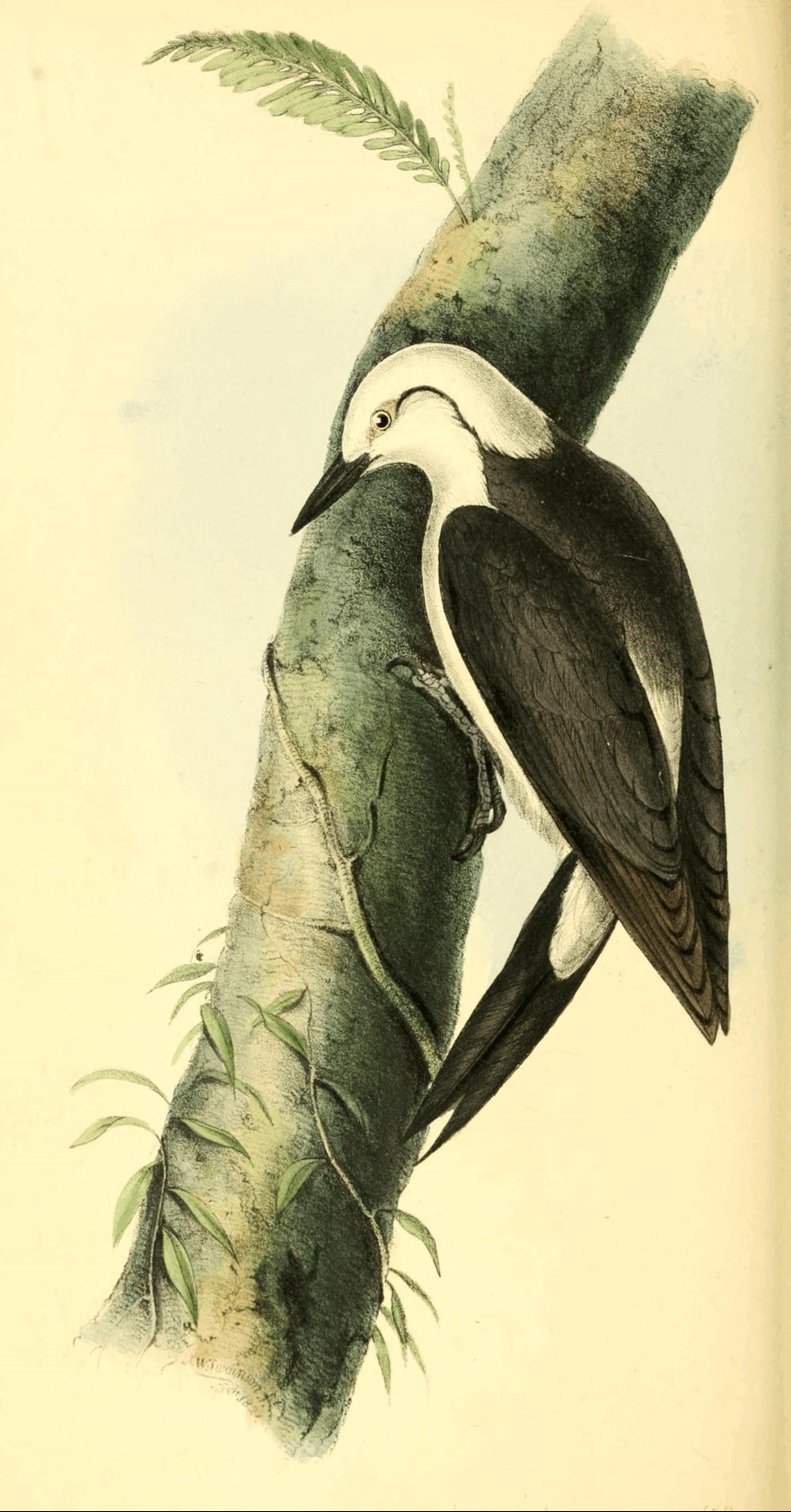
PICUS bicolor.
Black and White Woodpecker.
Generic Character.—See Pl. 14.
Specific Character.
P. albus, collo supra, tergo, alis, lineaque temporali nigris,
rectricibus nigris, basi maculisque marginis interioris albis.White: neck above, back, wings, and line from the ears to the nape,
black; tail-feathers black, with their base and spots on the inner margin
white.
The simplicity of colouring in the plumage of this bird will easily
distinguish it from among the numerous and intricate species already
known of this family. It is one of the new birds the recent
investigations of Brazilian zoology have added to our museums. The
individual here figured was sent me from the district of Minas
Geraies.
Total length eleven inches and a half. Bill from the upper base to the
tip one inch one line, and from the gape one inch four-tenths; the colour
blueish-black; the upper mandible above sharply carinated and slightly
curved; orbits (in the dead bird) yellowish-white; the whole of the head
and nape, sides of the neck, rump and tail-covers, and all the under
plumage pure white, with a tinge of yellow down the middle of the belly:
a narrow black line commences at the ears, and is carried down on each
side, joining the black of the upper neck; the wings and remaining upper
plumage are of a uniform dark sooty black; the tips of the quills much
paler and brownish. Wings six inches and a half long; the inside covers
black. Tail four inches, and black banded with white at the extreme base;
the two outer feathers on each side with alternate black and white bands
on the inner web their whole length; feet and claws dirty-greenish: this
was a female.
Pl. 39
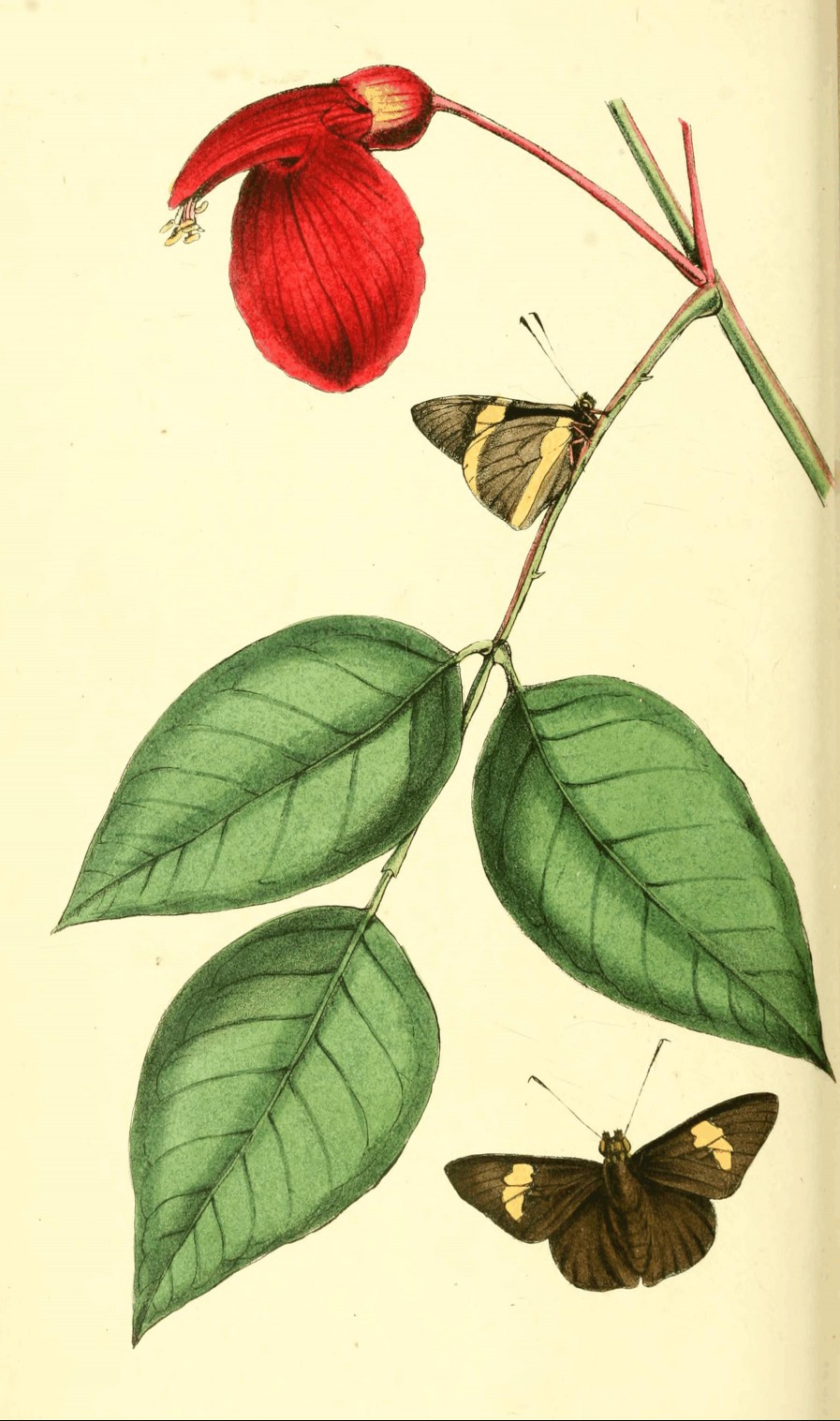
HESPERIA Itea.
Generic Character.—See Pl. 28.
Specific Character.
Hesp. (Div. 2.) alis supra nigrescente-fuscis, subtus pallidioribus
basi fulvis, anticis macula flava tri-fissa, posticis subtus margine
exteriore et linea longitudinali fulvis, femoribus rufis.H. (Div. 2.) Wings above blackish-brown, beneath paler, base fulvous.
Anterior with a three-cleft yellow spot. Posterior beneath with a fulvous
outer margin and longitudinal line. Thighs rufous.
The descriptions left by Fabricius of this as well as many other
extensive families of Lepidoptera, are in general so vague and
short, that unless a figure is quoted to elucidate them, it becomes
totally impossible to ascertain the precise species intended. Such is the
case with the present insect, which will not agree with any described by
Fabricius, or figured by Cramer.
During my travels in Brazil I never met with this species, but am
indebted to my liberal friend Dr. Langdorff, Russian Consul-general at
Rio de Janeiro, for the specimens I possess, as well as a number of other
rare and fine insects of this family, which were then not in my own
collection.
On each side of the palpi adjoining the eye are two yellowish round
dots, and another behind: the posterior wings above have a narrow whitish
margin, the colour beneath much paler; but the nerves on this, as well as
at the tips of the anterior wings, are blackish-brown; the legs at the
base and the tarsi are black.
This is a male insect; the other sex I have not seen.
Pl. 40
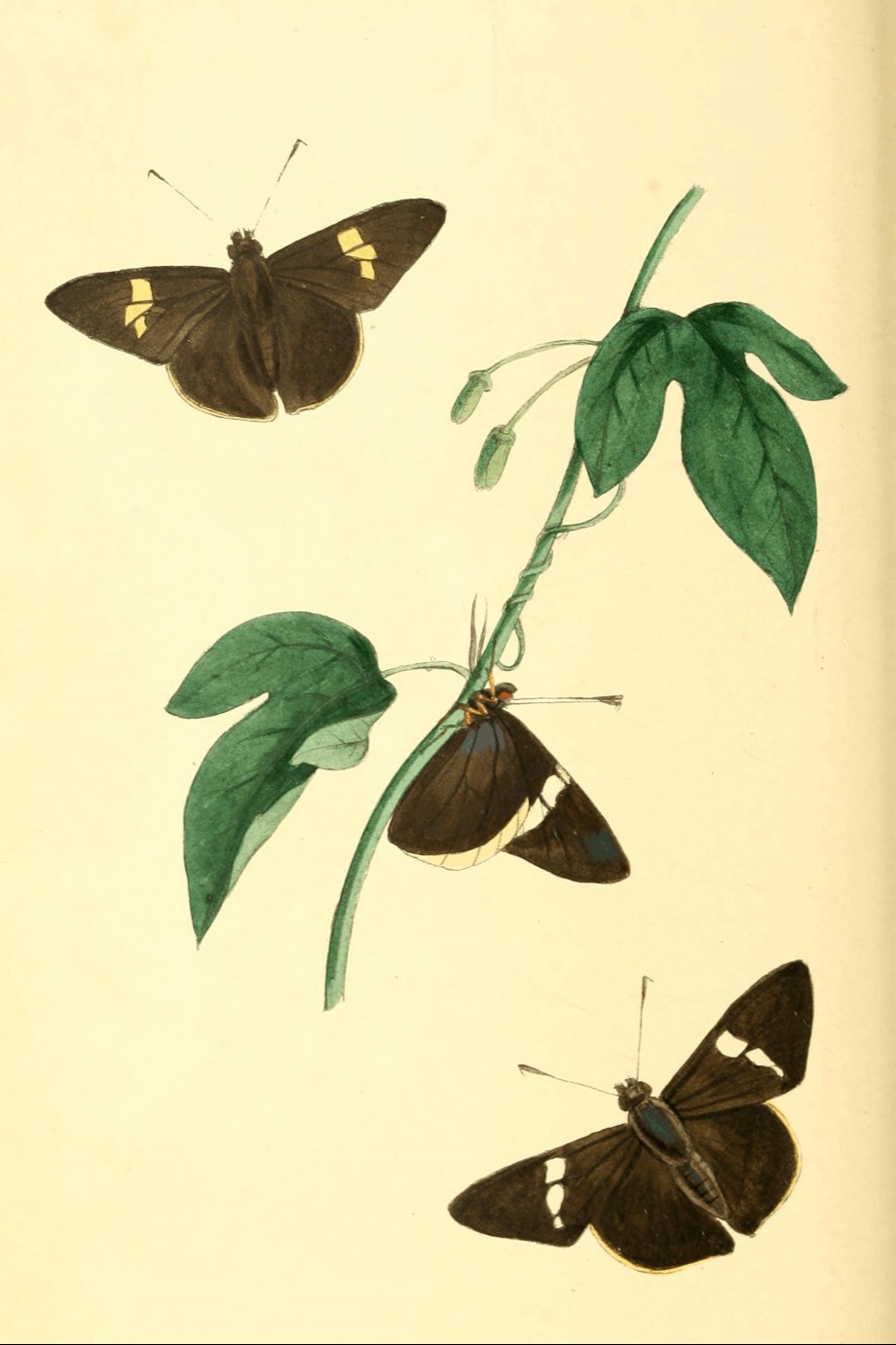
HESPERIA Cynisca.
Generic Character.—See Pl. 28.
Specific Character.
Hesp. (Div. 2.) alis nigrescente-fuscis, subtus obscurioribus;
anticis supra fasciâ flavâ trifissâ (in feminis albâ); posticis subtus
immaculatis, castaneo-fuscis, margine exteriore flavo.Hesp. (Div. 2.) Wings blackish-brown; anterior above with a
three-cleft yellow band, which in the female is white; posterior beneath
immaculate, chesnut-brown, margined externally with yellow.
The different sexes of this insect will appear so strikingly
dissimilar to those who are familiarised only with the nice distinctions
that separate the species of European Lepidoptera, that this
affinity by such may be doubted; nevertheless, observations in their
native country, and the close examination of several specimens, will we
are persuaded confirm the fact.
The male insect is distinguished (like all the Hesperidæ) by
having the eyes considerably larger, and the anterior wings more narrowed
than in the other sex: in this species the bands on their wings assume
the form of three yellowish spots, adjoining which, on the inner side, is
a semi-lunular villous mark, an almost constant indication (where it
exists) of this sex. The straw-coloured border beneath the posterior
wings is narrower and darker than in the female; but in both it forms a
slender marginal fringe on the upper surface. Legs deep rufous; antennæ
black; the club beneath and lunule round the eye straw-coloured.
Inhabits South Brazil, but is not common.
Pl. 41

ACHATINA pallida,
Pale Achatina.
Generic Character.—See Pl. 21.
Specific Character.
A. (div. 2.) testâ cinereo-albâ, fasciis duabus angustis
fuscis, spirâ elongatâ rectâ, anfractibus 7 sub-ventricosis, labio
interiore roseo, columellâ basi rectâ, integrâ, aperturâ
ovato-oblongâ.A. Shell cinereous-white, with two narrow brown bands, spire
elongated, straight; volutions seven, slightly ventricose, inner lip
rosy, base of the columella straight, entire, aperture ovate-oblong.Obs. another specimen of A. pallida quite agreeing with
this, is in Mr. Dubois' cabinet.
The species of this and one or two other genera of land-shells are
subject to such variability in their colouring, that it becomes extremely
difficult to ascertain which are species and which varieties. The shell
now figured might, on a cursory glance, very well pass for one of the
Protean varieties of the Linnæan Bulla fasciata; but a comparison
with that shell will at once point out the strong specific difference
that exists between them in the formation of the mouth. In this, the
lower half of the inner lip, or more properly the pillar, is nearly
straight; the base entire, or without any notch or truncated appearance:
whereas in the true A. fasciata, the inner lip at the base is very
much curved inward, and notched before it joins the outer lip. The mouth
is also short and broad: whereas in this it is much more oblong, and the
base round. Other more obvious characters exist in the form of the
whorls, spire, and more particularly in the colour, of these two shells;
but these are in comparison of minor importance.
I regret having but one example of this shell, as it prevents me from
tracing how far the characters here detailed hold good in other
specimens. They are such, however, as, I think, fully to justify the
propriety of considering it a species.
Its locality is unknown.
I have little doubt more than one species exist among the supposed
varieties of the true Bulla fasciata of Linn., which I take to be
the shell figured by Lister.
Pl. 42
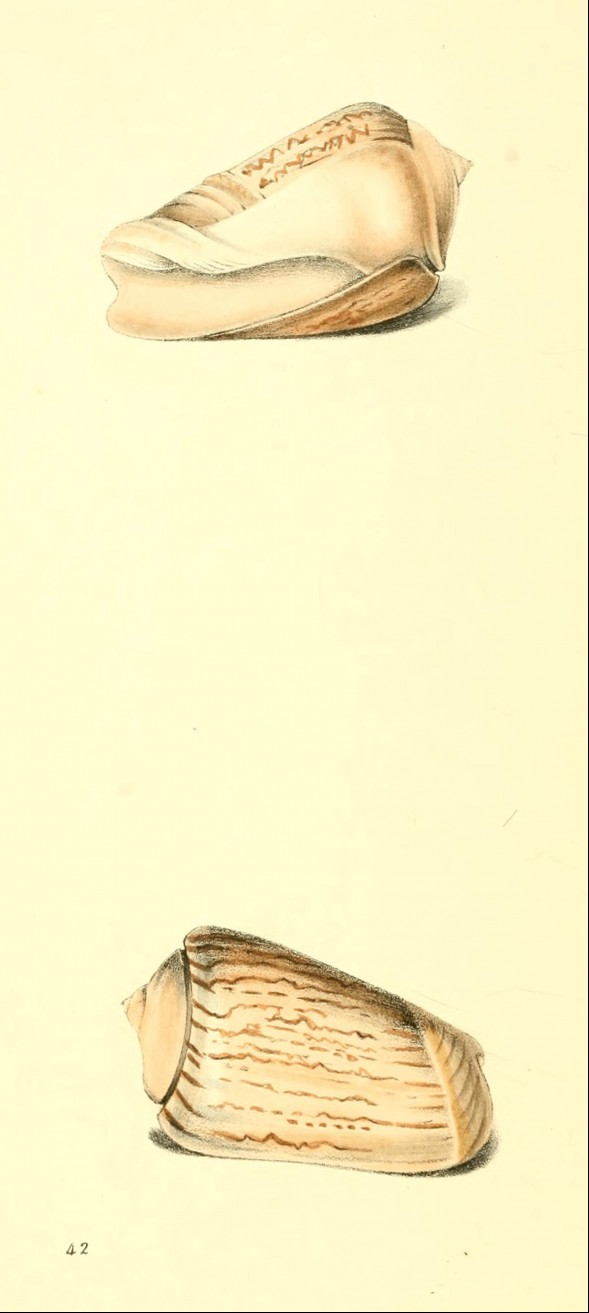
OLIVA Braziliana,
Brazilian Olive
Generic Character.
Testa cylindrica, polita; spira conica, acuminata, brevissima;
labium exterius simplex, interius incrassatum, tumidum; columella plicis
numerosis gracilibus; apertura basi truncata, emarginata.
Typus Genericus Voluta Porphyrea Lin.
Shell cylindrical, polished, spire conic acuminated, very short; outer
lip simple, inner lip thickened, tumid, columella with numerous slender
plaits, aperture at the base truncatedly emarginate.
Generic Type Voluta Porphyrea Lin.
Specific Character.
O. testâ coniformi, latâ; aperturâ effusâ, labio interiore tumidâ
callositate super spiram extendente.Shell coniform, broad; aperture effuse, tumid callosity on the inner
lip large, and spreading over the spire.Oliva Braziliensis. Martini p. 130, tab. 147
& 8, 1367 & 8.Oliva Braziliana. Lamarck.
Voluta pinguis. Dill. 516. 36.
No family of shells possess characters more strikingly obvious to
common observers than the Olives; and yet, although in our English
terminology no one would ever think of calling them Volutes, we
still shrink from giving them that distinguishing appellation in Latin
which we every day use and acknowledge in our own language. The strict
followers of Linnæus, by thus rejecting generic distinctions, which at
once convey a definite idea of form and structure, contribute to render
systematic arrangement less expressive of ideas than the common
nomenclature of our sale catalogues: a striking proof of the pertinacity
with which we cherish those particular doctrines we first imbibed,
although an unbiassed reasoning and an attentive observance of nature
would convince us of their fallacy.
The great Linnæus, at the time he formed that system which laid the
foundation of systematic nomenclature, had not the materials for
gathering and combining those natural genera which the immense
discoveries made since his death have given us a knowledge of. He
accordingly arranged those few shells known to him, in large, and for the
most part natural, groups. That of Voluta I consider as one of
these last (excepting the first division); but the great accession of
species now known, and which is still increasing, has long ago induced
the principal Continental writers to divide this very extensive family
into the following genera: Marginella (Date shells), Oliva
(Olives), Mitra (Mitres), Turbinellus (Turnip shells),
Voluta (Volutes), ...; all possessing not only clear but natural characters;
inasmuch as, by such an arrangement, those interesting links and
ramifications that connect this family with the Bullæ,
Cones, Cowries, Murices, and other genera, can be
traced; and which perhaps affords the most fascinating and intellectual
source of contemplation and study the science can bestow.
The peculiarity of this species will distinguish it among this
numerous and intricate family. The basal suture is deeply channeled;
those on the spire covered by the polished callosity which spreads from
the inner lip.
Mr. Dillwyn has adopted the unpublished name of Solander, although the
shell had long ago been described and named by Martini and Lamarck. I
consider this as contrary to that principle of nomenclature which awards
a preference to priority of publication; and I have therefore restored
the name of those authors who have this undoubted claim. Mr. Dillwyn's
description is very clear and good.
I cannot learn from what particular part of Brazil this species has
been received.
Pl. 43
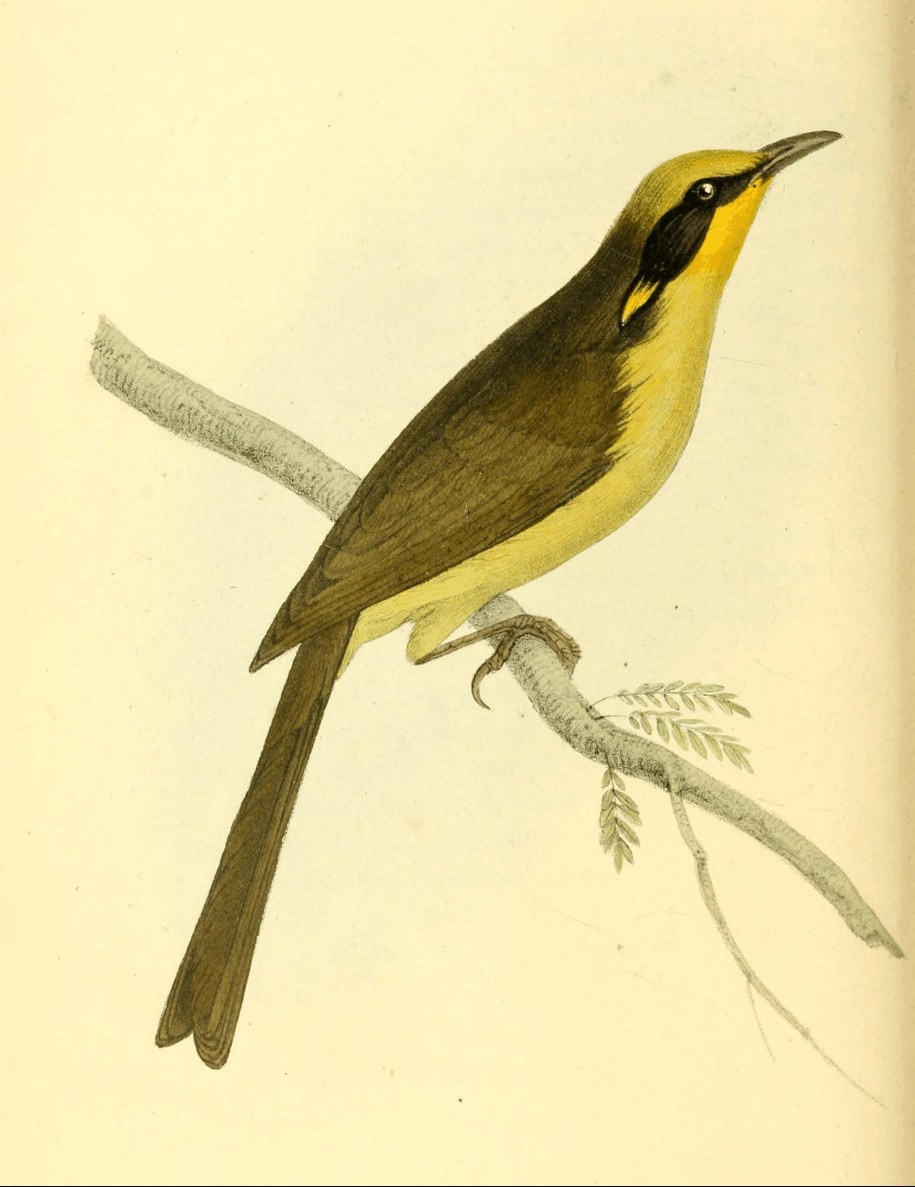
MELLIPHAGA auricomis,
Yellow-tufted Honeysucker.
Generic Character.
(Melliphaga, Lewin.)
Rostrum mediocre, capite plerumque longius, gracile, curvatum,
acuminatum, attenuatum, ad basin altius quam latius, lateribus
compressis; culmine carinato. Mandibula superior ad apicem emarginata;
inferior lateribus compressis. Nares concavæ ad medium rostri porrectæ,
membranâ tectæ, inter rictum et apicem longo fissu aperientes. Lingua
longa, extensibilis, fibris cartilaginosis terminata. Pedes simplices,
digito exteriore connexo, halluce pervalido.Obs. Cauda rectricibus 12, remigibus 1 et 2
spuriis; rostri margine aliquando subtilissime dentato.
Typus Genericus Certhia Novæ Hollandiæ Lath.
Bill moderate, generally somewhat longer than the head, slender,
curved, pointed and acuminated, the base higher than broad, the sides
compressed, the top carinated; upper mandible notched at the tip, the
under mandible laterally compressed. Nostrils concave, near half the
length of the bill, covered by a membrane, opening by a long slit midway
between the gape and tip. Tongue long, extensible, terminated by
cartilaginous fibres. Feet simple; outer fore-toe connected; hind-toe
very strong.Obs. Tail-feathers twelve, first and second quills spurious; margin of
the bill sometimes minutely toothed.
Generic Type New Holland Creeper Lath., &c.
Specific Character.
M. olivaceo fusca; vertice corporeque subtus flavescentibus;
temporibus auribusque nigris; gulâ et pennis elongatis pone aures
flavis.Olive-brown: crown of the head and body beneath yellowish; temples and
ear-feathers black; throat and lengthened feathers behind the ears
yellow.Muscicapa auricomis. M. olivacea, vertice corpore subtus maculaque
aurium flavis, per oculos striga alba. Lath. Ind. Orn. vol. 2.
Suppl. xlix. 1. Gen. Zool. 10. 2. p. 354.Yellow-tufted Flycatcher. Lath. Suppl. 2. 215. no. 4.
Gen. Zool. 10. 2. 354.
The Yellow-tufted Honeysucker, although described by Latham, has
hitherto remained unfigured; and I therefore select it as an excellent
example of a tribe of birds which I think are peculiar to Australasia,
and which seem to hold the same situation among the birds of that vast
country as the Humming-birds occupy in South America, and the Sun-birds
(Cinnyris, Cuvier) in Africa and India; all of which more or less
derive their sustenance from the nectar of flowers, and which they
extract on the wing by means of their long tubular tongues.
It is singular, that while our first ornithological writers were
distributing the numerous species of these birds in their systems, under
such of the Linnæan genera as they thought most adapted for their
reception, a naturalist of a remote colony should be the first who, by
creating a new genus, brought them all into their proper situation in
systematic arrangement; one of the many proofs that Nature, and Nature
only, is to be studied; and that no system, however ingenious or however
applauded, can be considered as infallible.
By an error (no doubt of the press) in the specific character of this
bird in Latham's Index, the eye stripe is called white, though in
the description it is termed black. Mr. Stephens has copied this error
into "General Zoology;" and his description of this bird, as well as
numberless others, seems merely an abridgement or alteration of Latham's;
a practice highly detrimental to science; for, when an original
description cannot be obtained, it is much better, and safer, to copy
without disguise that of another.
How far all the birds included by Temminck in this genus really belong
to it, admits of very great doubt; I have therefore constructed the
generic character from those birds of New Holland only which Lewin, who
founded the genus, must have had before him.
Total length seven inches and a half; bill seven-tenths, the frontal
feathers advancing half its length to the nostrils; those of the ears are
lengthened, but the yellow tuft behind them is much more so; the feathers
of the chin are small, thick-set, and ending in fine setaceous hairs
curved outwards; the breast and body pale brownish-yellow. Quills and
tail dark-brown, margined with deep-yellowish; the two lateral
tail-feathers tipt with dirty white; plumage above olive-brown; front and
crown of the head dark brownish-yellow; bill black; legs brownish,
inner-toe very deeply cleft. Tail, from the rump, three inches and a half
long, and slightly rounded.
Latham, who first described this bird, says, "it makes its nest on the
extreme pendent branches of low trees or shrubs, and by this means
escapes the plunder of smaller quadrupeds." It appears not uncommon in
New South Wales.
Pl. 44
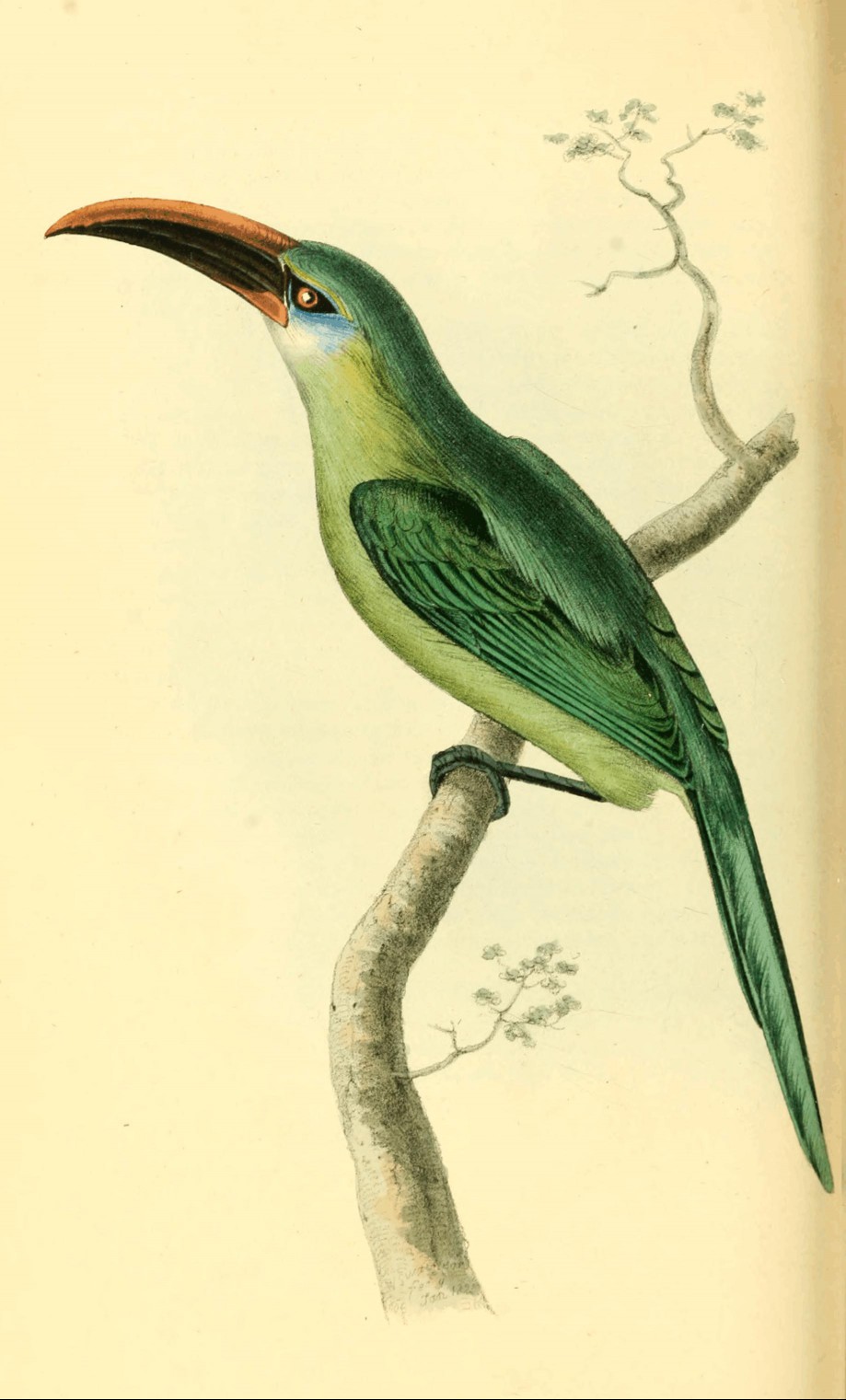
PTEROGLOSUS sulcatus,
Grooved-bill Aracari.
Generic Character.
Rostrum capite longius, crassum, inane, cultratum, basali margine
incrassatum, maxillæ angulo frontali obtuso; tomia serrata: nares superæ
in maxillæ basi: lingua angusta, pennacea. Cauda elongata, cuneata. Pedes
scansorii. Illiger. Prod. p. 202.
Typus Genericus Ramph. Aracari Linn.
Bill longer than the head, thick, light, curved, thickened at the
basal margin, the frontal angle obtuse, the margins serrated. Nostrils
nearly vertical, situated on the base of the bill. Tongue long, slender,
feathered. Tail elongated, cuneated. Feet scansorial.
Generic Type Aracari Toucan Lath.
Specific Character.
P. viridis, subtus pallidior; jugulo albescente, circa oculos
cæruleus; rostrum duobus sulcis longitudinalibus incisum.Green Aracari, beneath paler; throat whitish, round the orbits blue;
bill with two lateral longitudinal grooves.P. sulcatus. Swainson, in Journal of Royal Institution, vol. 9.
p. 267.
All those species of the Linnæan Toucans having a long wedge-shaped
tail, and the nostrils passing through the upper part of the bill, are
comprehended by Illiger and other continental writers under this genus.
They have been called by the French Aracari; which name I have retained
as an English generic distinction. They inhabit the same country and
situations as the real Toucans, which are distinguished by having a
short, broad, and even tail, and the nostrils placed behind the bill.
A fine example of this very rare bird I first met with in the small
collection sent to my excellent friend, E. Falkener, Esq. from the
Spanish Main. I have since noticed another which was in Mr. Bullock's
museum, and is now in the possession of Lord Stanley: these are the only
two specimens known.
This bird was first described by me in the Journal of the Royal
Institution near a year ago. When Professor Temminck was in England, I
showed him the manuscript description and drawing which I had then made:
he assured me he had never seen the bird before, otherwise than in
Bullock's museum. A short time after, my account of it was published. I
observe, however, that in the new edition of his Manuel he gives this
name to a new bird of his own: no description however follows, and it is
therefore impossible to say if the Professor intends it for this
identical species.
We must postpone any further observations on this family, and conclude
by giving the original description above alluded to.
Total length twelve inches, of which the bill in extreme length
measures three. It is much curved, and more attenuated than any of the
Aracaris, being thickest at the base; from which it narrows to a sharp
point at the tip. The upper part is convex, and somewhat thickened; the
sides are compressed, and the upper mandible has two broad slightly
indented grooves on each side: the base has a few transverse wrinkles,
and the serratures deep and unequal. The lower mandible half the depth of
the upper, the sides concave, and the teeth less. The colour (in the
dried bird) black; the base of the lower and the upper half of the
superior mandible rufous, the base with a whitish marginal line. The
nostrils are more lateral than usual, being placed in a line with the
eye; the orbits naked and reddish brown, the feathers encircling which
(particularly beneath the eye) are vivid cerulean blue. The whole upper
plumage is parrot green, paler beneath, with a gloss of golden yellow on
the cheeks and sides: throat dusky white. Wings short, five inches long,
and rounded; inner shafts of the quills black, margined with whiteish.
Tail cuneated, green, four inches and a half long, the four middle
feathers equal. Legs dusky black.
Pl. 45

RAMPHASTOS carinatus,
Sharp-billed Toucan.
Generic Character.
Rostrum capite longius, maximum, crassum, inane, cultratum, basali
margine incrassatum; maxillæ angulo frontali subtruncato transverso: Nares verticales, pone
maxillæ basin sitæ; tomia serrata; lingua angusta, pennacea; cauda
brevis, æqualis; pedes scansorii. Illiger. Prod, p. 212.
Typus Genericus R. erythrorynchus Lath.
Bill very large, longer than the head, thick, light, curved, and
thickened at the basal margin; the frontal angle transversely
sub-truncated, margins serrated. Nostrils vertical, behind the base of
the bill. Tongue slender, long, and feathered. Tail short, even. Feet
scansorial.
Generic Type Red-billed Toucan Lath.
Specific Character.
R. niger; gulâ flavâ; fasciâ pectorale tegminibusque inferioribus
rubris; rostro viridi, apice rubro; mandibulâ superiore culmine carinato
flavo, lateribus maculâ aurantiâ; inferiore cæruleo variegata.
Black; throat yellow; pectoral bar and under tail covers red; bill
green, tip red; upper mandible carinated and yellow above, the sides with
an orange spot; lower mandible varied with blue.Yellow-breasted Toucan. Edwards, pl. 329.
Ramphastos Tucanus. Yellow-breasted Toucan. Gen. Zool. 8, 362,
(excluding the Synonyms.)
No tribe of Birds appear so void of that symmetry of form that in
general pervades the feathered creation, as the Toucans and Aracaris in
the new, and the Hornbills in the old continent. A question naturally
arises, why the bills of these birds should be so monstrously out of
proportion, and what possible use they can be applied to. The elucidation
of these questions is highly interesting, and calls for the most accurate
observations to be made in their native regions. It will be sufficient
for the present, however, to point out, with regard to the Linnæan
Toucans, that the accurate observations and anatomical knowledge of my
valued friend Dr. Traill, F.R.S.E., of Liverpool, have clearly proved
that an immense number of nerves and fibres fill the cavity of these
bills, all connected with the organs of smelling, which are in the
highest state of development. A short notice on this subject will be
found in the Linnæan Transactions; but as my learned friend is pursuing
his inquiries further on the subject, I shall for the present confine my
remarks to the individual here illustrated, observing that no birds are
so little understood, even in regard to the species, as these.
The indefatigable Edwards appears the first who noticed this bird. His
description, though in the quaint style of the day, is clear and
comprehensive; and his figure strengthens it, both being made from the
living bird. Yet Dr. Latham has quite overlooked it as a variety of
another species; and Dr. Shaw, although he copies Edwards's account,
gives references which belong to other birds. It is not in the costly
work of Le Vaillant, and indeed seems (from its excessive rarity) to have
escaped the notice of all modern ornithologists. The perfect bill of the
bird is, however, in my possession, minutely agreeing with Edwards's
account; and also an original sketch in oil of another individual, by an
unknown artist, with a note stating it was done from the life at Exeter
'Change. All these testimonies put the existence of the bird beyond any
doubt.
Having seen only the bill, which is well described by Edwards, I shall
close this article with such part of his description as appears
necessary.
"The bill is very large, compressed sideways, having a sharp ridge
along the upper part; the upper mandible is green, with a long
triangular spot of yellow colour on each side, and the ridge on the upper
part yellow; the lower mandible is blue, with a shade of green in the
middle, the point is red, it hath about five faint dusky bars, which
cross the joinings of the two mandibles. The iris of the eye is a fair
green colour; round the eye is a broad space of naked skin of a violet
colour: the throat and breast are of a bright yellow, below which is a
bar of scarlet feathers; the covert feathers of the tail are white above,
beneath of a bright red; the legs and feet are all of a blue or violet
colour." Edwards says it was brought from Jamaica, but doubts its being
rather a native of the continent: he says they are very rarely brought
home alive.
The bill is full six inches long, and the whole figure on the same
scale, both in this and in Edwards.
Pl. 46
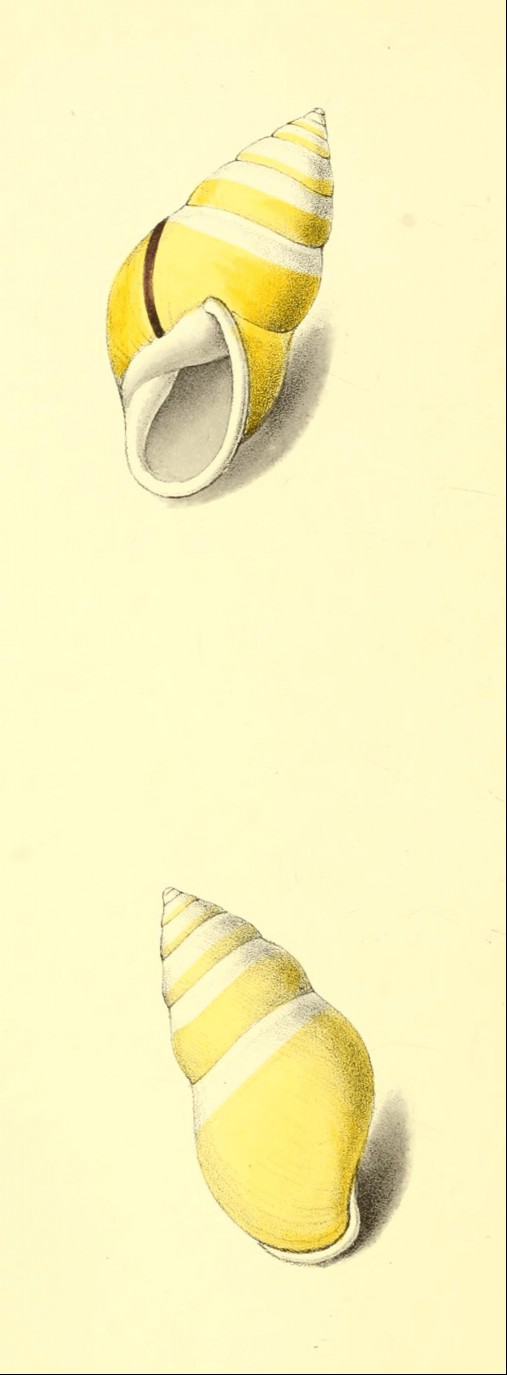
BULIMUS citrinus,
Citron Bulimus.
Generic Character.—See Pl. 4.
Specific Character.
B. testâ obovatâ; spirâ conicâ, in medio sub-crassatâ, aperturâ
longiore: spirâ anfractibus 6 in suturam depressis; labio exteriore basi subcontracto; umbilico subclauso.Shell obovate; spire conic, slightly thickened in the middle, longer
than the aperture, and of six volutions depressed on the suture;
outer-lip slightly contracted at the base; umbilicus nearly closed.Bulimus citrinus, var. B. Bruguiere Encycl. Meth. 314.
no. 27.Martini 9. tab. 110. fig. 930.
This variable species is perhaps the most beautiful and delicate in
its colouring of all the terrestrial snails; yet, although figured by
several of the older writers, so little justice has been done it, that we
make no apology for introducing it into the present work, both on this
account, and for the purpose of giving such a discriminative specific
character as may lead to the inquiry, how far all the numerous varieties
mentioned by authors really belong to this species or not. As far as my
own observation goes, I have found that the thickened spire, the
depression of the whorls on the suture, and the narrowness or contraction
of the mouth at the base, afford the only constant characters; for, in
regard to colour and the situation of the mouth, both appear subject to
great variation, the latter being as often reversed as regular. Martini's
is the only figure that can be safely quoted for this variety.
I am indebted to Mrs. Bolton, of Storr's-hall, Windermere, for the
loan of this and several other rare shells: it formerly belonged to Mr.
Jennings, and appears an old shell, being heavy in proportion, the
umbilicus thickly closed up, and the outer-lip very thick. Another I have
seen at Mrs. Mawe's, and one is in the British Museum: but the finest
specimen in colour and preservation is in the possession of my friend W.
J. Broderip, Esq., of Lincoln's-Inn: from this it seems the spiral
whorls are finely and delicately marked by transverse elevated striæ,
while those on the basal volution are striated transversely, though in a
less regular manner.
Bruguiere mentions that this species is generally found in the South
American islands, Cayenne, and Guiana.
Mr. Dillwyn has given the new name of aurea to this shell, in
addition to the five others under which different authors have described
it. Such changing of names and multiplication of synonyms, without strong
reasons, are very objectionable. I have retained that of
Bruguiere, as being the only author who has placed it in its
proper genus.
Pl. 47
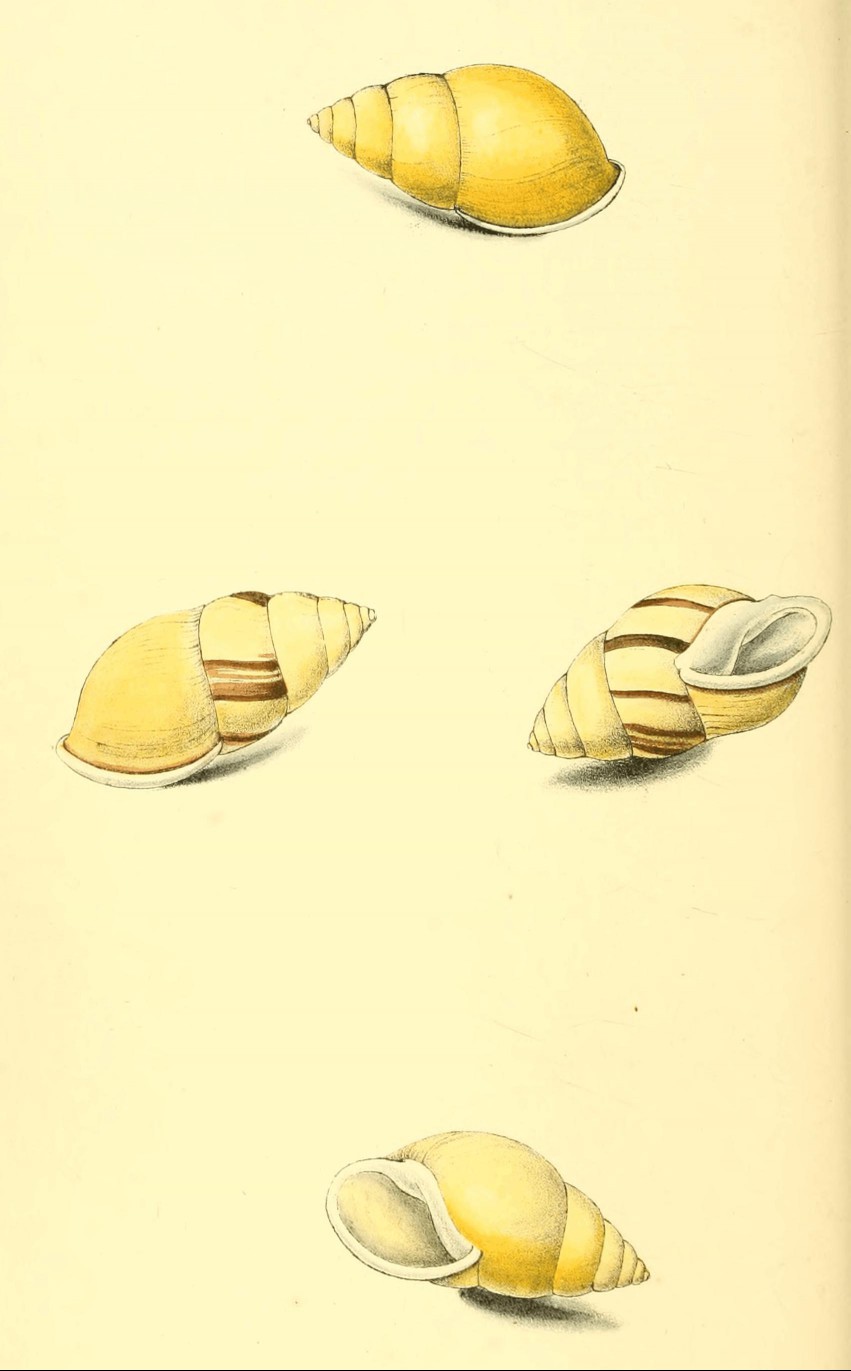
BULIMUS citrinus (var. perversu).
Reverse, banded Citron Bulimus.
Generic Character.—See Pl. 4.
Specific Character.—See Pl. 46.
Synonyms.
Martini, vol. 9. tab. 934 & 5. Knorr, 4.
tab. 28. fig. 4, 5. (bad.)Bulimus citrinus, var. B. Bruguiere, 314. 27.
A fine pair of this beautiful and rare variety is in the collection of
Mr. C. Dubois, to whom I am indebted on this and many other occasions,
for the facilities he has afforded me in prosecuting the present work:
one of these is now figured; it differs in no respect from that in the
last plate, except in being reversed and having the umbilicus not so
completely closed; a character which, perhaps, exists only in very old
shells. The other specimen is also reversed and banded, though in a
different manner.
BULIMUS aureus.
Golden Bulimus.—upper and lower figures.
Specific Character.
B. testâ obovatâ, spirâ conicâ, anfractibus 5 convexis, suturâ
simplici, umbilico aperto.Shell obovate; spire conic, of five convex volutions; suture simple;
umbilicus open.Lister 34. 33. Martini 9. tab. 110. 928. 929?
Obs. Bulimus aureus, in
Mr. Spurrett's valuable cabinet is another specimen of this shell
minutely agreeing with that here described.
Having seen but a single specimen of this shell, I have placed it as a
distinct species, not without some doubts, and principally for the
purpose of calling the attention of conchologists to a more rigid
examination of the specific distinctions of this family (unconnected with
colour) than has heretofore been done. The regular convexity of the
whorls, not in any degree compressed at the suture, the want of that
thickened appearance on the spire, and of the contraction at the base of
the mouth (all which characters I have found in the varieties of B.
citrinus to be constant), afford a specific distinction which future
observations must confirm or annul. Bruguiere notices a variety of B.
citrinus which is entirely yellow, a most beautiful specimen of which
is in the British Museum, and which possesses (as well as the excellent
figure of Gualtieri) all the specific characters I have given to B.
citrinus, but not of the present shell. Lister's figure, on the
contrary, is rude, though very characteristic of this; and Martini's
representation, here cited, also appears the same.
Mr. Dubois, in whose collection this specimen exists, is unacquainted
with its locality.
Pl. 48

MITRA casta,
Chesnut-banded Mitre.
Generic Character.—See Pl. 23.
Specific Character.
Mitra (Div. 3.) testâ albâ, lævi, olivæformi, spirâ aperturâ
breviore, anfractibus supra tenuiter reticulatis, basi epidermide
castaneam fasciam formante, in anfractu basali centralem et
latam.Shell white, smooth, olive-formed, spire shorter than the aperture,
the volutions finely reticulated above, the lower half with the epidermis
forming a chesnut band which is central and broad on the basal whorl.Voluta casta. Chemnitz 10, p. 138, vig. 20 C D.—figura mala.
Martyn Univ. Conch. i. tab. 20.
Dillwyn Catalogue, vol. i. p. 554, no.
127.
All the writers I have been able to consult, uniformly describe this
species as having a coloured band on the white ground of the shell. In
the Banksian cabinet are two fine specimens, and which have enabled me to
ascertain that this brown band is nothing more than an epidermis, or
external coating, with which the shell is only partially covered—a
circumstance of very rare occurrence; and which, being removed, proves
the real colour of the shell to be of a uniform polished white. This,
together with its excessive rarity, and the opportunity of giving
original figures, has induced me to include it in this work, although it
exists both in those of Martini and Martyn above quoted. I have neither
seen nor heard of specimens being in any other collection, besides the
two above noticed; and which no doubt were collected by their late
lamented possessor on some of the South Sea islands. A striking affinity
exists between this and M. zonata figured at the third plate of this work.
MITRA olivæformis.
Olive-shaped Mitre.
M. testâ olivæformi, glabrâ, nitidâ, spirâ brevissimâ,
longitudinaliter rugatâ, striâ centrali transversâ; columella
4-plicata.M. Shell olive-shaped, smooth, polished, spire very short,
longitudinally wrinkled, with a central transverse stria, pillar
four-plaited.
I introduce the description of this diminutive and undescribed shell
from its affinity with the last, and as forming a most interesting
transition from the Mitres to the Olives: agreeing with the former in the
structure of the pillar and the sculptured spire, and with the latter in
its general form and prima facie appearance. Its perfect
resemblance, in fact, to a small olive, may have occasioned its being
hitherto overlooked. The spire is slightly wrinkled and striated; the
teeth on the pillar very near each other, slender, and four in number.
The colour pale yellowish; the mouth darker, and the tip and base purple.
The whole shell is scarcely half an inch long.
It was received from the South Seas.
Pl. 49
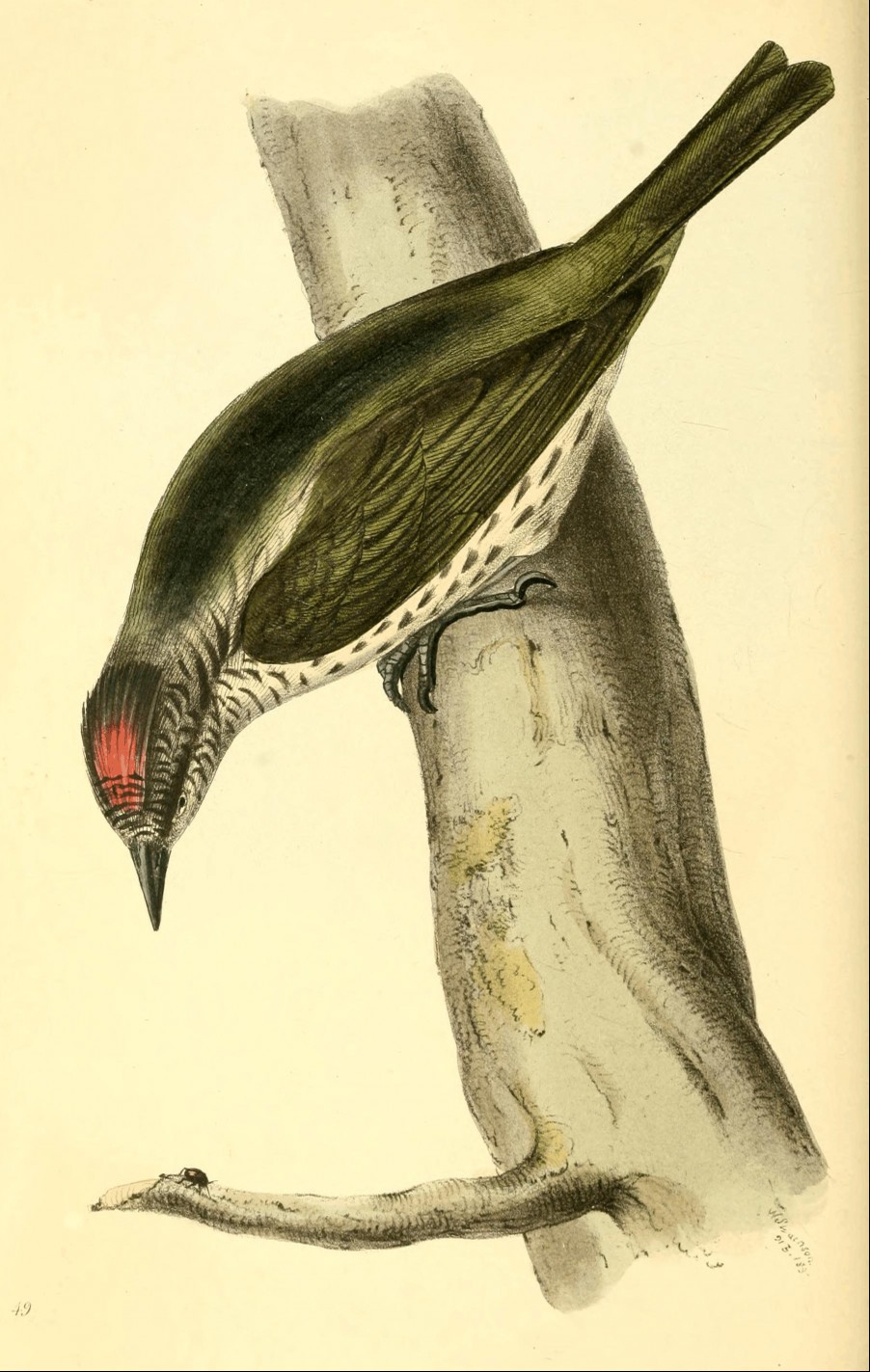
OXYRHYNCUS cristatus.
Crested Sharpbill.
Generic Character.
Oxyruncus Temminck.
Rostrum breve, rectissimum, basi trigonâ, ultra basin attenuatum,
apice acutissimum; mandibulâ superiore suprà rotundatâ, utrisque integris. Nares basales, nudæ, membranâ
partim tectæ, aperturâ lineari ad marginem rostri approximante. Pedes
breves, validi, digito medio longiores; digitis anterioribus tribus,
exteriore connexo, interiore fisso; halluce valido.Bill short, very straight, base trigonal, beyond attenuated to a very
fine point; upper mandible above rounded, both entire. Nostrils basal,
naked, partially covered by a membrane; aperture linear, near the margin
of the bill. Feet short, strong, a little longer than the middle toe;
anterior toes three, the outer connected, the inner cleft; hind toe
strong.
Specific Character.
O. suprà olivaceo-viridis, subtùs flavescente-albus, maculis
nigrescentibus; capite cristâ coccineâ incumbente; capitis lateribus
lineis transversis flavescente-albis.Above olive-green, beneath yellowish-white, with blackish spots. Head
with an incumbent crimson crest; sides of the head and neck with
transverse yellowish-white lines.
An elegant and (to the ornithologist) a highly interesting bird,
considered with much judgement by Professor Temminck as a new genus,
having the perfect bill and habit of the Wryneck, but totally unlike that
bird in the position of its toes, which in this are not placed in pairs.
The Professor has slightly described it, in the new edition of his
Manuel, without a specific, but under the generic
name of Oxyruncus, the spelling of which must be presumed as an
error of the press: no mention, however, is made of the beautiful crimson
colour which adorns the crest.
Total length near seven inches. Bill eight-tenths in length from the
gape; general colour of the bird olive-green, becoming nearly white on
the under part, and on the transverse stripes on each side the neck,
front and temples, where there are also obscure bands of black; crown
with a concealed crest, which is vivid crimson at the base and blackish
at the tips; inner margin of the covers, quills and tail blackish; inner
covers yellowish; chin, neck and breast banded with blackish lines, which
are broken into spots and stripes beyond.
Inhabits Brazil, but is very rare.
Pl. 50
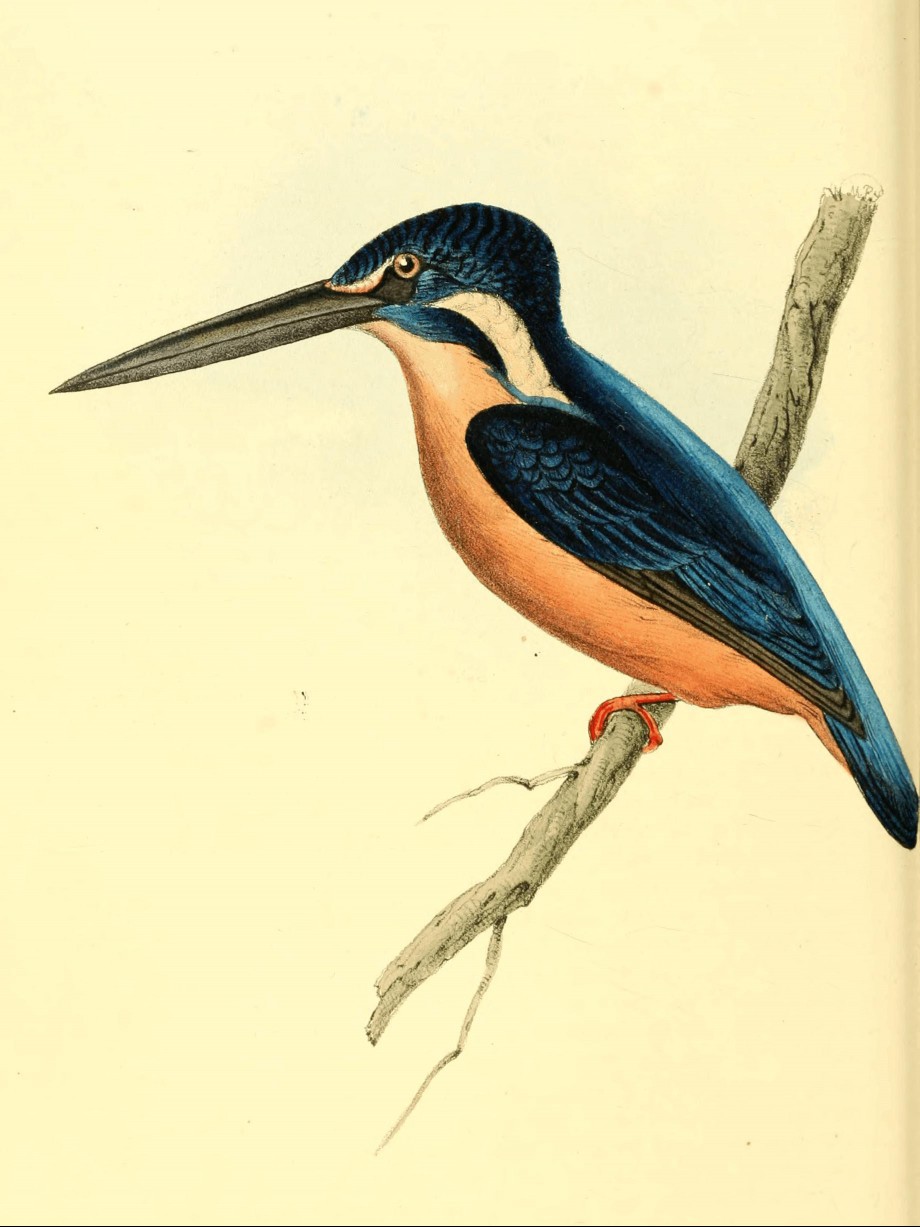
ALCEDO Asiatica.
Asiatic Kingsfisher.
Generic Character.—See Pl. 26.
Specific Character.
A. capite nigro, fasciis transversis cyaneis, posticè cristato;
auribus cyaneis; mento, gulâ, strigâque laterali colli albescentibus;
dorso nitidè cæruleo; corpore subtùs rufo.Head black, transversely banded with mazarine blue, the hinder part
crested; ears blueish; chin, throat, and lateral stripe on each side the
neck whitish; back shining light-blue; body beneath rufous.Obs. This bird Dr. Horsfield tells me is his Alcedo
meninting described in the Linn. Transactions.
The general resemblance between this and the European Kingsfisher may
have been the cause why it has remained hitherto unnoticed by
ornithologists. It bears, however, on closer inspection, a strong and
peculiar distinction in the crest at the back of the head, in being much
smaller in size, and especially as inhabiting the hottest parts of India;
while our own braves the cold of a Siberian winter.
Total length six inches, of which the bill from the angle of the mouth
to the tip occupies one inch and three-quarters, and is black, with the
under mandible paler; the ears and the upper part of the head and neck
are blueish-black, transversely banded with somewhat crescent-shaped
narrow bands of a rich deep blue, which are broken into spots on the
crest and ears: from the base of the under mandible is a black stripe
richly glossed with blue, and carried down on each side the neck, between
which and the upper part is a whitish stripe beginning just behind the
ears (this in the European species is rufous). The wing-covers, scapulars
and lesser quills are blackish glossed with blue, the two former having a
bright spot at the end of each feather; superior and greater quills
entirely blackish; down the middle of the back, rump, and tail-covers,
light and vivid blue, with a slight tinge of greenish; chin and throat
cream-colour; line between the nostrils and eyes, margin of the
shoulders, under wing-covers, and all the lower parts of the body,
rufous; tail deep and obscure blue; legs red.
My specimen came from some part of India; I have met with others from
the same place; and Dr. Horsfield has likewise observed it in Java.
Pl. 51
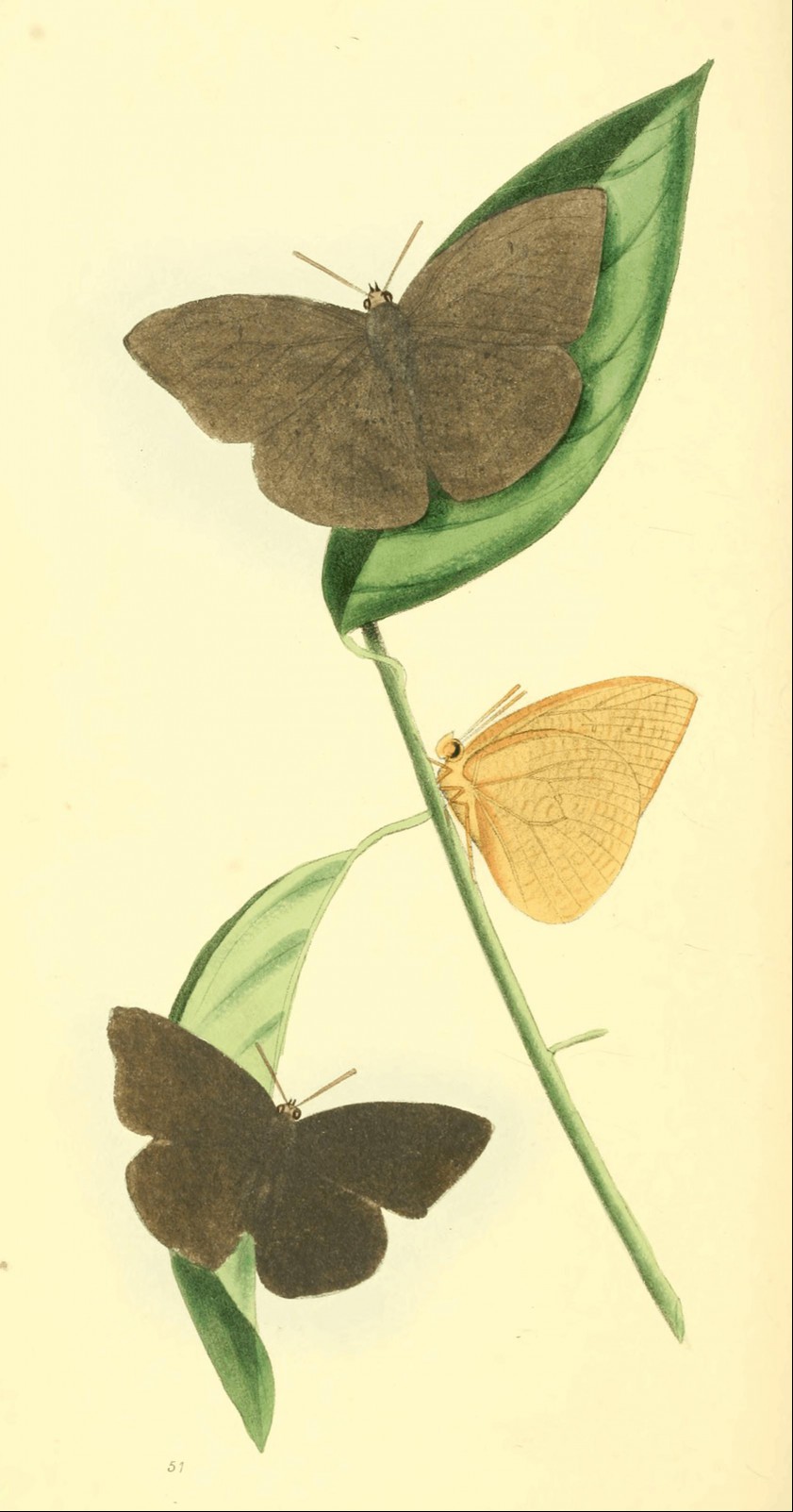
COLIAS Pyrene.
White African Colias.
Generic Character.—See Pl. 5.
Specific Character.
C. alis albis; anticis suprà punctulo nigro subcentrali oblongo ad
apicem approximante; posticis margine integerrimis; singulis subtùs
puncto ocellari lineisque fulvis undulatis: sexibus similibus.Wings white; anterior with a small, nearly central, oblong, black dot
nearest the tip; margin of the posterior wings very entire, beneath all
with a brown ocellate spot and undulated fulvous lines: both sexes
alike.
Under the head of Colias Pyranthe, M. Godart has united the
three insects described by Fabricius, as, Pap. Pyranthe,
Nepthe and Gnomia, all bearing in their leading colours a
very near resemblance to each other. Yet as this consideration alone
appears to have decided this ingenious author in uniting them, without
apparently noticing the nicer but more important characters of form,
proportion, and real sexual distinction, as well as geography, I cannot
but consider the question still remains doubtful; and although I am not
at present prepared to offer an opinion as to the actual affinity between
these three insects, I have little or no doubt that the one now figured
is a really distinct species from either of the above, which all inhabit
various parts of India. This, on the contrary, is from the interior of
the Cape of Good Hope, from whence it was brought by Mr. Burchall, among
whose insects I have seen about twenty unvarying specimens, but they were
all males. I discovered however three or four of both sexes, varying in
size, in Mr. Haworth's cabinet, and the perfect similarity in colour of
the female with the other sex is very striking: it wants of course the
little tuft of hair and opaque spot within the borders of the wings, so
generally found in the male Coliadæ.
The distinctions of Colias Pyrene as a species rest on the
areola of the anterior wings being considerably larger in proportion than
in the others allied to it, thus making the black dot (which is always
placed at the outer extremity of the areola) much nearer the tip than the
base: these wings are also more sharply trigonal (in the male), and have
only the slightest appearance of a black margin; the hinder wings are
also perfectly entire, and not obtusely undulated as in those insects,
and the sexes not differing in colour. Like most of the insects of this
genus, the ocellate spots beneath vary considerably; sometimes they are
silvery, at other times not; the anal valves in the male are short and
obtuse, and the wings in the female not so sharply pointed.
Pl. 52
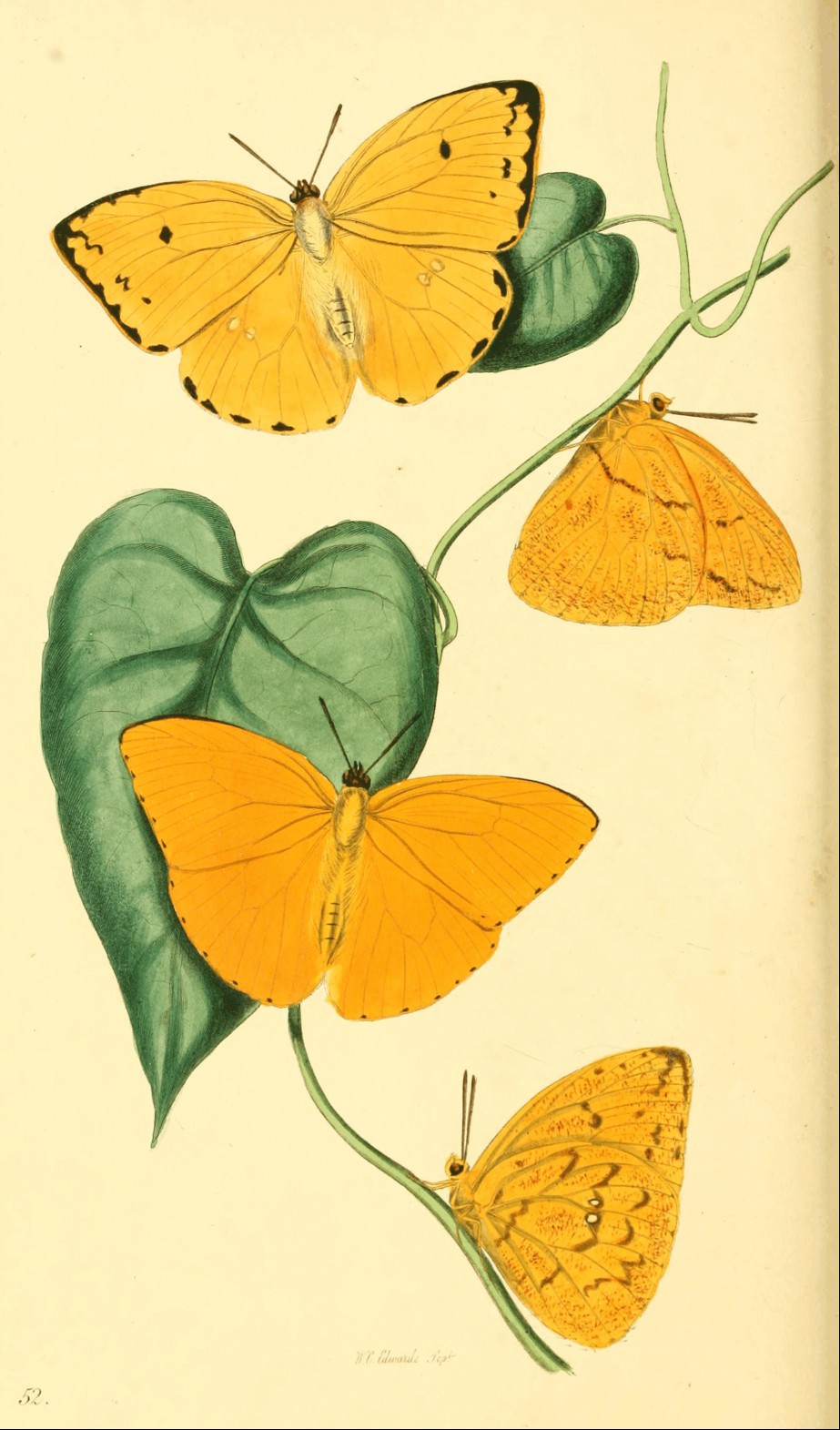
COLIAS argante.
Orange Colias.
Generic Character.—See Pl. 5.
Specific Character.
C. (Mas.) alis aurantiis, suprà immaculatis, posticis subtùs atomis
ferrugineis, plerumque puncto gemino argenteo.C. (Fœm.) alis aurantio-flavis, anticis suprà, apice
punctoque medio atris; posticis subtùs, puncto gemino argenteo atomisque
ferrugineis.C. (Male.) Wings bright-orange, above immaculate; posterior beneath
with minute ferruginous dots, and generally two silvery spots.C. (Female.) Wings golden-yellow; anterior above with a central spot
and black marginal tip; posterior beneath covered with ferruginous dots
and two silvery spots.
(Male.) Papilio Hersilia. Cramer, pl. 173. C. D.
——— argante. Fab. Ent. Syst. iii. pt. 1. p. 189.
Colias argante. Godart in Encycl. Method. 9. 92. no. 11.(Female.) Papilio Cipris. Cramer, pl. 99. E. F.
Colias Cnidia. Godart, 93. no. 14.
No two insects can present a more striking dissimilarity than the
sexes of this species; and it was only after a considerable degree of
attention to the subject, in their native climate, that we were at last
thoroughly convinced that Colias argante and C. Cnidia
were, without the least remaining doubt, the male and the female of one
species. I have had the same opinion communicated to me by my friend Dr.
Langsdorff, whose long residence and observations in Brazil render his
opinion of no small authority.
As both insects are well known, and their distinctions given in the
specific character, it will be only necessary to observe, that the under
surfaces of the wings in both sexes vary much both in the density of the
minute dots, and short undulated stripes that spread over their surface;
and that the silvery spots in some males are strongly marked, and in
others quite obsolete: there is, in very fine individuals of this sex, a
faint bloom of pink spread on the orange of the upper surface, which
heightens the vivid yet chaste beauty of the insect. The females are not
so common. I met with them both in northern and southern Brazil, and have
seen them in collections from Parà directly under the equinoctial
line.
Pl. 53

STROMBUS cylindricus.
False Scarlet-mouthed Strombus—Upper and under figures.
Generic Character.—See Pl. 10.
Specific Character.
S. testâ coniformi, spirâ brevissimâ ad basin depressâ, anfractibus
convexis inæqualibus, labio exteriore suprà lobato, intùs striato;
interiore sub-obsoleto, albo.Shell coniform; spire short, depressed at the base, the whorls convex
and unequal; outer lip lobed above, and internally striated; inner lip
nearly obsolete, white.Lister 850. 5. (bad.). Gualt. 31. 1. Knorr, vi.
tab. 15. 3.Strombus luhuanus Linn. Martini, x. tab. 157.
1499. 1500.Young. Lip above entire, inside smooth, whorls tuberculated.
Lister, 849. 4. a? Knorr, vi. tab. 17. 2.
We introduce this common shell for the purpose of pointing out those
characters which induce us to consider it more as a distinct species than
as a variety of S. Luhuanus of authors; and this consists not so
much in the colour of the inner lip, as in the almost total absence of
that important part, which this shell invariably exhibits through all its
growths: it is therefore, I think, contradictory to the meaning of the
word to term that variable which is found to be constant, particularly
where the point of distinction rests on a marked difference of
formation no less than of colour, though both shells are common to
the Oriental seas. Minor differences exist, in the mouth of this always
being pink, the inner lip white, and the outer lip but slightly lobed (or
cut out) above: in S. Luhuanus the mouth is deep scarlet, inner
lip black and highly polished, and the outer lip deeply notched above;
the two former characters, indeed, begin to show themselves at a very
early growth of the shell.
STROMBUS Persicus.
Persian Strombus—middle figures.
S. testâ sub-coniformi, brevi; spirâ conicâ, æquali; labio
exteriore prominente, suprà sinuato, intùs glabro; interiore polito,
albo.Shell somewhat coniform, short; spire conic, equal. Outer lip
prominent, sinuated above, smooth within; inner lip polished, white.
Allied, but sufficiently distinct from the last; the mouth is always
smooth and white. It is a local species: a few received from the Persian
Gulf are all I have yet seen, some were young, but no other variation was observable.
Pl. 54

MITRA lyræformis.
Harp Mitre.
Generic Character.—See Pl. 23.
Specific Character.
M. testâ costis regularibus, carinatis, approximatibus: columellâ
striatâ, juxta basin triplicatâ: spirâ subattenuatâ; apice
subpapillosâ.Shell with regular, carinated, approximating, longitudinal ribs.
Pillar striated, three-plaited near the base. Spire somewhat attenuated.
Apex slightly papillary.
This beautiful and highly interesting shell has been generally
considered unique among the collections in this country. It was
originally in the possession of the late Mr. Jennings, and, I am informed
by Captain Laskey, was on first being received, in a much finer state.
Mr. Jennings had it cleaned, and in so doing many of the delicate
transverse striæ were partially obliterated, and the sharp ridges on the
longitudinal ribs worn down, as indeed was apparent from a drawing
Captain L. had made of the shell previous to this unmerciful cleaning. It
however still remains a very fine shell, and is now in the cabinet of
Mrs. Bolton, of Storr's-hall, to whom I am obliged for the opportunity of
now publishing it.
The figure and specific character will sufficiently point out its
distinctions. The body-whorl is smooth, but strongly granulated at the
base; the spire delicately striated between the ribs; the two last whorls
before the apex are close, thick, and somewhat papillary; the apex itself
small and sharp. The upper part of the inner lip has some faint obsolete
teeth, but the base has three very strong ones.
It connects in the most beautiful manner the two genera of
Mitra and Voluta. Its country is unknown.
Pl. 55

SOLEN ambiguus.
Ambiguous Solen.
Generic Character.
Testa bivalvis, æquivalvis, transversissimè elongata, utroque
latere hians. Dentes cardinales parvi, fragiles, numero variabiles, rarò
divaricati. Ligamentum externum; animal ad extremitatem anteriorem pede
subcylindraceo; ad posteriorem siphone brevi duos alteros conjunctos
continente. Lamarck.
Typus Genericus Solen Vagina Pennant.
Shell bivalve, equivalve, very transversely elongated, open at both
ends. Cardinal teeth small, fragile, variable in number, and rarely
divaricated. Ligament external. Animal with a sub-cylindrical foot at the
anterior end, and at the other a short tube containing two others united
together. Lamarck.
Generic Type Solen Vagina Pennant.
Specific Character.
S. testâ lineari, crassâ, rectâ, pallidâ, obscurè radiatâ;
cardinibus unidentatis, margine anteriore sub-approximantibus.Shell linear, strong, straight, pale, obscurely radiated. Cardinal
teeth one in each valve, placed near the anterior extremity.Solen ambiguus. Lam. Syst. vol. iii. p. 452. no.
7.
Under the genus Solen (vulgarly called Razors or Pods) are
comprehended a variety of shells having the common character of both
extremities open or gaping when the valves are together, yet differing
materially in their form, teeth, and general appearance: some are long,
slender and straight; others more or less curved; a few short and oval,
or with one end only lengthened. Modern writers have, however, retained
nearly all these in the genus as left by Linnæus; and this method for the
present is more desirable than that of creating a multiplicity of genera.
Dr. Turton, in his very useful Conchological Dictionary, enumerates
thirteen species as found on the British coast, including the Solen
Novacula of Montagu, which the Doctor suspects is not truly a
species. The original specimens which Montagu described I have carefully
inspected at the British Museum, and have no doubt in my own mind they
are in reality no other than S. Siliqua with one of the cardinal
teeth broken off; a circumstance which, from their fragility, frequently
happens, even in opening the recent shell.
Solen ambiguus was first described by Lamarck, who says it is
from North America. Two or three specimens are in my possession; but it
is a rare species, much thicker, and with larger teeth than any other;
the epidermis is pale-brown, and in some parts obliquely lineated.
Pl. 56
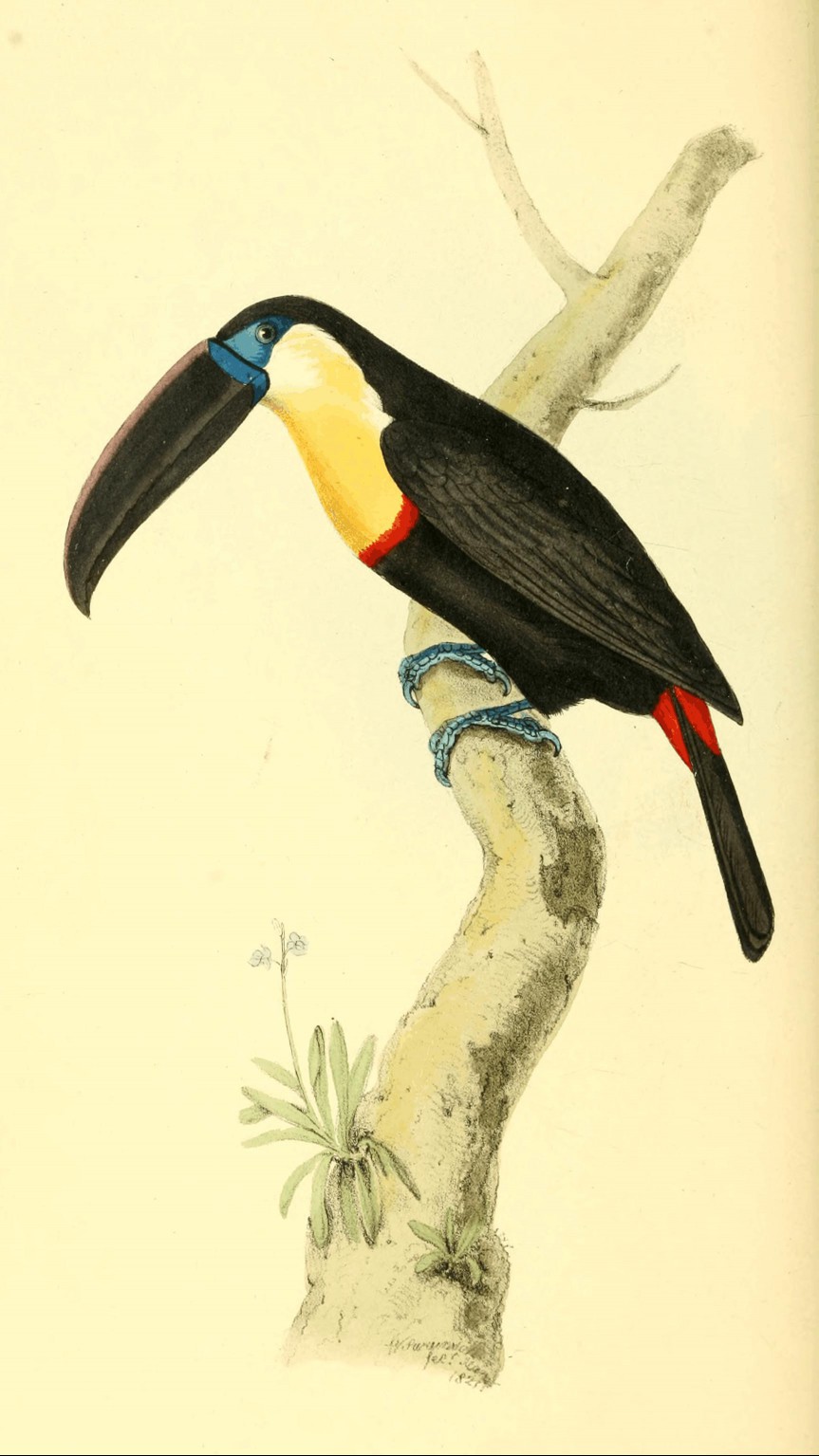
RAMPHASTOS vitellinus.
Sulphur-and-white-breasted Toucan.
Generic Character.—See Pl. 45.
Specific Character.
R. niger, gulâ flavo-aurantiâ; lateribus auribusque albis; fasciâ
pectorali tegminibusque rubris; rostro nigro fasciâ basali cæruleâ,
culmine subcurvato convexo, lateribus incrassatis.Black; throat yellowish-orange; the sides and ears white; pectoral bar
and tail-covers red; bill black, with a blue basal belt, the top convex
and but slightly curved, the sides thickened.R. vitellinus. Illiger ——
Le Pignancoin. Vaill. pl. 7.
Var.? Le Grand Toucan à ventre rouge. Vaill. pl. 6.
The descriptions of Dr. Latham, and the compilations of Dr. Shaw on
the various species of Toucans, are so confused, and their synonyms so
inaccurate, that it is quite impossible to quote them in reference to
this bird; but which I am informed has already been distinguished by the
celebrated Illiger as a distinct species, under the name here
adopted.
Independent of colour, this differs from R. Tucanus in having
the bill less curved, the top convex and obscure pink, not flat and blue.
The belt at the base is always vivid blue (grey in the dead bird), not,
as in R. Tucanus, of a rich yellow. This I have never met with in
Brazil; the other is common from lat. 8 to 23° S. A drawing from the live
bird by the late Sydenham Edwards (obligingly lent me by Lord Stanley)
confirms others I have seen as to the colour of the bill, orbits, &c.
It varies, however, in that of the throat, breadth of the red band, and
in the tail-covers. A specimen I possess being somewhat larger, the
breast is nearly white, and the upper tail-covers sulphur. In young birds
the white on the sides is tinged with grey. I am inclined to consider the
Grand Toucan à ventre rouge of Vaillant as a mere variety, having
the red pectoral bar very broad.
In general size it is rather larger than the Brazilian Toucan. Our
figure is on the exact scale of four-tenths to an inch. Its precise
locality I am unacquainted with. We hope to enlarge more on this
interesting genus in another publication.
Pl. 57
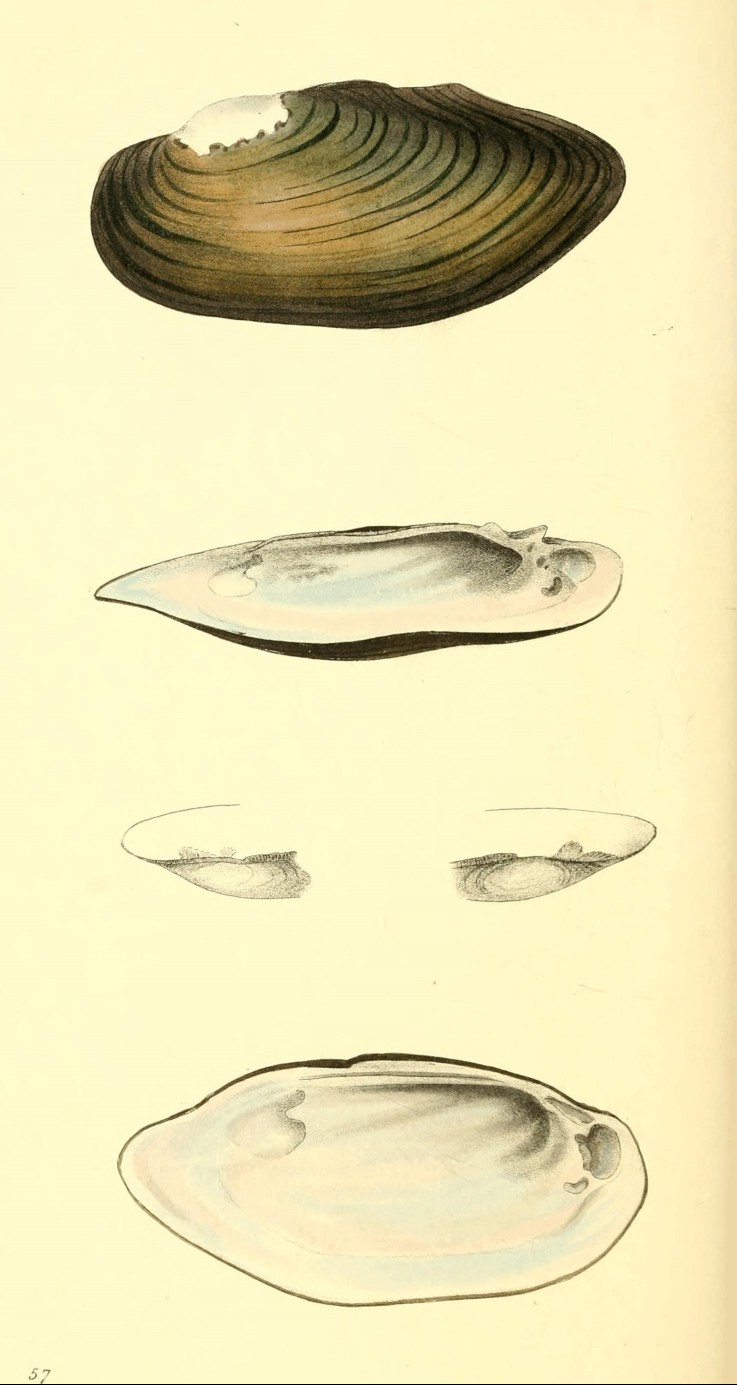
UNIO nasutus.
Rostrated River-Mussel.
Generic Character.
Testa transversa, æquivalvis, non affixa; natibus decorticatis,
suberosis; impressio muscularis postica composita. Dens cardinalis
unicus, brevis, irregularis, simplex aut bipartitus, substriatus; dentes
laterales duo, elongati, compressi, infra pubem producti.
Typus Genericus Mya Pictorum. Linn.
Shell transverse, equivalve, not affixed, the tops decorticated.
Posterior muscular depressions double. Cardinal tooth one, short,
irregular, simple or double, striated; lateral teeth two, elongated,
compressed, and prolonged beneath the corslet.
Generic Type Mya Pictorum. Linn.
Specific Character.
U. (Div. 2.) testâ transversim elongatâ, margine dorsi rectâ,
anticè angulatâ obliquè attenuatâ, extremitate subtruncatâ.Unio (Div. 2.). Shell transversely elongated: dorsal margin straight;
anterior side angulated, obliquely attenuated, the extremity slightly
truncated.Lister, tab. 151. fig. 6.
Unio nasutus. Say in Encycl. Am. Conch. pl. iv. fig.
1.
This is one of the most natural genera in the modern systems of
conchology, as it includes all fresh-water bivalves having two rough
cardinal teeth in one valve and one in the other. The colours of all are
more or less dark-brown, sometimes radiated with green; but the specific
characters rest on the contour of the shell and the proportion of the
teeth.
There can be no doubt this shell is the Unio nasutus of Say,
who refers to the figure of Lister. The Unio nasuta however of
Lamarck I apprehend will be found different, as he seems to think; his
shell also is purple inside with short thick teeth; indeed so much
uncertainty hangs on the shells of this genus, that the species can only
be fixed by ample descriptions and very correct figures. The figure is
from a shell in the Linnæan Society's cabinet. Mr. Say says it is common
in the Delaware River, North America.
Pl. 58
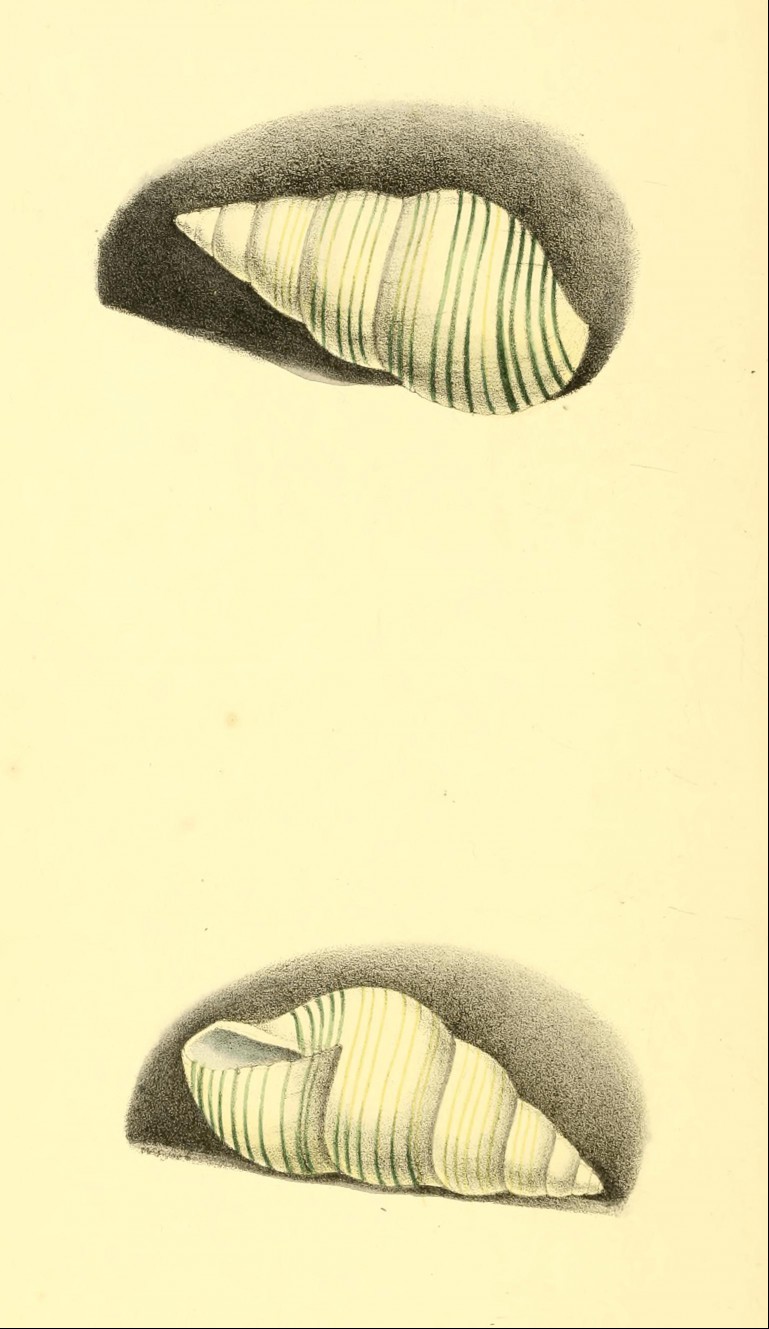
ACHATINA crenata.
Green hair-streaked Achatina.
Generic Character.—See Pl. 30.
Specific Character.
A. (Div. 2.) testâ albâ, fasciis viridibus capillaribus; spirâ
elongatâ, subattenuatâ, anfractibus 6 convexis, labio exteriore crenato;
basi subtruncatâ.Shell white, with capillary green bands; spire elongated,
sub-attenuated, of six convex volutions; outer lip crenated; base
slightly truncate.
A few specimens of this most delicate and beautiful shell were found
by my brother, Mr. J. T. Swainson, jun. in the island of Cuba; nor am I
aware of its having by any other means reached our cabinets, excepting a
distinct variety which occurred in Mrs. Angus's, and is now (together
with a young one of the same) in Mr. Dubois's collection. This has, in
addition to the green bands on the spire, a row of bead-like cinereous
spots at the base of the first and second spiral whorl; and others of a
longitudinal square form on those whorls nearest the tip, which, with the
inner lip, is slightly tinged with pink. The form of the shell also is
shorter; but the general contour, and particularly the crenated mouth,
common to both, clearly proves it can be considered only as a distinct
variety. The specimen we have figured agrees with all those sent at the
same time, in having not the slightest appearance of spots, though in a
perfect state of preservation. The little notches on the margin of the
lip are always placed at the commencement of each of the green lines; the
base of the column is straight, and slightly truncated before it joins
the outer lip.
Pl. 59
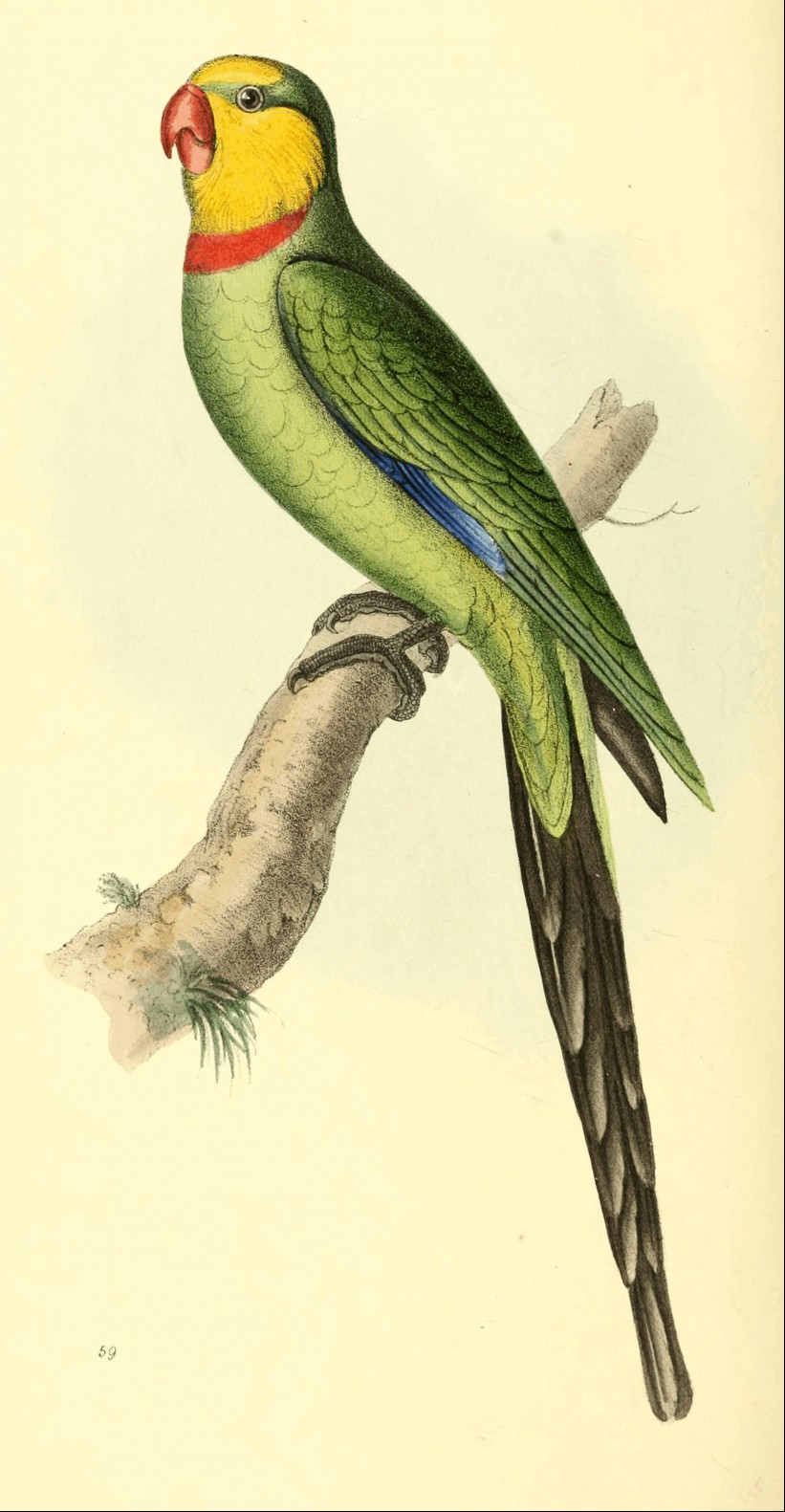
PSITTACUS Barrabandii.
Red-collared Parakeet.
Generic Character.—See Pl. 1.
Specific Character.
P. viridis, sincipite gulâque flavis; torque coccineo circa medium
cervicem extendente; rostro rubro; alis spuriis cærulescentibus.Green, fore-part of the head and throat yellow; round the middle of
the neck in front an orange-red collar; bill red; spurious wings
blueish.
The vast and little known region of New Holland has afforded us some
of the most beautiful birds of this superb family, and among which the
species now, as we believe, for the first time published, will stand
conspicuous. It is from a fine skin in the possession of Mr. Leadbeater,
and is named in honour of the late M. Barraband, the first ornithological
painter that France or any other country has produced.
The tail is very long, measuring eight inches three quarters; the
total length of the bird being near fifteen inches. The green which
predominates over the plumage is bright and changeable, having a blueish
tinge on the hind head, which is much darker and stronger on the outer
margins of the quills and middle of the tail-feathers: the back and
scapulars are tinged with an olive-brown; the spurious quills and their
protecting covers are greenish-blue, appearing in some lights entirely of
the latter colour; the inner margin of the quills and tail, as well as
their entire under surface, deep brownish-black; but the tips of the
tail-feathers beneath are much paler; the two middle feathers five inches
longer than the outermost, and extending near two inches beyond any of
the others; their extremities instead of being pointed are rather widened
and rounded. Bill red; ears and space between the eye and bill green;
fore-part of the head, chin, and half the neck, a clear orange-yellow,
which is terminated by a narrow collar of a beautiful orange-red; the
remaining under plumage pale-green; inner wing-covers darker. Legs black.
The fourth, fifth and sixth quills notched at their tips.
Pl. 60
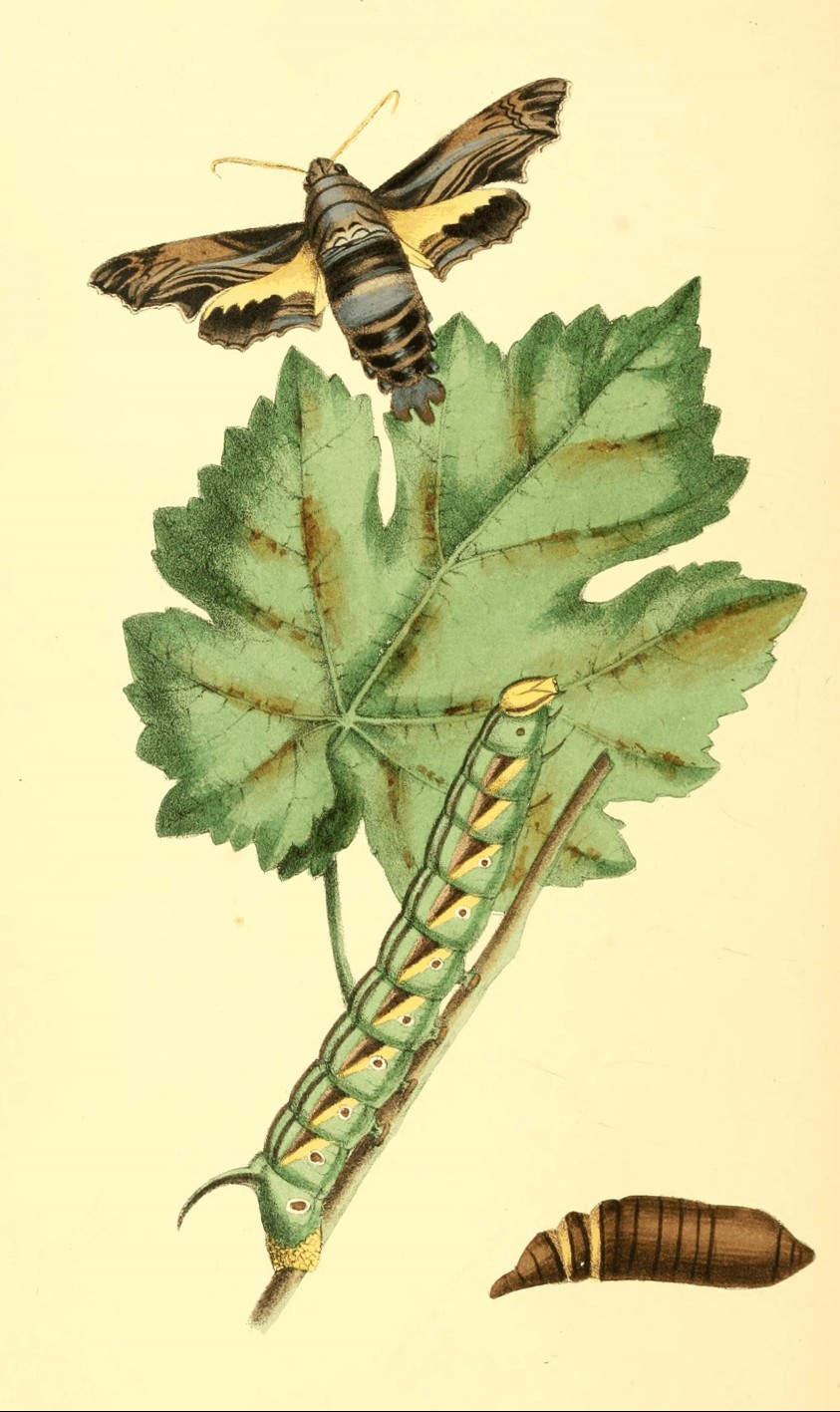
THYREUS Abbottii.
Generic Character.
(Familia Sphingidis Latreille.)
Antennæ lineares, in medio incrassatæ, in maribus extrinsecus
ciliatæ, (sub-barbatæ) in fœminis simplices, filiformes, mucrone
obtuso arcuato sensim terminantes. Palpi breves, obtusi, in utroque sexu
similes. Alæ opacæ, angulatæ. Abdomen crassum, barbatum.Antennæ linear, thickened in the middle, externally ciliated in the
male, simple and filiform in the female, gradually ending in an arcuated,
obtuse hook. Palpi short, obtuse, alike in both sexes. Wings opaque,
angulated. Abdomen thick, bearded.
Specific Character.
T. alis angulatis, anticis testaceis, fusco umbratis et obliquè
lineatis; posticis flavis, margine lato nigro.T. Wings angulated; anterior testaceous, with lineated brown shades
and oblique lines; posterior yellow, with a broad black border.
A lovely insect, which is unfigured, and, as far as we can ascertain,
undescribed by any author. It appertains to the Linnæan genus
Sphinx, which can be viewed (from the immense diversity and great
number of the species) only as a family containing many and striking
natural genera: in modern arrangement it is most nearly allied to the
Sesiæ of Fabricius, from which, as it strikingly differs in the
formation of the palpi and antennæ, I have separated it.
I have named this insect to commemorate the exertions of Mr. Abbott,
well known as having furnished the materials for that beautiful work the
Lepidopterous Insects of Georgia, edited by Sir James Edward Smith. And
from the unpublished drawings of this zealous collector, the larva and
pupa have been figured. Mr. Abbott writes that it is a rare species in
Georgia, and feeds on the grape. The female differs not in colour from
the male, which is here represented.
Pl. 61
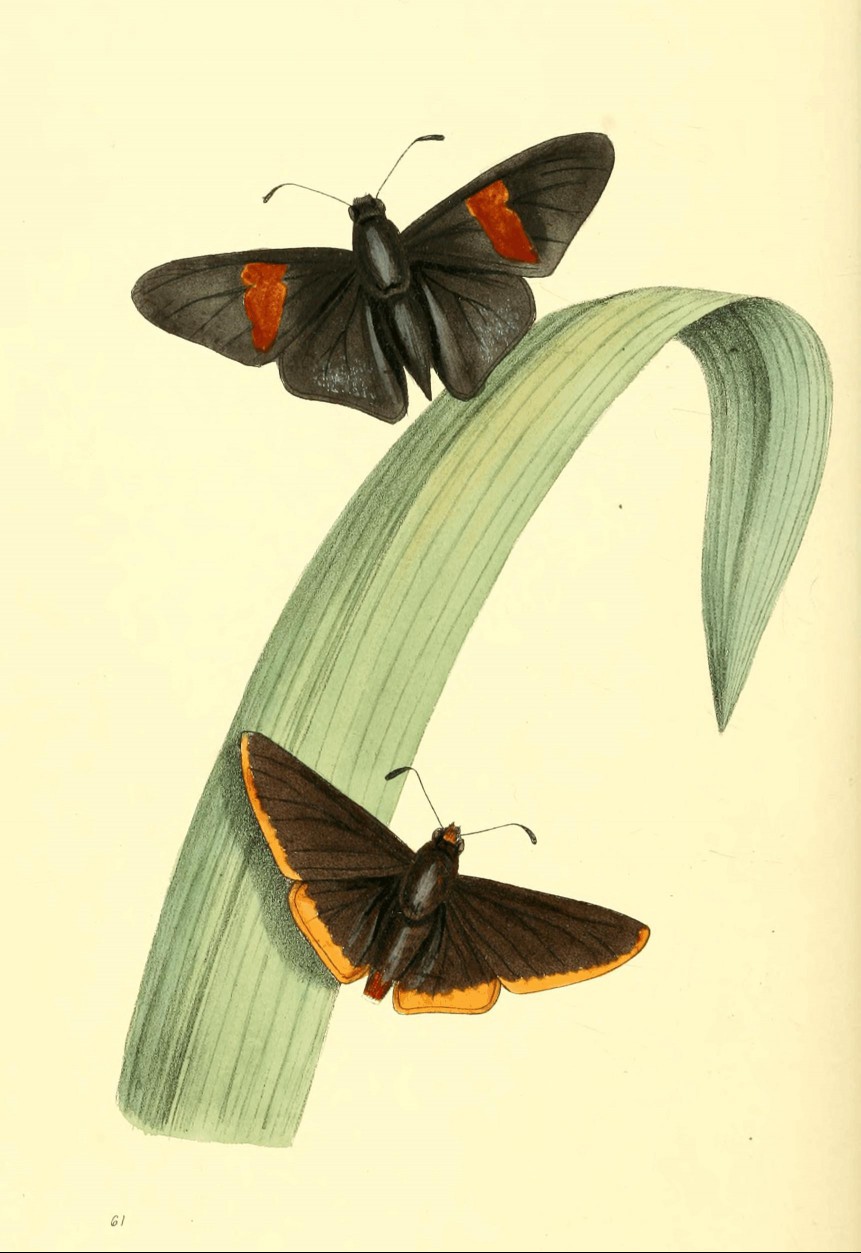
TAMYRIS Nurscia.
Generic Character.—See Pl. 33.
Specific Character.
T. alis nigris, anticis suprà fasciâ centrali rufescente, infrà
punctis duobus ad basim albidis; posticis infrà cæsiis, cinereis, basi
nigris lineâ obsoletâ albidâ; margine nigro.Wings black; anterior above with a central reddish band, and two white
basal dots beneath; posterior beneath grey and cinereous; base black with
an obsolete white line; margin black.
The marginal fringe of the lower wings in this species has a few white
dots between the nerves, and the upper surface is sprinkled or powdered
in the middle with blueish-green atoms; on the under surface of the
anterior wings the lower part of the band is orange, the upper bright
rufous; and within the black margin of the posterior wings is a large
blueish spot, and two or three whitish dots on the sides of the thorax.
It seems nearest allied to Hesp. Celsus of Fabricius, which is
only slightly described from Mr. Jones's unpublished drawings.
TAMYRIS Laonome.—lower figure.
Specific Character.
T. alis utrinque similibus, concoloribus fuscis, margine communi
aurantiacis; capite anoque rubris.Wings in both sexes alike, uniform brown, with a common margin of
orange; head and tail red.
The under surface of this insect (a female) perfectly resembles the
upper: it will approach near to Hesp. Amiatus of Fabricius, which
no doubt belongs to this genus.
For both these interesting insects, not to be found in Fabricius, I am
indebted to the liberality of my friend Professor Klug, Director of the
Royal Museum at Berlin: no note accompanied them, I therefore conclude
they are undescribed, and probably inhabiting South America.
Pl. 62

PSITTACUS discolor.
Red-shouldered Parakeet.
Generic Character.—See Pl. 1.
Specific Character.
P. viridis; fronte, mento, tegminibus inferioribus, maculâ
cervicali, lateribus et scapularibus coccineis; humeris puniceis;
vertice, tegminibus exterioribus remigibusque violaceis; rectricibus
fulvo marginatis.P. Green; front, chin, under wing-covers, and spots in the neck,
flanks and scapulars crimson; shoulders dark-red; crown, external
wing-covers, and lateral tail-feathers violet-blue; quills blueish-black
margined with yellow.P. discolor. Red-shouldered Parakeet. White's Voyage, pl. at p.
263.La Perruche Banks. Le Vaill, pl. 50.
This is another of the splendid little Parakeets inhabiting the
forests of New Holland; and vivid as the colouring may appear in our
figure, it sinks into dullness when compared with the bird itself. Dr.
Shaw was the first who described it in White's Voyage to New South Wales,
where it is badly represented. It has been since figured by Le Vaillant,
probably from a female or imperfect specimen, as the tail is represented
by far too short, and the colours not quite agreeing with that in my
collection.
Total length eleven inches. The upper plumage bright green, tinged
with blue on the sides of the neck, lighter and yellowish beneath; the
crown of the head sapphire or violet-blue, with a crimson belt in front,
and a large patch of the same round the chin; paler spots of this colour
are also in front of the neck, breast, flanks, and under tail-covers; the
under wing-covers are deep crimson, as well as the inner shafts of some
of the lesser covers outside; the shoulders dark blood-colour; the outer
wing-covers deep-blue on the margin of the wings, gradually changing to a
vivid blue, which blends with the green. Quills black glossed with
violet, margined externally and internally with yellow. Tail near five
inches long, the middle feathers dark rufous tipped with blueish; the
rest more or less rufous at the base, and shining blue beyond. Bill and
legs pale.
Pl. 63
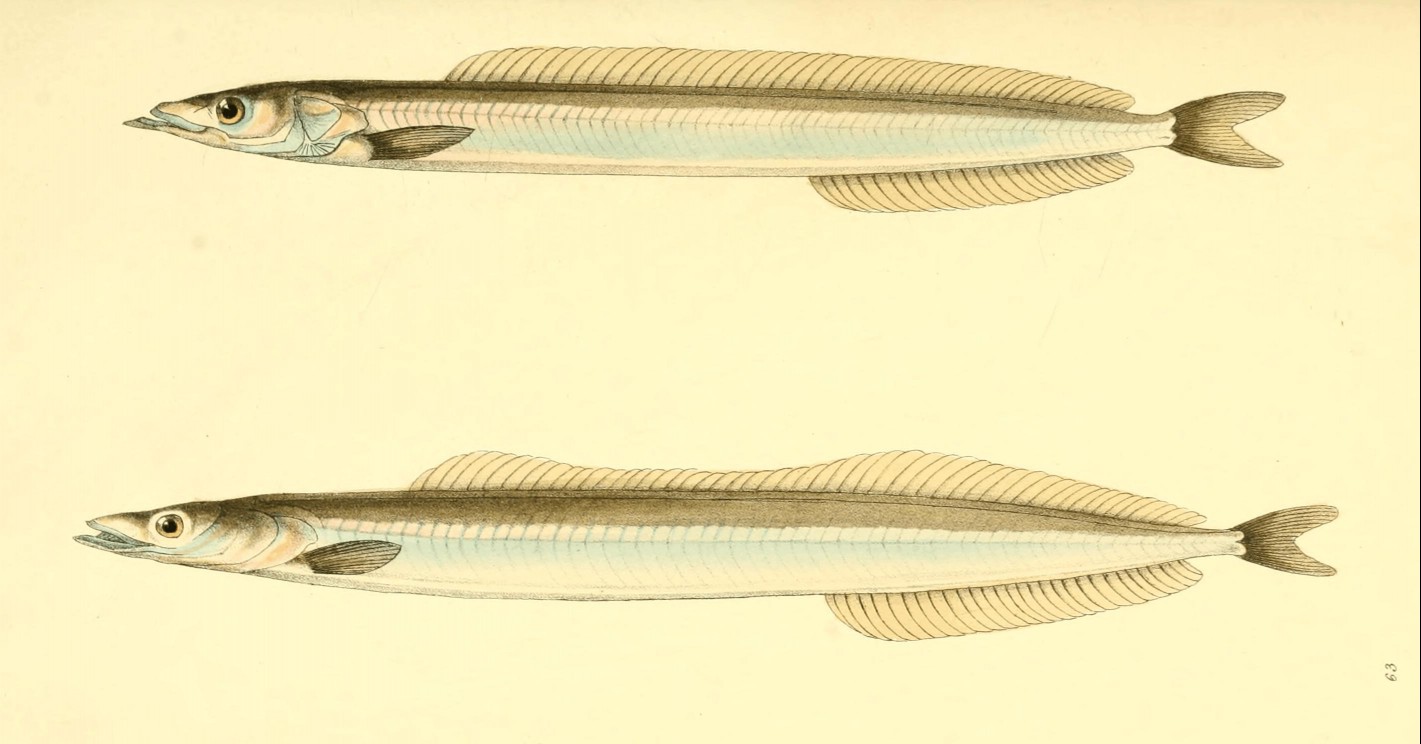
AMMODYTES.
Sand-Lance.
Generic Character.
Corpus gracile, teretiusculum, polyedrum, elongatum, squamis vix
conspicuis. Labium superius duplicatum; mandibula inferior angusta,
acuminata. Membrana branchiostega septem-radiata. Pinna dorsalis corpore
penè æqualis, radiis simplicibus flexilibus.
Typus Genericus Ammodytes Tobianus. Linn.
Body slender, roundish, many-sided, with minute scales. Upper lip
doubled; lower jaw narrow pointed. Gill membrane seven-rayed. Dorsal fin
nearly as long as the body, with simple flexible rays.
Generic Type Sand-Lance. Pennant.
Obs. The Ammodytes cicerelus of my friend
Professor Rafinesque must be different from A. siculus
AMMODYTES Siculus.
Sicilian Sand-Lance.
A. pinnâ dorsali sinuatâ, in medio angustatâ, pone anum
altiore.Dorsal fin sinuated, narrowed in the middle and broadest behind.
Of this genus, hitherto considered as possessing only a unique
example, we were fortunate in discovering while in Sicily the new species
now figured, and which early in the year visit the coasts near Palermo
and Messina in prodigious quantities. There is no striking difference
between this and A. Tobianus, excepting the extraordinary shape of
the dorsal fin, which is invariably undulated and narrowed in the middle.
It never grows to a size exceeding the figure, and is usually much less;
while the British species is often found double the length. Like that,
also, A. Siculus has the lateral line running close to the dorsal
fin; for the fine line in the middle of the side, as Lacepede has well
observed, is that only which connects the muscles. That author likewise
mentions, that the jaws in A. Tobianus have minute teeth, but
these I could never discover. The rays of the fins are, pect. 16; dorsal
56; anal 30.
AMMODYTES Tobianus.
Common Sand-Lance—upper figure.
A. pinnâ dorsali lineari, æquali.
Dorsal fin linear, equal.
Linn. Syst. Nat. vol. i. p. 1145. Pennant iv.
pl. 28. Bloch, pl. 73. 2.Lacepede, ii. 275. Klein Hist. Pisc. fasc. iv.
tab. 12. f. 10.
This, though a very common fish, has been figured by all authors as if
the rays were spined and naked at their extremity; they are, on the
contrary, soft and connected.
It abounds at certain times on many parts of our coasts. The number of
rays stand thus: Pectoral 12; dorsal 51; anal 27.
Pl. 64
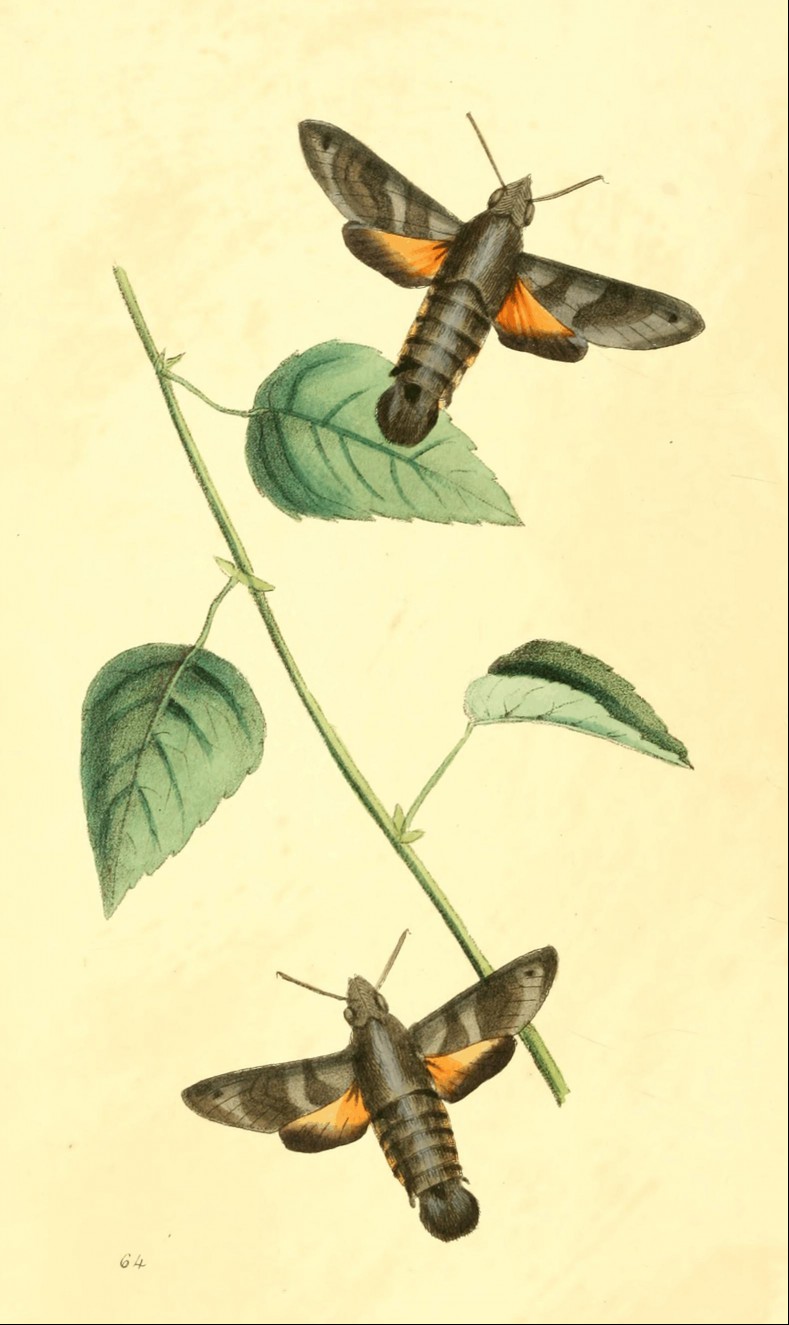
MACROGLOSSUM assimile.
Generic Character.
Antennæ subfusiformes, sursum versus sensim crassescentes, apice
unco brevissimo gracili incurvato abruptè terminato, in maribus
sub-barbatæ, in fœminis simplices et graciliores. Palpi porrecti,
crassi, articulo ultimo acuto. Alæ opacæ, integræ. Abdomen crassum,
barbatum.
Typus Genericus Sphinx stellatarum. Linn.
Antennæ subfusiform, gradually thickest towards the end, the tip
abruptly terminating in a very short slender incurved hook; ciliated in
the male, simple and more slender in the female. Palpi porrected, thick,
the last joint pointed. Wings opaque, entire. Abdomen thick, bearded.
Generic Type Sphinx stellatarum. Linn.
Specific Character.
M. alis suprà fuscis; anticis fasciis duabus obsoletis, puncto
nigrante terminali, posticis in medio, tribus maculisque lateralibus
abdominis aurantiacis.Wings brown; anterior with two darker obscure bands, and a terminal
blackish dot; middle of the posterior wings, and three lateral spots on
the body, orange.
This genus was instituted by Scopoli many years ago, and differs
principally from Sesia by having opaque wings, and from
Thyreus by the very great difference in the construction of their
antennæ. Many exotic species are known, but only one is found in Europe
(Sphinx stellatarum of Linn.), which likewise inhabits our own
country, and to which this our insect is very nearly allied.
Though by no means uncommon in collections, I cannot find this species
either figured or described, nor indeed am acquainted with its locality.
The under figure is of the male; the upper of the female; which differs
only in the wings being rather broader, and in having one segment in the
body less than in the other sex.
Pl. 65
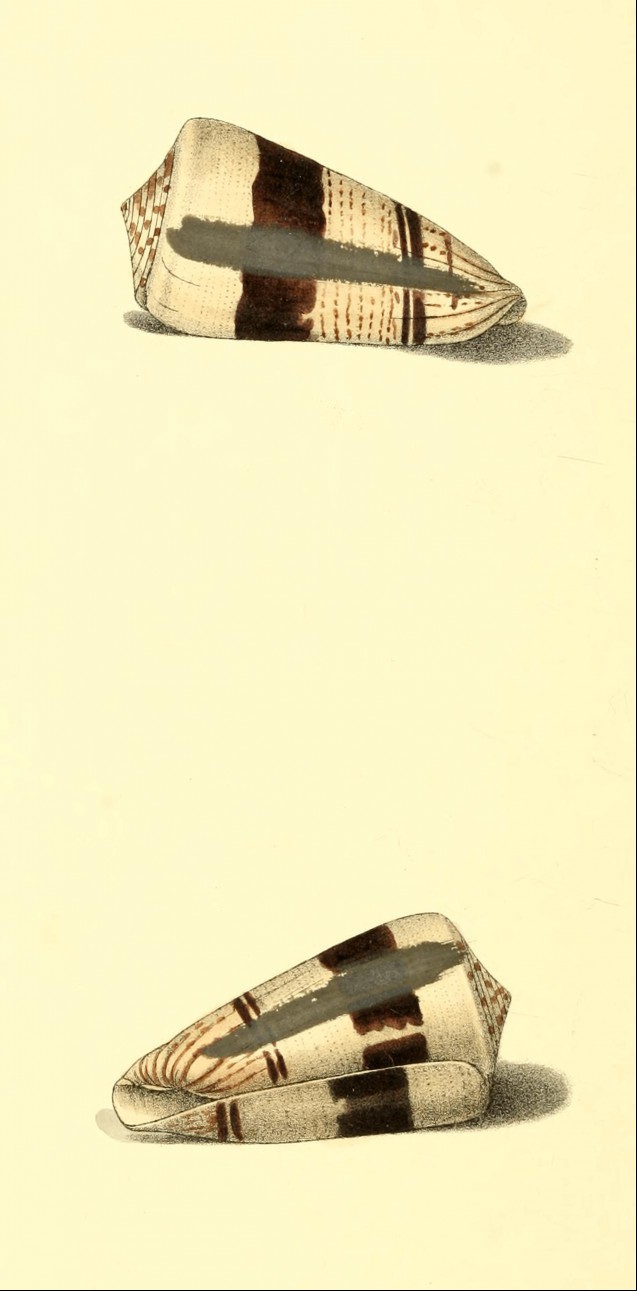
CONUS Augur.
Girdled Cone.
Generic Character.
Testa univalvis, turbinata, s. inversè conica, convoluta; apertura
longitudinalis, angustata, edentata; basi effusa; spira
brevissima.
Typus Genericus Conus marmoratus, &c. Linn.
Shell univalve, turbinated, inversely conic, convolute; aperture
longitudinal, narrow, not toothed; base effuse; spire very short.
Generic Type Conus marmoratus, &c.
Specific Character.
C. testâ glabrâ, fulvo-albidâ, fasciis latis nigro-castaneis,
lineisque transversis punctatis; spirâ obtusâ, convexâ, striatâ,
depressâ.Shell smooth, fulvous-white, with broad dark chesnut bands and
transverse lines of dots; spire obtuse, convex, striated, depressed.C. augur. Lamarck Annal. Mus. xv. 277. Encycl. Méth.
333. 6.Conus magus. Gmelin 3392. 57. Martini ii. 58. 641.
The Girdled Cone is conspicuous among the beautiful shells of this
extensive family, by the broad and rich chesnut bands, which are either
two or three in number, and more or less broken into spots; in
high-coloured shells the minute lines of dots between them are also of
the same colour. It is not a common species, and inhabits the Asiatic
ocean.
This is the Conus Magus of Gmelin and Martini, and of our sale
catalogues: this error has originated from Gmelin having described two
distinct shells, C. Augur and C. Magus, under the latter
name.
I have not referred to Lister's figure 755. 7, being doubtful of its
affinity; and those of Martini and Bruguieres are very bad.
Pl. 66
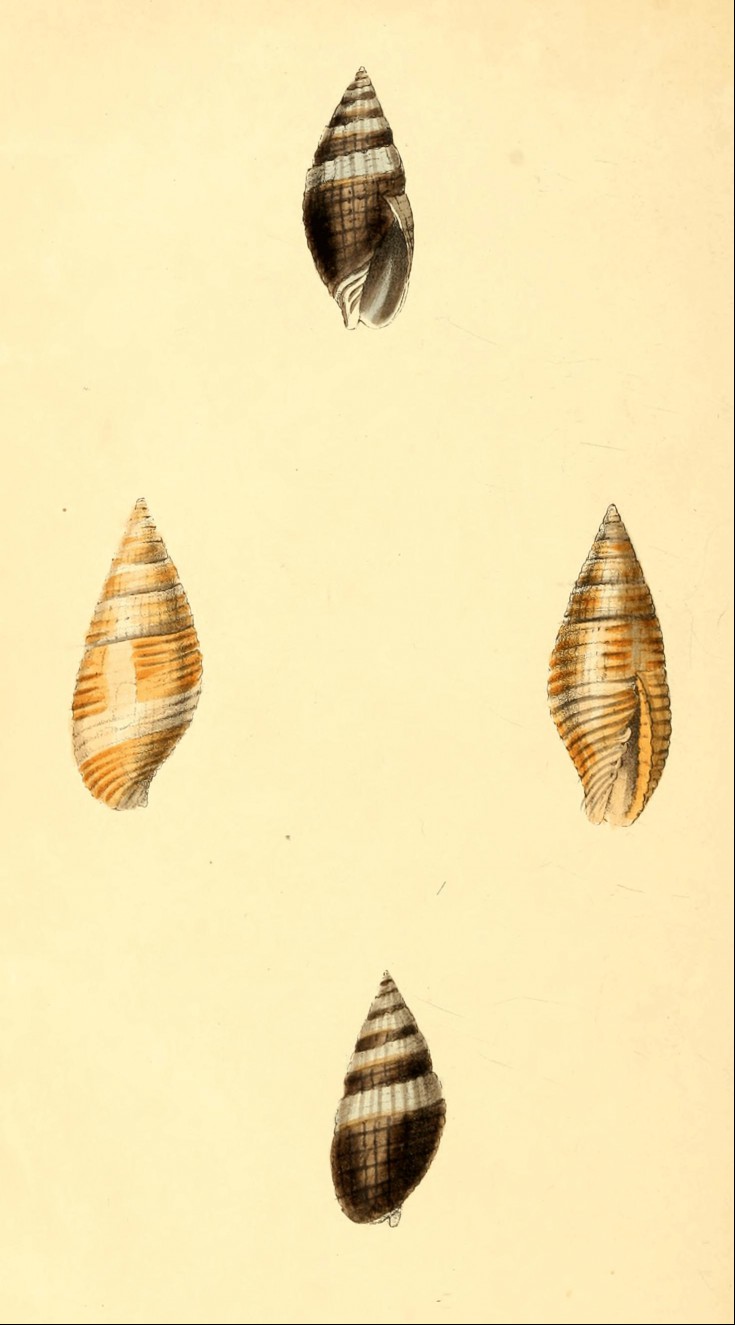
MITRA lugubris.
White-banded Mitre.
Generic Character.—See Pl. 23.
Specific Character.
M. testâ inversè pyriformi, fuscâ; sulcis transversis intus
punctatis; anfractibus supernè obsoletè plicatis, fasciâque albâ ornatis;
labio exteriore tenui, margine crenatâ; columellâ 4-plicatâ; basi albâ,
truncatâ.Shell inversely pear-shaped, brown, with transverse sulcated grooves,
punctured within; volutions above obsoletely plaited and banded with
white; outer-lip thin, margin crenated; pillar four-plaited; base white,
truncated.
We have had much difficulty in the investigation of this species: for
its characters cannot be reconciled with any of those contained in
Lamarck's Monograph of the genus in the Annales du Museum. With
regard to the unnamed figures in the old authors, it bears the closest
resemblance to that of Gualtieri, tab. 32. G, which Lamarck quotes
for his M. crocata; but then his description is not at all
applicable to our shell; and Mr. Dillwyn's synonyms of the Linnean V.
nodulosa (where he has also included M. crocata), we are
satisfied comprises two or even three distinct shells.
This was named by Dr. Solander from the specimen in Mr. G. Humphrys's
collection here figured: it is exceedingly rare, and its locality
unknown. In form it resembles a Buccinum; the transverse grooves
are broad, strongly defined, and have large and deep excavated dots
within them; the upper part of each whorl has an appearance of irregular
plaits, which makes the suture uneven, and takes off something from the
smoothness of the lower part of the whorls, but the shell is in no way
granulated.
MITRA ferruginea.
Thick-lipped Mitre.
Specific Character.
M. testâ nubilâ, maculisque ferrugineis interstinctâ; costis
transversis, elevatis; labio exteriore crasso, obtusè crenato; columellâ
4-plicatâ.Shell clouded and spotted with ferrugineous, with transverse elevated
ribs; outer lip thick, obtusely crenated; pillar four-plaited.M. ferruginea. Lam. Ann. du Mus. vol. 17. p. 200.
Young. Vol. vitulina. Dill. 553.—Martini 4.
149. 1380 & 1.Variety more elongated. Vol. abbatis. Dill. 557.
Chemnitz 11. t. 177. 1709 & 10.
This (a common shell) can be no other than the M. ferruginea of
Lamarck, though neither that author nor any other has noticed its primary
distinguishing character, that of the uncommon thickness of the outer lip
at the margin, which is also divided into convex obtuse crenations; in
young shells this is not apparent; such is Martini's figure. Mr. Dillwyn
has changed Lamarck's name to Vitulina for this, and given the
name of Abbatis to the variety more lengthened, figured by
Chemnitz; but which, from specimens now before us, we consider with
Lamarck only as a variety, possessing all the essential characters here
given to both.
GENERAL INDEX
TO
VOL. I.
IN THE ORDER OF PUBLICATION.
| Pl. | Pl. | ||
| Psittacus Cayennensis | 1 | Parakeet, Cayenne gold-winged | 1 |
| Sitta frontalis | 2 | Blue Nuthatch | 2 |
| Mitra zonata | 3 | Zoned Mitre | 3 |
| Bulimus melastomus | 4 | Black-mouthed Bulimus | 4 |
| Colias Statira | 5 | Colias Statira | 5 |
| Leachiana | 6 | Leach's Colias | 6 |
| Carduelis cucullata | 7 | Hooded Seed-eater | 7 |
| Merops urica | 8 | Javanese Bee-eater | 8 |
| Helix auriculata | 9 | Eared Helix | 9 |
| Strombus minimus | 10 | Little Strombus | 10 |
| variabilis | ib. | Variable do. | ib. |
| Drusilla Horsfieldii | 11 | Drusilla Horsfieldii | 11 |
| Gobius Suerii | 12 | Suerian Goby | 12 |
| Platyrhynchus Ceylonensis | 13 | Ceylonese Flatbill | 13 |
| Picus rubiginosus | 14 | Brown Woodpecker | 14 |
| Licinia Melite | 15 | Licinia Melite | 15 |
| Ismene Œdipodea | 16 | Ismene Œdipodea | 16 |
| Bulimus zonatus | 17 | Zoned Bulimus | 17 |
| Mitra contracta | 18 | Contracted Mitre | 18 |
| australis | ib. | Southern do. | ib. |
| Tinamus Tataupa | 19 | Tataupa Tinamau | 19 |
| Picus Braziliensis | 20 | Brazilian Woodpecker | 20 |
| Procnias hirundacea | 21 | Swallow Berry-eater | 21 |
| Terias Elvina | 22 | Terias Elvina | 22 |
| Mitra vittata | 23 | Ribbon Mitre | 23 |
| Conœlix marmoratus | 24 | Marbled Conœlix | 24 |
| lineatus | ib. | Lineated do. | ib. |
| punctatus | ib. | Punctured do. | ib. |
| Procnias Melanocephalus | 25 | Black-headed Berry-eater | 25 |
| Alcedo azurea | 26 | Azure Kingsfisher | 26 |
| Halcyon collaris | 27 | Collared Crab-eater | 27 |
| Hesperia Haworthiana | 28 | Haworth's Hesperia | 28 |
| Mitra cancellata | 29 | Contracted Mitre | 29 |
| rigida | ib. | Ribbed do. | ib. |
| Achatina marginata | 30 | Marginated Achatina | 30 |
| Phibalura cristata | 31 | Crested Shortbill | 31 |
| Psaris Cuvierii | 32 | Cuvier's Psaris | 32 |
| Tamyris Zeleucus | 33 | Tamyris Zeleucus | 33 |
| Colias Godartiana | 34 | Godart's Colias | 34 |
| Mitra bifasciata | 35 | Double-banded Mitre | 35 |
| Achatina perversa | 36 | Reverse Achatina | 36 |
| Procnias cucullata | 37 | Hooded Berry-eater | 37 |
| Picus bicolor | 38 | Black-and-white Woodpecker | 38 |
| Hesperia Itea | 39 | Hesperia Itea | 39 |
| Cynisca | 40 | Cynisca | 40 |
| Achatina pallida | 41 | Pale Achatina | 41 |
| Oliva Braziliana | 42 | Brazilian Olive | 42 |
| Melliphaga auricomis | 43 | Yellow-tufted Honeysucker | 43 |
| Pteroglossus sulcatus | 44 | Groove-billed Aracari | 44 |
| Ramphastos carinatus | 45 | Carinated Toucan | 45 |
| Bulimus citrinus | 46 | Citron Bulimus | 46 |
| citrinus, var. | 47 | Reverse-banded do. | 47 |
| aureus | ib. | Golden do. | ib. |
| Mitra casta | 48 | Chesnut-banded Mitre | 48 |
| Oxyrhynchus cristatus | 49 | Crested Shortbill | 49 |
| Alcedo Asiatica | 50 | Asiatic Kingsfisher | 50 |
| Colias Pyrene | 51 | White African Colias | 51 |
| Argante | 52 | Orange Colias | 52 |
| Strombus cylindricus | 53 | False scarlet Strombus | 53 |
| Persicus | ib. | Persian do. | ib. |
| Mitra lyræformis | 54 | Harp Mitre | 54 |
| Solen ambiguus | 55 | Ambiguous Solen | 55 |
| Ramphastos vitellinus | 56 | Sulphur-and-white Toucan | 56 |
| Unio nasutus | 57 | Rostrated River Mussel | 57 |
| Achatina crenata | 58 | Green hair-streaked Achatina | 58 |
| Psittacus Barrabandii | 59 | Red-collared Parakeet | 59 |
| Thyreus Abbottii | 60 | Thyreus Abbottii | 60 |
| Tamyris Nurscia | 61 | Tamyris Nurscia | 61 |
| Laonome | ib. | Laonome | 61 |
| Psittacus discolor | 62 | Red-shouldered Parakeet | 62 |
| Ammodytes Tobianus | 63 | Common Sandlance | 63 |
| Siculus | ib. | Sicilian Sandlance | ib. |
| Macroglossum assimile | 64 | Macroglossum assimile | 64 |
| Conus Augur | 65 | Girdled Cone | 65 |
| Mitra lugubris | 66 | White-banded Mitre | 66 |
| ferruginea | ib. | Thick-lipped Mitre | ib. |
GENERAL ALPHABETIC INDEX
OF
LATIN AND ENGLISH NAMES
TO
VOLUME I.
| Pl. | Pl. | ||
| Achatina, Gen. Char. | 30 | Mitra lugubris | 66 |
| crenata | 58 | lyræformis | 54 |
| marginata | 30 | olivæformis | 48 |
| pallida | 41 | rigida | 29 |
| perversa | 36 | vittata | 23 |
| green hair-streaked | 58 | zonata | 3 |
| marginated | 30 | Mitre, contracted | 18 |
| pale | 41 | cancellated | 29 |
| reverse | 36 | chesnut-banded | 48 |
| Alcedo, Gen. Char. | 26 | double do. | 35 |
| Asiatica | 50 | Harp | 54 |
| azurea | 26 | olive-shaped | 48 |
| Ammodytes, Gen. Char. | 63 | ribbed | 29 |
| Tobianus | ib. | ribbon | 23 |
| Siculus | ib. | southern | 18 |
| Aracari, Grooved-bill | 44 | thick-lipped | 66 |
| Bee-eater, Javanese | 8 | white-banded | ib. |
| Berry-eater, black-headed | 25 | zoned | 3 |
| hooded | 37 | Mussel, rostrated, River | 57 |
| Swallow | 21 | Nuthatch, blue | 2 |
| Bulimus, Gen. Char. | 4 | Oliva, Gen. Char. | 42 |
| aureus | 47 | Braziliana | ib. |
| citrinus | 46 | Olive, Brazilian | ib. |
| citrinus, var. | 47 | Oxyrhynchus, Gen. Char. | 49 |
| melastomus | 4 | cristatus | ib. |
| zonatus | 17 | Parakeet, Cayenne gold winged | 1 |
| black-mouthed | 4 | red-shouldered | 62 |
| Citron | 46 | red-collared | 59 |
| reverse-banded do. | 47 | Phibalura, Gen. Char. | 31 |
| golden | ib. | cristata | ib. |
| zoned | 17 | Picus, Gen. Char. | 14 |
| Carduelis, Gen. Char. | 7 | Braziliensis | 20 |
| cucullata | 7 | bicolor | 38 |
| Colias, Gen. Char. | 5 | rubiginosus | 14 |
| Argante | 52 | Platyrhynchus, Gen. Char. | 13 |
| Godartiana | 34 | Ceylonensis | ib. |
| Leachiana | 6 | Procnias, Gen. Char. | 21 |
| Pyrene | 51 | cucullata | 37 |
| Statira | 5 | hirundacea | 21 |
| Godart's | 34 | Melanocephalus | 25 |
| Leach's | 6 | Psaris, Gen. Char. | 32 |
| orange | 52 | Cuvierii | ib. |
| white African | 51 | Cuvier's | ib. |
| Cone, girdled | 65 | Psittacus, Gen. Char. | 1 |
| Conus, Gen. Char. | ib. | Cayennensis | ib. |
| Augur | ib. | Barrabandii | 59 |
| Conœlix, Gen. Char. | 24 | discolor | 62 |
| lineatus | ib. | Pteroglossus, Gen. Char. | 44 |
| marmoratus | ib. | sulcatus | ib. |
| punctatus | ib. | Ramphastos, Gen. Char. | 45 |
| lineated | ib. | carinatus | ib. |
| marbled | ib. | vitellinus | 56 |
| punctured | ib. | Sand-lance, common | 63 |
| Crab-eater, collared | 27 | Sicilian | ib. |
| Drusilla, Gen. Char. | 11 | Seed-eater, hooded | 7 |
| Horsfieldii | ib. | Sharp-bill, crested | 49 |
| Flatbill, Ceylonese | 13 | Short-bill, crested | 31 |
| Gobius, Gen. Char. | 12 | Sitta, Gen. Char. | 2 |
| Suerii | ib. | frontalis | ib. |
| Goby, Suerian | ib. | Solen, Gen. Char. | 55 |
| Halcyon, Gen. Char. | 27 | ambiguus | ib. |
| collaris | ib. | ambiguous | ib. |
| Helix, Gen. Char. | 9 | Strombus, Gen. Char. | 10 |
| auriculata | ib. | cylindricus | 53 |
| eared | ib. | minimus | 10 |
| Hesperia, Gen. Char. | 28 | Persicus | 53 |
| Cynisca | 40 | variabilis | 10 |
| Haworthiana | 28 | little | 10 |
| Itea | 39 | false scarlet | 53 |
| Haworth's | 28 | Persian | ib. |
| Honeysucker, yellow-tufted | 43 | variable | 10 |
| Ismene Œdipodea | 16 | Tamyris, Gen. Char. | 33 |
| Kingsfisher, Asiatic | 50 | Laonome | 61 |
| azure | 26 | Nurscia | 61 |
| Licinia, Gen. Char. | 15 | Zeleucus | 33 |
| melite | ib. | Terias, Gen. Char. | 22 |
| Macroglossum, Gen. Char. | 64 | Elvina | ib. |
| assimile | ib. | Thyreus, Gen. Char. | 60 |
| Melliphaga, Gen. Char. | 43 | Abbottii | ib. |
| auricomis | ib. | Tinamus, Gen. Char. | 19 |
| Merops, Gen. Char. | 8 | Tataupa | ib. |
| urica | ib. | Tinamou Tataupa | ib. |
| Mitra, Gen. Char. | 3, 23 | Toucan, carinated | 45 |
| australis | 18 | sulphur-and-white | 56 |
| bifasciata | 35 | Unio, Gen. Char. | 57 |
| cancellata | 29 | nasutus | ib. |
| casta | 48 | Woodpecker, brown | 14 |
| contracta | 18 | black-and-white | 38 |
| ferruginea | 66 | Brazilian | 20 |
SYSTEMATIC INDEX.
VERTEBROSA.
PART I.
ORNITHOLOGY.
| Pl. | |
| Psaris Cuvierii | 32 |
| Procnias hirundacea | 21 |
| melanocephalus | 25 |
| cucullata | 37 |
| Phibalura cristata | 31 |
| Platyrhynchus Ceylonensis | 13 |
| Carduelis cucullata | 7 |
| Pteroglossus sulcatus | 44 |
| Ramphastos carinatus | 45 |
| vitellinus | 56 |
| Psittacus Cayennensis | 1 |
| Barrabandii | 59 |
| discolor | 62 |
| Sitta frontalis | 2 |
| Picus rubiginosus | 14 |
| Braziliensis | 20 |
| bicolor | 38 |
| Oxyrhyncus cristatus | 49 |
| Meliphaga auricomis | 43 |
| Merops urica | 8 |
| Alcedo azurea | 26 |
| Asiatica | 50 |
| Halcyon collaris | 27 |
| Tinamus Tataupa | 19 |
ICHTHYOLOGY.
| Gobius Suerii | 12 |
| Ammodytes Tobianus | 63 |
| Siculus | ib. |
SYSTEMATIC INDEX.
ENTOMOLOGY.
PART I.
DIURNES.
| Pl. | |
| Colias Statira | 5 |
| Leachiana | 6 |
| Godartiana | 34 |
| Pyrene | 51 |
| Argante | 52 |
| Licinia Melite | 15 |
| Terias Elvina | 22 |
| Drusilla Horsfieldii | 11 |
| Hesperia Haworthiana | 28 |
| Itea | 39 |
| cynisca | 40 |
| Tamyris Zeleucus | 33 |
| Nurscia | 61 |
| Laonome | ib. |
| Ismene Œdipodia | 16 |
CREPUSCULARES.
| Thyreus Abbottii | 60 |
| Macroglossum assimile | 64 |
SYSTEMATIC INDEX.
CONCHOLOGY.
PART I.
GASTEROPODES (Univalves).
| Pl. | |
| Helix auriculata | 9 |
| Bulimus melastomus | 4 |
| zonatus | 17 |
| citrinus | 46 |
| do. var. | 47 |
| aureus | ib. |
| Achatina marginata | 30 |
| perversa | 36 |
| pallida | 41 |
| crenata | 58 |
| Oliva Braziliana | 42 |
| Conus Augur | 65 |
| Conœlix marmoratus | 24 |
| lineatus | ib. |
| punctatus | ib. |
| Mitra zonata | 3 |
| contracta | 18 |
| Australis | ib. |
| vittata | 23 |
| cancellata | 29 |
| rigida | ib. |
| bifasciata | 35 |
| casta | 48 |
| olivæformis | ib. |
| lyræformis | 54 |
| lugubris | 66 |
| ferruginea | ib. |
| Strombus minimus | 10 |
| variabilis | ib. |
| cylindricus | 53 |
| Persicus | ib. |
ACÉPHALES (Bivalves).
| Unio nasutus | 57 |
| Solen ambiguus | 55 |
ADDENDA ET CORRIGENDA.
| Pl. 2. | line 6, | for Setaceisi numbentibus read setaceis incumbentibus. |
| 4, | between postico and interior insert digitus. | |
| for minor read minimus. | ||
| 6, | for "postico maximo" read "posticus maximus." | |
| 17, | for aures lilacinæ read auribus lilacinis. | |
| erase Orthorynchus frontalis, Horsfield in Linn. Trans. | ||
| second side line 10, cancel. | ||
| — 5. | — 4, | for nudam et truncatam read nudum et truncatum. |
| — 7. | — 6, | for utrinsecus read utrinque. |
| 6 | from the bottom, for dulleron read duller on. | |
| 3 | from the bottom, for oi read on. | |
| 14, | between tectrices and remigibus insert a comma. | |
| — 8. | — 6, | for Horsfeild read Horsfield, and wherever this occurs. |
| — 11. | — 5, | for articulis read articulos. |
| second side, 10 lines from the bottom, for Hipparchiæ read Hipparchidæ. | ||
| — 13. | — 16, | for claws read toes. |
| — 17. | — 6, | for basilari read basali. |
| — 20. | Add to the synonyms. P. Braziliensis, Swains. in Wern. Trans. 3. p. 291. | |
| — 21. | Obs. MM. Temminck and Lagier had just before us, and without our knowledge, published this bird under the name of Procnias Ventralis, (Pl. 5.) by which name in right of priority it should stand in the system. | |
| — 25. | for Fruit-eater read Berry-eater. | |
| — 27. | — 6, | for inferiorum read inferiorem. |
| — 31. | — 18, | for variegato read variegatâ. |
| after furcata dele the comma. | ||
| 19, | after chalybeis insert a comma. | |
| — 32. | — 6, | for adunca read adunco. |
| — 33. | — 1, | Add to the synonyms Hesp. Zeleucus. Obs. Donovan's Indian Insects, where that author has figured it by mistake as a native of India. |
| — 35. | Add to the synonyms, Seba Pl. 49. fig. 21, 22, 41. | |
| — 36. | for Achatinia read Achatina. | |
| — 6 and 7, for columella margine read columella margineque. | ||
| — 41. | Obs. another specimen of A. pallida quite agreeing with this, is in Mr. Dubois' cabinet. | |
| — 42. | — 6, | for base read basi. |
| next page, line 12, dele "and Cimbium (Melons)". | ||
| — 45. | — 4, | after maxillæ insert angulo. |
| — 46. | in the Latin specific character for "basi rotundato" read "basi subcontracto," and in the English for "rounded" read "slightly contracted at the base." | |
| — 46. | — 3, | on the back page for Broederip read Broderip. |
| — 47. | Obs. Bulimus aureus, in Mr. Spurrett's valuable cabinet is another specimen of this shell minutely agreeing with that here described. | |
| — 49. | — 6, | for supr arotundatâ read supra rotundatâ. |
| — 50. | Obs. This bird Dr. Horsfield tells me is his Alcedo meninting described in the Linn. Transactions. | |
| — 53. | 2d line from the bottom, for where read were. | |
| — 63. | Obs. The Ammodytes cicerelus of my friend Professor Rafinesque must be different from A. siculus, as he makes no mention in his figure or description of the peculiarity of the dorsal fin. | |
| — 64. | for M. assimilis read M. assimile. | |
NOTES
[1] Horæ Entomologicæ, by W.
S. MacLeay, Esq. M.A. of Trinity College, Cambridge. London, 1819. A work
which for acuteness of reasoning and profound research, has never been
equalled either in this, or perhaps in any other country.
[2] It is truly grievous in those
which are privileged to possess themselves of the works of their
countrymen, however expensive, at free cost, and thus to inflict a
ruinous fine on authors. Thus—National Institutions, founded for
the encouragement of learning, are made to oppress and impoverish its
followers.
[3] Were it necessary at this time of
day to point out the unnatural separation of shells intimately connected
with each other, which the Linnæan arrangement presents, it would be
sufficient to observe, that the genus Bulimus is formed of shells
scattered in the old genera of Turbo, Helix, and
Bulla: thus we see in Mr. Dillwyn's Catalogue, the large
pink-mouthed African land-snail put in the same genus with our English
Bulla lignaria, and aperta; the one inhabiting the depths
of forests, and the others the depths of ocean!
Featured Books

A New Subspecies of Bat (Myotis velifer) from Southeastern California and Arizona
Terry A. Vaughan
r, Jour. Mamm.,20:226, May 14, 1939). West of the Rocky Mountains the species is knownto occur also ...

A New Species of Heteromyid Rodent from the Middle Oligocene of Northeast Colorado with Remarks on the Skull
Edwin C. Galbreath
ures in orbital area. ALS, alisphenoid. FR, frontal.MAX, maxillary. OS, orbitosphenoid. PAL, palatin...

Mr. Standfast
John Buchan
of the window of a first-classcarriage, the next in a local motor-car following the course of a tro...

Up in the Clouds: Balloon Voyages
R. M. Ballantyne
es. Fortunately, however, such ambitious efforts have seldom been made except by the intellectually ...

The Ocean and Its Wonders
R. M. Ballantyne
deeds of daring, blood, villainy, heroism, and enterprise. But with this portion of its story we ha...

Planet of the Damned
Harry Harrison
DAMNEDA Bantam Book / published January 1962New Bantam edition published February 1971All rights res...

Curiosities of the Sky
Garrett Putman Serviss
’ comet Brooks’ comet Curious forms of meteorite trains Section of the atmosphere up to 100 kilo...

Two Timer
Fredric Brown
owactivate the mechanism—byplacing the cube on the platform—atexactly three o'clock. Therefore,t...
Browse by Category
Join Our Literary Community
Subscribe to our newsletter for exclusive book recommendations, author interviews, and upcoming releases.

Comments on "Zoological Illustrations, Volume 1" :